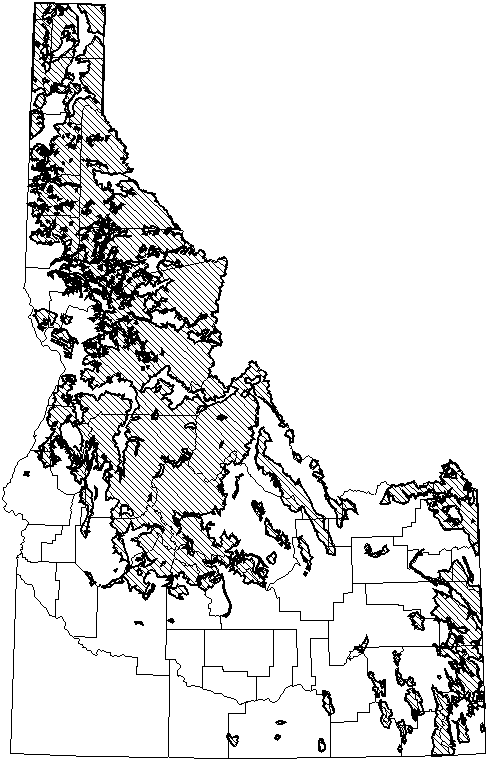
Sorex cinereus
(Masked Shrew)
Order: Insectivora
Order Description: Insectivores
Family: Soricidae
Family Description: Shrew
Range:
Occurs from Alaska/Canadian Arctic tundra through Rockies, northern Great Plains, and Appalachians.
Description:
The masked shrew's head and neck are evenly grayish to brown above and paler underneath. Its tail is fairly long and bicolored. Total length is 3.5 to 4.4 inches (87-110 mm), tail length is 1.4 to 1.6 inches (35 to 40 mm), its weight is only 0.10 to 0.20 ounce (3-6 grams).
Habitat:
It seems to prefer coniferous forests and moist habitat along streams and ponds. Thick leaf litter in damp forests may also represent favored habitat, although the species appears adaptable to major successional disturbances. In Idaho, it can be found in both wet and dry coniferous forests, and even occasionally in sagebrush. In Wyoming they have been found from 3800 to 9450 feet.
Diet:
They eat insects and other invertebrates, carrion, small vertebrates, and, occasionally, seeds. They consume their own weight in food each day.
Ecology:
This species remains active throughout day (and year) to secure enough food to maintain a high metabolic rate. They may use echolocation to detect prey. Its peak activity period occurs from 0100-0200 hr. One study found that activity seemed to correspond to weather, increasing when the temperature of the previous night increased and decreasing when the temperature decreased. There is a big surge in activity immediately after rain, especially if it occurs between 6:00 pm and midnight. Their population size is subject to large annual fluctuations. Density estimates range from 1 to 12 shrews per 0.4 ha.(1 acre). Home range is about 0.04 ha (0.1 ac). They are usually found in scattered, locally abundant populations. Individuals rarely live past second summer.
Reproduction:
Breeding season may last from March-September (in Nova Scotia, evidence of mid-winter births exists for at least some years). Females produce 2 to 3 litters. Gestation lasts 18 days. Litter size varies from 2 to 10 young, but averages 7. Young are weaned in 3 weeks, and reach sexual maturity in 20 to 26 weeks.
Conservation:
| Status: | Unprotected nongame species |
|
Global Rank: |
G5 |
|
State Rank: |
S4 |
Important State References:
Rickard, W.H. 1960. The distribution of small mammals in relation to climax vegetation mosaic in eastern Washington and northern Idaho. Ecology 41: 99-106
Information written by Donald Streubel,© 2000
Map image provided by Stephen Burton,© 2000
Design by Ean Harker©1999, 2000.
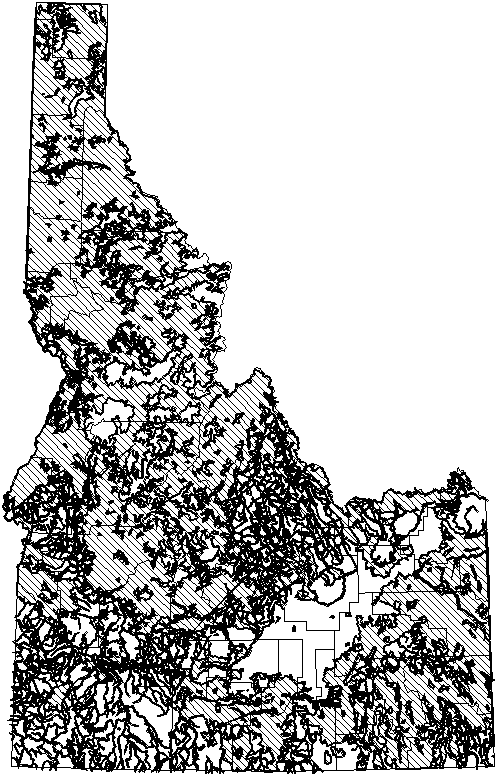
Sorex vagrans
(Vagrant Shrew)
Order: Insectivora
Family: Soricidae
Family Description: Shrew
Range:
The vagrant shrew is very widely distributed in western North America, from Columbian Plateau, Snake River Plains, and northern Great Basin, west to the Pacific Ocean, and east to the Continental Divide. It has recently been found east of the Continental Divide in southwestern Alberta.
Description:
The vagrant shrew is medium sized; it appears reddish in summer, darker in the winter, and like some other shrews, its tail is bicolored. Total length is 3.7 to 4.8 inches (95 to 119 mm), tail length is 1.25 to 2 inches (34-51 mm), and it weighs 0.12 to 0.36 ounce (3-8.5 g).
Habitat:
It is found in a wide variety of habitats such as forests, meadows, and riparian situations, but it is often found in more arid areas including sagebrush steppe.
Diet:
Feeds primarily on forest insects (eggs, larvae, pupae, and adults), slugs, and earthworms. It may feed occasionally on salamanders and other small vertebrates.
Ecology:
Like all shrews, it is active all year, and mostly at night. diurnal activity increases in the spring. In a southern British Columbia study, mean home range was estimated at 1039 m2 for nonbreeding, and 3258 m2 for breeding individuals. In an old field community in western Washington, annual crude density was estimated at 36.6 shrews per ha (2.5 ac).
Reproduction:
Breeding may occur from March to September, but most activity occurs in the spring, between March and May. Litter size varies from 2 to 9 young (average 5.2). Gestation lasts approximately 20 days.
Conservation:
| Status: | Unprotected nongame species |
|
Global Rank: |
G5 |
|
State Rank: |
S4 |
Important State References:
Rickard, W.H. 1960. The distribution of small mammals in relation to climax vegetation mosaic in eastern Washington and northern Idaho. Ecology 41: 99-106.
Information written by Donald Streubel,© 2000
Map image provided by Stephen Burton,© 2000
Design by Ean Harker©1999, 2000.
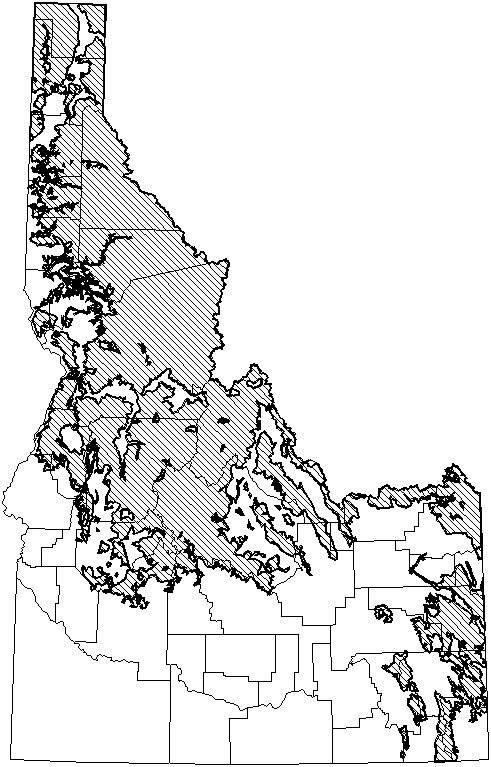
Sorex monticolus
(Dusky Shrew)
Order: Insectivora
Family: Soricidae
Family Description: Shrew
Range:
Dusky shrews are found from Alaska, south through Canada and the western U.S. to Mexico.
Description:
This shrew is rust brown dorsally and lighter below and it has a pointed nose (like all shrews). The tail is not distinctly bi-colored. It is sometimes called the montane shrew, and once was thought to be the same species as the vagrant shrew. All shrews are small; the dusky shrew is 3.7 to 4.7 inches (95 to 119 mm) in total length, its tail is 1.5 to 1.9 inches (39 to 48 mm) and it weighs only 0.25 ounce (7 grams). Accurate identification of this shrew depends on an examination of the teeth in order to differentiate it from several other shrew species.
Habitat:
Found in various habitats, including damp meadows surrounded by coniferous forests, in grass among spruce/fir forests, in mid-elevation fir/larch forests, along streams and rivers in high prairie, on mossy banks of small streams, and in alpine tundra or sphagnum bogs. In Idaho, its distribution is similar to the vagrant shrew, but thought to be less dependent on water. May be present in pinyon-juniper and sagebrush communities in southern Idaho.
Diet:
Feeds primarily on insects and other small invertebrates (worms, sowbugs, mollusks, etc.) Also consumes some vegetable matter.
Ecology:
It is active throughout the year as none of the shrews hibernate. Its mean home range has been estimated at 1227 m2 for non-breeders, and 4020 m2 for breeders. Individuals are apparently not territorial in breeding season, and may move widely. Most individuals probably do not live longer than 18 months. It is possible that the dusky shrew uses echolocation to navigate its environment. Researchers have found that this shrew can discriminate with echolocation, objects as small as 1.5 square inches at a distance of 8 inches. Dependence on echolocation increases in unfamiliar habitat, apparently to help them select suitable cover.
Reproduction:
Breeding season extends from April-August. Average litter size is about 5 young, but may reach 7. Information on reproduction from different parts of range is needed.
Conservation:
|
Status: |
Unprotected nongame species |
|
Global Rank: |
G5 |
|
State Rank: |
S4 |
Important State References:
Groves, C.R. 1994. A preliminary report: effects of timber harvest on small mammals and amphibians inhabiting old-growth coniferous forests on the Clearwater National Forest, Idaho. Idaho Dept. Fish & Game, Boise. 24pp.
Information written by Donald Streubel,© 2000
Map image provided by Stephen Burton,© 2000
Design by Ean Harker©1999, 2000.
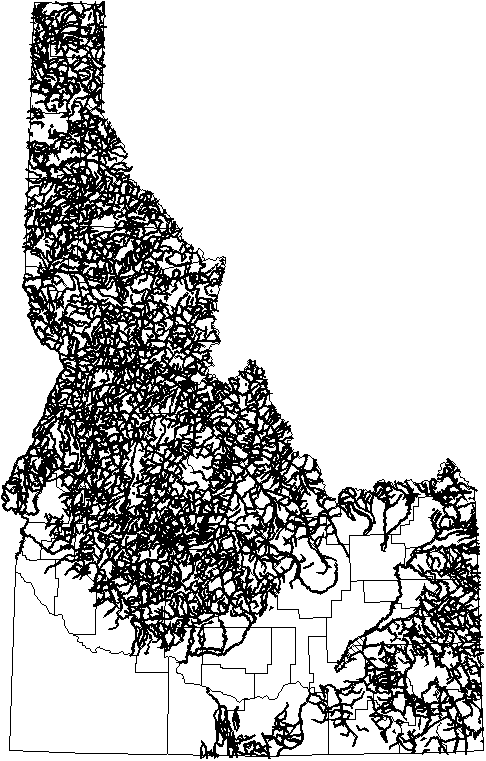
Sorex palustris
(Water Shrew)
Order: Insectivora
Family: Soricidae
Family Description: Shrew
Range:
The water shrew is from southern Alaska and Yukon Territory, south through California, the Rocky Mountains, northern Great Lakes region, and New England. Disjunct population exists in Appalachians.
Description:
Of all the shrews in Idaho, the water shrew may be the most striking and certainly the largest. In fact it is the largest of all shrews in Idaho weighing 0.33 to 0.50 ounce (12 18 grams). Its total length is 5.5 to 6.7 inches (137-168 mm), tail length is 2.8 to 3.4 inches (70-85 mm). It is grayish-black on top and silvery white to grayish underneath, its fur has been described as iridescent. It has a fringe of stiff hairs on the edge of the hind foot and a partial webbing of skin between the third and fourth toes of the hind feet; adaptations for swimming, a common behavior which gives the water shrew its name. They are good swimmers and their dense fur traps air, which provides insulation and keeps their skin dry. Underwater, the trapped air forms bubbles that surround them and give them a striking , silvery appearance when they are swimming.
Habitat:
Most abundant along small, cold streams with thick overhanging riparian growth. Also found around lakes, ponds, and other aquatic habitats. Rarely found far from water. In Idaho, they are found in mountain and foothill streams, lakes, and wetlands (marshes, bogs, fens.) In Montana a study found them predominantly along streams where the banks were composed of large boulders and tree roots, which formed numerous crevices and overhanging ledges.
Diet:
They are primarily dependent upon aquatic insects, but will also eat various other invertebrates. May take small vertebrates (fishes or amphibians) when available.
Ecology:
Water shrews are generally active throughout the day in every season (two major activity periods have been reported: sunset to 4 hr after sunset; and just before sunrise). They hunt under and on top of water. May be seen running across water surface which is accommodated by their webbing and stiff fringe hairs on their hind feet, and their dense fur which traps air and gives they buoyancy. In a Manitoba study, home range for 2 individuals was 0.2-0.3 ha (0.5-0.75 ac). A Michigan study found 7 individuals along 20 m section of stream. In Idaho, predators include snakes, weasels, fish, owls, hawks, and large frogs. The species possesses highly odoriferous flank glands, acute hearing, and (possibly) echolocation.
Reproduction:
In Montana, it breeds from February to August. Gestation probably takes 3 weeks. litter size varies from 3 to 10 young (average 6). In Montana, females produce 2 to 3 litters per yr. Young become sexually mature in second calendar year (females before males), and live a maximum of 18 months.
Conservation:
| Status: | Unprotected nongame species |
|
Global Rank: |
G5 |
|
State Rank: |
S4 |
Important State References:
Medin, D.E. and W.P. Clary. 1990. Bird and small mammal populations in a grazed and ungrazed riparian habitat in Idaho. USDA Forest Service Inter. Res. Sta. Res. Paper INT-245.
Information written by Donald Streubel,© 2000
Map image provided by Stephen Burton,© 2000
Design by Ean Harker©1999, 2000.
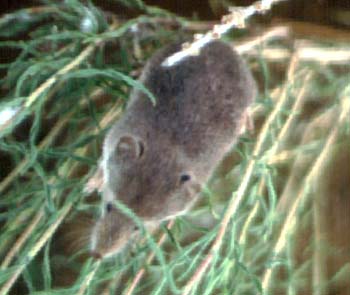
Sorex merriami
(Merriam's Shrew)
Order: Insectivora
Order Description: Insectivores
Family: Soricidae
Family Description: Shrew
Range:
Not much is known about this shrew, but it may be widely distributed in the Great Basin, Columbia Plateau, northern Great Plains, and southern Rocky Mountains.
Description:
Merriam's shrew is brownish-gray or gray above which whitish undersides. Its tail is distinctly bi-colored. It is smaller than the dusky and masked shrew and it is very difficult to identify. Only close, microscopic examination of the teeth will allow experts to identify it with certainty. Its total length is 3.5 to 4.3 inches (88 to 107 mm), tail length is 1.3 to 1.7 inches (33 to 42 mm) and it weighs 0.14 to 0.24 ounce (4 to 7 grams).
Habitat:
It is found at elevations of 200-2900 m, primarily in grasses in shrub steppe or pinyon-juniper habitat (recorded in spruce-aspen grove in New Mexico). Seems to prefer drier habitat than other shrews. In Idaho, this species has only been collected in sagebrush habitats, but it is also known to occur in mountain mahogany.
Diet:
Feeds primarily on insects and other small invertebrates. Caterpillars are most common summer food item.
Ecology:
It is active throughout the year and it may utilize burrows and runways of other animals. In Washington and Wyoming, frequently found in association with sagebrush voles. Owls are only known predators. Displays summer and winter pelage. Recent studies in Idaho suggest species is more common than previously thought.
Reproduction:
In Washington, pregnant females have been captured from mid-March to early July; litter size produced by 3 females ranged from 5 to 7 young. Males develop large flank glands in the spring, which may be an attraction for females. These flank glands may also repel predators.
Conservation:
| Status: | Unprotected nongame species |
|
Global Rank: |
G5 |
|
State Rank: |
S2 |
Important State References:
Mullican, T.R. 1986. Additional records of Sorex merriami from Idaho. Murrelet 67:19-20.
Information written by Donald Streubel,© 2000
Photo by Tim Mullican,© 1983
Design by Ean Harker©1999, 2000.
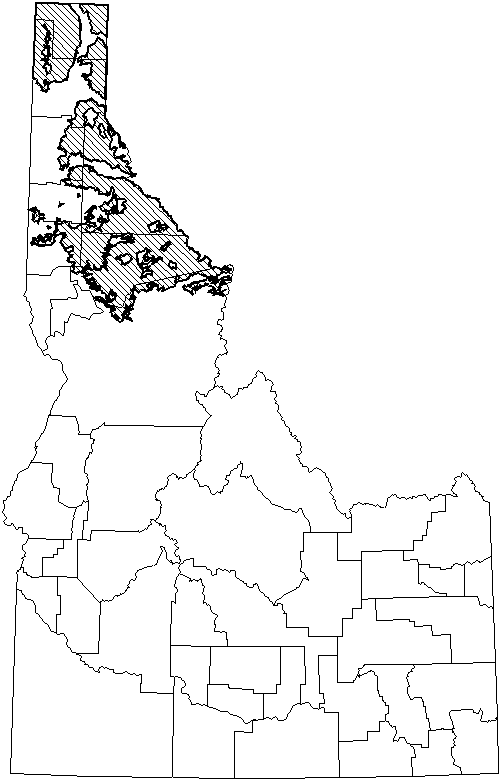
Sorex hoyi
(Pygmy Shrew)
Order: Insectivora
Family: Soricidae
Family Description: Shrew
Range:
This shrew is distributed throughout much of Canada and Alaska, excluding northern tundra zones. South of Canada populations are limited to the northern Rockies, Great Lakes region, and New England. Disjunct populations occur in mid-Rockies and Appalachians.
Description:
The Pygmy shrew is the smallest of all mammals, weighing only .07 to .13 of an ounce (2.2 3.8 grams), or the equivalent of about a dime. Its total length is 3 to 3.5 inches (75 to 87 mm), tail length is 1 to 1.25 inches (25 to 31 mm). It is variable dorsally, from a reddish-brown to gray and is silvery underneath. It has a distinctly bicolored tail.
Habitat:
This very small mammal is found in a variety of habitats. It appears to prefer grassy openings of boreal forests, and moist habitats are preferred over dry areas. In Idaho, individuals have been collected in high-elevation spruce-fir forests and, more recently, in cedar-hemlock forests on the Idaho Panhandle. It is also known to occur in riparian habitat along boggy ponds.
Diet:
Primarily dependent upon invertebrates. In one study, its diet in New Brunswick consisted mainly of insect larvae, beetles, and spiders.
Ecology:
It is active throughout the year. Peak activity occurs at night. In Michigan a study estimated population densities at 0.2 to 2 individuals per 0.4 ha (1 acre). Its burrows are interwoven among roots of old stumps and under fallen logs.
Reproduction:
Meager information exists on its life history. It probably breeds from late spring to late summer. Females produce 1 litter, and Gestation probably lasts 2 to 3 weeks. litter size varies from 5 to 6 young. Young reach sexual maturity in second summer.
Conservation:
| Status: | Unprotected nongame species |
|
Global Rank: |
G5 |
|
State Rank: |
S2 |
Important State References:
Foresman, K.R. 1986. Sorex hoyi in Idaho: a new state record. Murrelet 67:81-82.
Information written by Donald Streubel,© 2000
Map image provided by Stephen Burton,© 2000
Design by Ean Harker©1999, 2000.
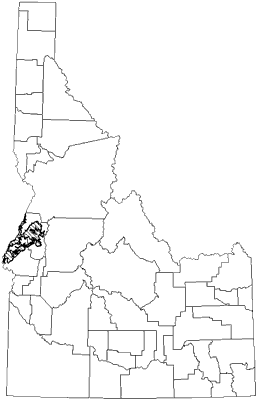
Scapanus orarius
(Coast Mole)
Order: Insectivora
Order Description: Insectivores
Family: Talpidae
Family Description: Mole
Range:
Idaho's only mole, the coast mole, is found from southwestern British Columbia, south through western Washington and Oregon to coastal northwestern California. It is also found in parts of eastern Washington and Oregon, and extreme west-central Idaho.
Description:
Moles are fossorial, or burrowing mammals, and are well adapted to this existence. Their fur is short, black and like velvet. It allows them to tightly move through the soil without offering resistance. Their ears are not visible as they exist as small openings covered by hair (probably to prevent them from being plugged by soil). Coast moles are small, total length is 6 to 7 inches (147-175 mm), tail length is 1 to 1 ¾ inches (26-43 mm). Their tail is nearly hairless as is their snout, which appears pinkish.
Habitat:
It is found in agricultural land, coastal dunes, grassy meadows, coniferous and deciduous forests and woodlands, and along streams.
Diet:
Like most moles, their diet is dominated by earthworms. Other common food items include adult and larval insects and other invertebrates such as snails and slugs.
Ecology:
The coast mole is active throughout year. Moles are fossorial , living much of their life underground in burrows, but are occasionally active on surface. Dispersing juveniles move across the surface during the summer. They are solitary except when breeding, probably with only one mole per burrow system. Population density is highly variable, ranging from 1 per ¼ acre (0.10 ha) to 1 per 35 acres (14 ha). If their habitat is flooded, they tend to quickly recolonize the area. Their maximum longevity is probably about 4 to 5 years. Their average home range has been estimated at 0.3 acre (0.12 ha). Predation on moles may be fairly low because of their fossorial habits.
Reproduction:
Coast moles breed from January to early March. Birth occurs in late March or early April and litter size varies from 2 to 4 young. Females, which are sexually mature at 9 to10 months, produce 1 litter per year.
Conservation:
| Status: | Unprotected nongame species |
| Global Rank: | G5 |
| State Rank: | S1 |
Important State References:
Caswell, E. B. 1953. A mole from Idaho. Murrelet 34.9 Yensen, E., D.A. Stephens, and M. Post. 1986. An additional Idaho mole record. Murrelet 67:96
Information written by Donald Streubel,© 2000
Map image provided by Stephen Burton,© 2000
Design by Ean Harker©1999, 2000.
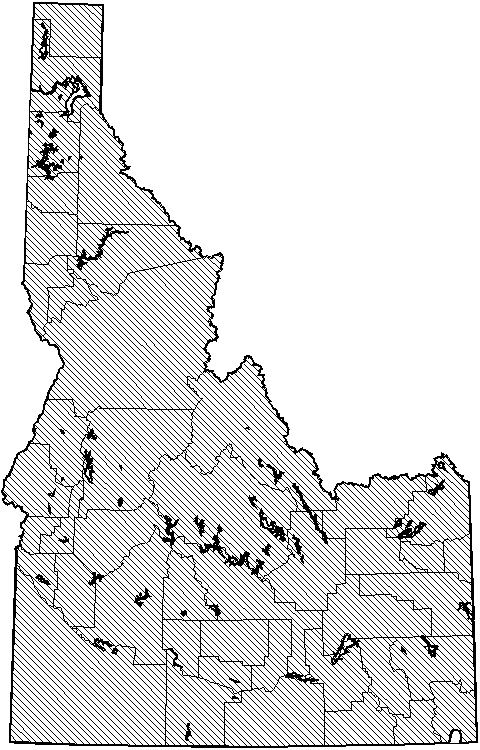
Myotis lucifugus
(Little Brown Myotis)
Order: Chiroptera
Order Description: Bats
Family: Vespertilionidae
Family Description:
Description:
The upper fur is usually brownish, long, silky, glossy, and may have a gold sheen. The tragus is blunt, about one-half the length of the ear which is narrowly rounded. When laid forward, the ear does not extend significantly beyond the nostrils. The calcar is not keeled.
Range:
From Alaska east across southern Canada to the Atlantic coast, south along the coast to Georgia and across to California, especially in forested mountain ranges and buildings, but largely absent from arid lowlands in the southern portion of its range. This species has a very broad distribution. It has been collected in over 20 counties in Idaho.
Habitat:
This bat is found in a wide range of elevations often associated with forests containing snags, old buildings, and slack-water areas with abundant insects. Site fidelity is likely common in all geographical areas. Large hibernation sites have not been documented in Idaho.
Diet:
Aquatic insects including caddis flies, mayflies, midges, and mosquitos, based upon assessments in other geographical areas.
Ecology:
Although the little brown bat is an ecological generalist able to occupy a large number of roosting conditions, very little is known about this species in Idaho. Large numbers are rarely caught at any single netting site. Little brown bats, because of their wide distribution and large populations, may be an especially good litmus species for excessive habitat conversion as a result of anthropomorphic activities. They are likely being eliminated in vacation home areas where they are considered a pest as a result of accumulation of guano and ignorance of their beneficial destruction of insects.
Probably the most common bat in North America, and one of the best studied. Most active during first 2-3 hr after sunset. Second foraging period follows midnight roost, which is lengthened by cool temperatures and low abundance of prey. Hibernates from September or October to April or May. In winter, selects temperature at or below 40° F and relative humidity of about 80%. Winter concentrations may include tens of thousands of individuals. Survival rate is low during first winter, higher in subsequent years. Most summer nursery colonies range from 50-2500 bats (average 400). Summer home range is poorly understood.
Reproduction:
Polygynous mating occurs prior to hibernation at hibernal sites. Sperm is stored over winter and fertilization occurs when hibernation is terminated. Maternity colonies form and a single pup is born after about 60 days of Gestation . Each pup weights about 25 percent of the body mass of the female.
Usually mates from September-October. Ovulation and fertilization are delayed until spring. Gestation lasts 50-60 days. Female gives birth to 1 litter of 1 young, in late spring-early summer. Female produces first young usually in first year (Indiana, New Mexico) or second year (British Columbia).
Conservation:
| Status: | Unprotected nongame species |
| Global Rank: | G5 |
| State Rank: | S5 |
Important State References:
Bonnell, M.L. 1967. Emergence and foraging behavior in small populations of Idaho bats. M.S. Thesis, Univ. Idaho, Moscow. 63pp.
Information written by Barry Keller ,© 2000
Map image provided by Stephen Burton,© 2000
Design by Ean Harker©1999, 2000.
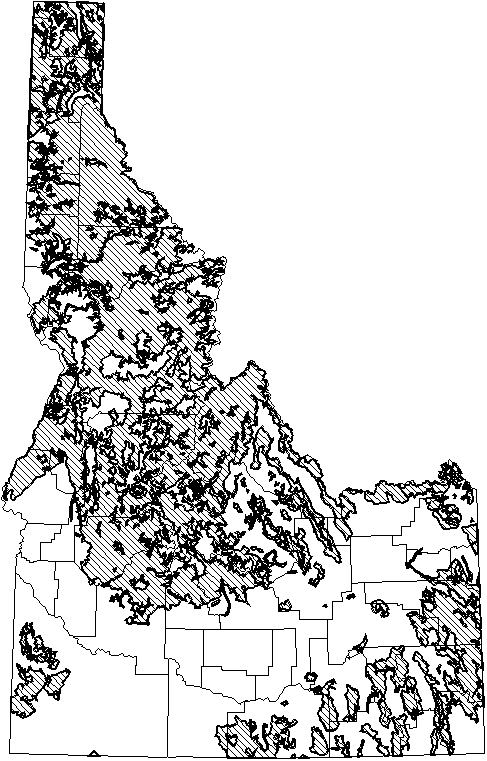
Myotis evotis
(Long-eared Myotis)
Order: Chiroptera
Order Description: Bats
Family: Vespertilionidae
Family Description:
Description:
The upper fur is brownish at the tips and dark at the base. The dark to blackish glossy rounded ears extend past the nostrils and can exceed three-quarters of an inch (=20mm). The tragus is extends over one-half of the length of the ear.
Range:
A western distribution including British Columbia east across southern Canada to Saskatchewan, south along the western edge of the Dakotas Nebraska, much of Colorado and New Mexico, west across northern Arizona, Nevada, to the Pacific Coast from Baja California, through California, Oregon and Washington. It has been collected in fifteen Idaho counties but likely occurs in most of the Gem State.
Habitat:
This bat is found in a wide range of habitats often associated with forests. It is found under exfoliating bark, in cavities in trees, and in stumps resulting from logging. In shrub communities, is may be found in crevices in cliffs and rocks on the ground, in lava-tube caves, and abandoned mines. It has also been found occasionally in buildings and under bridges.
Found (from near sea level along Pacific Coast, to about 2830 m in Wyoming), mostly in forested areas, especially those with broken rock outcrops; also found in shrublands, over meadows near tall timber, along wooded streams, and over reservoirs. Idaho study found roosts were always located near water. Species is common in lodgepole pine forests.
Diet:
Primarily moths and beetles but other insects including lacewings, true bugs, wasps and bees are eaten. This species may glean insects from the surface of a variety of desert shrubs but it also occurs and feeds in coniferous forests.
Ecology:
In northern Idaho, long-eared myotis appear to feed near the back of mines, especially at the portal. They do not seem to use these mines for night roosting or winter hibernation. A few to a moderate number of individuals are often associated with areas adjacent to reservoirs or streams containing areas of slow-moving water. Small nursery colonies containing females and young form. Nonbreeding small mixed sex colonies are also known to occur during summer. More information on winter roosting ecology is needed for this species.
Widespread and not uncommon species, but little is known about its habits. Reportedly emerges late in evening to feed, though some studies report earlier emergence. Forages over water or among trees. Usually feeds by picking prey from surface of foliage, tree trunks, rocks, or ground; may fly slowly around shrub searching for emerging moths, or perhaps nonflying prey. Known to forage with long-legged myotis, big brown bat, silver-haired bat, and hoary bat, but Idaho study found species foraged earlier in evening than several other bat species. Often roosts in buildings; may also roost in hollow trees, mines, caves, and fissures.
Reproduction:
Swarming and mating take place prior to hibernation and sperm is stored over winter. Fertilization ensues when ovulation occurs in the spring. A single pup is born, as late as mid July in northern Idaho. Each pup weights about 20 percent of the body mass of the female.
Mating occurs in fall; ovulation and fertilization are delayed until spring. Births have been recorded in mid-July in western Washington. Young and lactating females have been recorded in late July in New Mexico. Female and newborn young have been recorded in late June in California. Female produces 1 young. South Dakota study found that male young-of-year reached approximate adult size in early August.
Conservation:
| Status: | Unprotected nongame species |
| Global Rank: | G5 |
| State Rank: | S3 |
Important State References:
Bonnell, M.L. 1967. Emergence and foraging behavior in small populations of Idaho bats. M.S. Thesis, Univ. Idaho, Moscow. 63pp.
Information written by Barry Keller,© 2000
Map image provided by Stephen Burton,© 2000
Design by Ean Harker©1999, 2000.
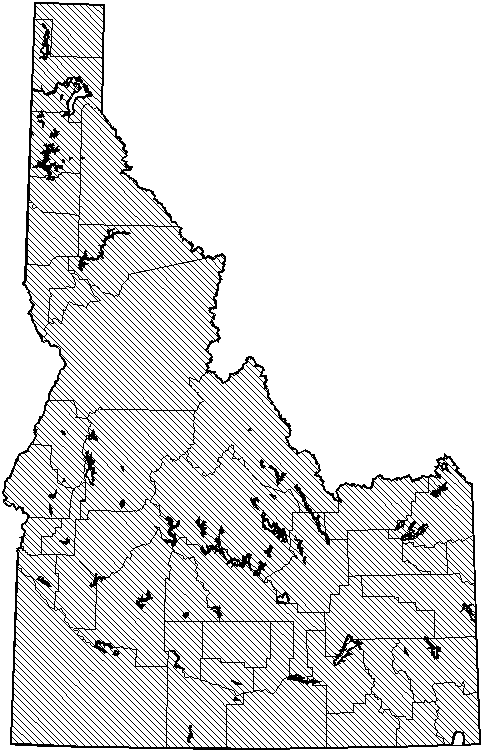
Myotis yumanensis
(Yuma Myotis)
Order: Chiroptera
Order Description: Bats
Family: Vespertilionidae
Family Description:
Description:
In Idaho, the upper fur is pale brown lacking the goldish sheen usually seen in little brown bats. The tail membrane often has hair dorsally and ventrally that extends to slightly beyond a line joining the knees. The ears are rounded, extend just past the muzzle, and are pale brown as contrasted to the darker ears of little brown myotis. The skull has a abrupt increase in height above the forehead, a condition also lacking in Myotis lucifugus. In spite of these differences, it is extremely easy to confuse Yuma myotis with little brown myotis, especially in limited light. Both species lack a keeled calcar , although an extremely small lobular piece of tissue is present along the calcar in many yuma myotis.
Range:
The western portion of British Columbia southeast into western Montana and the western half of Idaho. Largely absent in Nevada and Utah, this species is found in Colorado, New Mexico, and Arizona to central Mexico, and extends along the Pacific Coastal areas of Baja California, California, Oregon, and Washington. In Idaho, it has been collected in eleven counties.
Habitat:
Yuma myotis occur in a variety of western lowland habitats in areas of abundant water where it forages for insects just above the surface of slack water. It is an important riparian species and likely been eliminated along many streams in western states. Summer roosts include crevices in cliffs, old buildings, mines, caves, bridges, and abandoned cliff swallow nests. No large winter concentrations of this species have been studied in Idaho.
Found in wide variety of upland and lowland habitats, including riparian situations, desert scrub, and moist woodlands and forests, but usually found near open water (more closely associated with water than most other North American bats.) In Idaho, inhabits wide elevational range.
Diet:
Yuma myotis eat a variety of soft bodied small insects, especially moths and emergent aquatic insects including stoneflies and mayflies found near and over water.
Insectivorous . Small moths are believed to be primary food source; dipterans and ground beetles are other common prey.
Ecology:
Little is known about the distribution and abundance of this species in Idaho and whether it migrates to areas outside of summer locations. It is probable that yuma myotis are highly susceptible to destruction of conditions favoring the production of tricopteran insects upon which they feed and nursery colonies may only occur in mines lacking human disturbance.
Hibernates /aestivates . Active at night; leaves daytime roosts to feed in early evening. Often forages over streams, flying just above water surface. May be locally abundant. Availability of daytime roosts may be limiting factor in some areas. Males are solitary during birthing season.
Reproduction:
Mating likely takes place during the fall, and ovulation and implantation in spring. A single pup is produced in female-only maternity colonies that may occur in dome areas in mines with high humidity Pups are born in May to mid July, depending on weather conditions. The thermal conditions required to support nursery colonies in Hell's Canyon have been studied.
Maternity colonies form in April. Female first breeds in second summer, and produces 1 young, born late May-July (in western Oklahoma and Arizona, peak is apparently mid-June; in California, young are born apparently from late May to mid-June). ovulation and fertilization are delayed until spring. Colonies disperse by end of September.
Conservation:
| Status: | Unprotected nongame species |
| Global Rank: | G5 |
| State Rank: | S3 |
Important State References:
Betts, B.J. 1997. Microclimate in Hell's Canyon mines used by maternity colonies of Myotis yumanensis. Journal of Mammalogy 78:1240-1250.
Keller, B.L. 1987. Analysis of the bat species present in Idaho, with special attention to the spotted bat, Euderma maculatum. Dept. Biol. Sciences, Idaho St. Univ., Pocatello. 25pp
Information written by Barry Keller,© 2000
Map image provided by Stephen Burton,© 2000
Design by Ean Harker©1999, 2000.
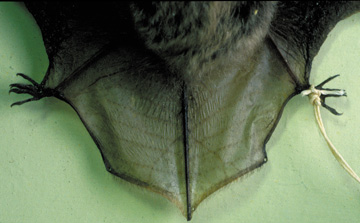
Myotis thysanodes
(Fringed Myotis)
Order: Chiroptera
Order Description: Bats
Family: Vespertilionidae
Family Description:
Description:
The dorsal upper fur is often reddish-brown, the rounded ears long (3/4 inch = 16-20 mm), the tragus long and pointed and the tail membrane distinctly fringed. Occasionally, this species might be confused with Myotis evotis as a result of individuals with a very few hairs along the margin of the tail membrane.
Range:
From south-central British Columbia, south through western U.S. to portions of southern Mexico. Disjunct population occurs in Black Hills of Wyoming and South Dakota. Winter range is not well known; Idaho range is only known from 2 locales, but distribution is probably much greater.
Western North America from southern British Columbia east to South Dakota, south into Mexico and west to California. This species, uncommon in Idaho, has been collected or observed in Boise, Butte, Clearwater, Latta, Nez Perce, Owyhee, and Shoshone Counties.
Habitat:
Desert, oak and pinon-juniper woodlands (where most common) and coniferous or mixed deciduous forest usually in mid elevations. The wing membranes and food habits suggests this bat has a foraging strategy permitting gleaning of insects from vegetative surfaces. Individuals may change roost sites as a result of disturbance.
Found in desert, grassland, and woodland habitats, primarily at middle elevations of 1200-2150 m. Has been recorded at 2850 m in spruce/fir forests in New Mexico, and at low elevations along Pacific Coast.
Diet:
Insectivorous ; beetles and moths are common prey item.
Ecology:
This species occurs in a large number of roosting conditions including snags, hollows in trees, buildings, mines, rock crevices, and bridges. Females and males separate during pup rearing. On the basis of studies completed outside of Idaho, this species appears to be rare, a condition that made the fringed myotis a former Category 2 candidate species.
Hibernates /aestivates . Known to be active from April-September. Roosts in caves, mines, rock crevices, buildings, and other protected sites. Often forages close to vegetative canopy. Wings have high puncture strength, which is characteristic of bats that forage by gleaning from ground or near thick or thorny vegetation. In Idaho, found with many other species, including long-eared myotis, long-legged myotis, and California myotis; known to roost communally, but never closer than 3 m to other bat species. Easily disturbed by human presence. Known to thermoregulate. Ecology of this species is poorly known, particularly in winter.
Reproduction:
Reproduction begins upon break-up of maternity colonies which appear to be located in cool wet conditions. Ovulation , and implantation occurs from April to May. Fifty to 60 days later a single young is born in late June or early July.
Apparently little variation exists in timing of reproduction throughout range. In northeastern New Mexico, mating occurs in fall; ovulation , fertilization , and implantation occur from late April to mid-May. Gestation lasts 50-60 days; births occur in late June to mid-July. Female produces 1 young. Young can fly at 16-17 days. Maternal colony sizes may reach several hundred individuals; colonies begin to disperse in October.
Conservation:
| Status: | Protected nongame species |
| Global Rank: | G5 |
| State Rank: | S1 |
Important State References:
Keller, B.L. 1999. Thermal characteristics of lava caves in the North caves area and bat species present at pond cave, Craters of the Moon National Monument, Butte County, Idaho. National Park Service, Craters of the Moon National Monument, Arco, Idaho. 78p.
Bonnell, M.L. 1967. Emergence and foraging behavior in small populations of Idaho bats. M.S. Thesis, Univ. Idaho, Moscow. 63pp.
Information written by Barry Keller,© 2000
Map image provided by Stephen Burton,© 2000
Design by Ean Harker©1999, 2000.
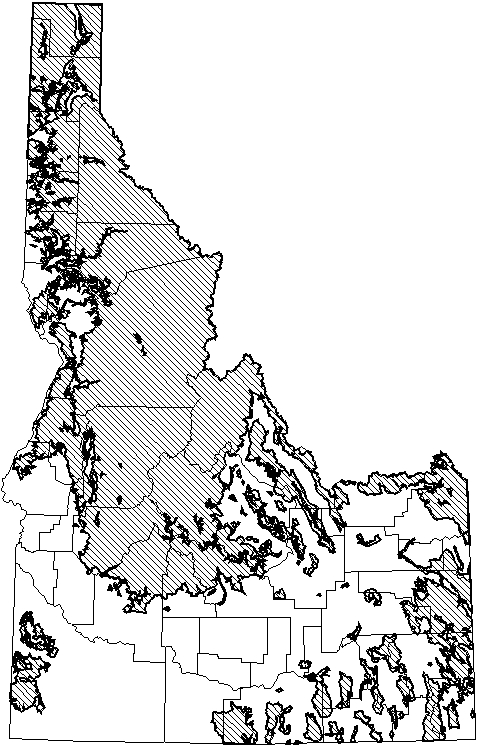
Myotis volans
(Long-legged Myotis)
Order: Chiroptera
Order Description: Bats
Family: Vespertilionidae
Family Description:
Description:
The upper fur is usually cinnamon to brownish. Dense fur on the underside of the wing membrane occurs from the belly to a line joining the elbow and knee, the only Idaho species with this characteristic. The ears are short, rounded at the margin and barely reach the end of the nose when laid forward. The calcar is keeled, and the foot relatively small.
Range:
The western to southern portion of British Columbia, southern Alberta, east across northern Montana to the western edge of the Dakotas, then almost due south into central Mexico, and west into Baja California and along the Pacific Coast states of California, Oregon, and Washington. In Idaho, this species has been collected in twelve counties.
Habitat:
This bat occurs in a variety of habitats from desert to mountainous coniferous forests, where it appears to be most common, especially if open water occurs in the area. Summer roosts include cliff crevices, cracks in the ground, hollows in snags, or hollow areas under exfoliating bark and in living trees, and old buildings. Winter hibernal sites include caves and mines tunnels. No large winter concentrations of this species have been found in mines in Idaho.
Found in montane coniferous forests at 2000-3000 m. Also found in riparian and desert (Baja California) habitats. May change habitats seasonally.
Diet:
Long-legged myotis eat a variety of small insects found in forests including moths, leafhoppers, lacewings, termites, flies, and small beetles. The food taken may vary with insect availability.
Ecology:
In many other states, this species appears to be abundant. This species migrates locally, perhaps taking advantage of changing insect populations especially in fall. Long-legged myotis have a flight pattern that appears to be planned and direct. They are known to traverse large areas of forest or water when feeding.
Hibernates /aestivates . Active throughout most of night. Peak activity occurs during first 3-4 hr after sunset. Forages for relatively long distances over, through, and around forest canopies and forest clearings, and also over water. In New Mexico, forages primarily in open areas. Uses caves and mines as hibernacula , but winter habits are poorly known. Roosts in abandoned buildings, rock crevices, and under bark. In summer, apparently does not use caves as daytime roost sites. Sometimes attains life span of 21 yr.
Reproduction:
Mating takes place during the fall, and ovulation and implantation in spring. Several hundred individuals may occur in nursery colonies. A single pup is born in mid-summer. Very little is known about this species in Idaho.
In New Mexico study, mating began in late August, sperm was stored over winter in female reproductive tract, ovulation occurred March-May, and parturition took place May-August. In Texas, births probably occur in June or early July. Female produces 1 young. Nursery colonies may include up to several hundred individuals.
Conservation:
| Status: | Unprotected nongame species |
| Global Rank: | G5 |
| State Rank: | S3 |
Important State References:
Keller, B.L. 1987. Analysis of the bat species present in Idaho, with special attention to the spotted bat, Euderma maculatum. Dept. Biol. Sciences, Idaho St. Univ., Pocatello. 25pp
Information written by Barry Keller,© 2000
Map image provided by Stephen Burton,© 2000
Design by Ean Harker©1999, 2000.
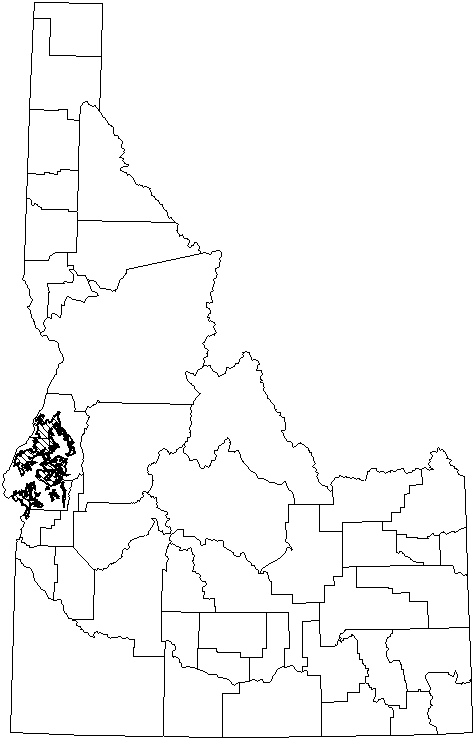
Myotis californicus
(California Myotis)
Order: Chiroptera
Order Description: Bats
Family: Vespertilionidae
Family Description: Bats
Description:
The upper fur is brownish chestnut and tends to have a yellowish cast. The cranium is not flattened, a condition found in western small-footed myotis with which this species may be confused. The ears are rounded at the margin and extend slightly beyond the muzzle. A brownish area exists across the face to the ears. The tragus is less than one-fourth of the length of the ear and is pointed. The calcar is keeled and the foot small.
Range:
The southeastern portion of Alaska and western half of British Columbia south through Idaho and Utah, along the western edge of Colorado, New Mexico, into central Mexico, west into Baja California and throughout the Pacific states of California, Oregon and Washington. In Idaho, this species has been collected in three counties.
From extreme southern Alaska and western Canada, south in lowlands through Montana, Utah, and California, and throughout desert Southwest. Winters in California, Nevada, Utah, Arizona, and Texas. Full extent of winter range is not known. In Idaho, species has only been observed near west-central border, but distribution is probably more widespread.
Habitat:
This bat has been found in western and panhandle counties in Idaho, in a variety of habitats from forest to desert conditions. It appears to be more common in areas with open areas of slack water. Summer roosts include crevices in rocky hillsides, rocky outcrops, buildings, trees with exfoliating bark, and cavities in snags.
Found from seacoasts to deserts, at elevations up to about 1800 m, in oak/juniper situations, canyons, riparian woodlands, desert scrub, and grasslands.
Diet:
California myotis eat small insects including moths, beetles, and flies. The food taken may vary with the diet of similar-sized sympatric species if present, especially Western small-footed myotis. Insectivorous .
Ecology:
Periods of foraging activity may vary with temperature in this species and flight may occur during freezing conditions. Colonies appears to be small. Mine use may be limited, but the roosting requirements of this species needs further study.
Known to hibernate in U.S. during winter, but winter activity has also been recorded. In southern California, occasional individuals have been found active on warm winter days. Active bats have been regularly caught in Nevada in fall and winter (frequently in temperatures below 43° F). Species hibernates in caves, mines, tunnels, or buildings. Forages with slow, erratic flight pattern approximately 1.5-3 m off ground. Often uses human-built structures for night roosts . Uses crevices of various kinds for summer day roosts.
Reproduction:
Mating takes place during the fall, excepting California where it may occur during the spring. A single pup is born. Nursery colonies are small, the largest found in Canada consisted of 52 individuals. Very little is known about this species in Idaho.
Ovulation and fertilization are delayed until spring. Female gives birth to 1 young in late May to mid-June, depending on range (July in Canada). Nursery colonies are usually small (up to about 25 individuals).
Conservation:
| Status: | Unprotected nongame species |
| Global Rank: | G5 |
| State Rank: | S1 |
Important State References:
Keller, B.L. 1987. Analysis of the bat species present in Idaho, with special attention to the spotted bat, Euderma maculatum. Dept. Biol. Sciences, Idaho St. Univ., Pocatello. 25pp.
Information written by Barry Keller,© 2000
Map image provided by Stephen Burton,© 2000
Design by Ean Harker©1999, 2000.
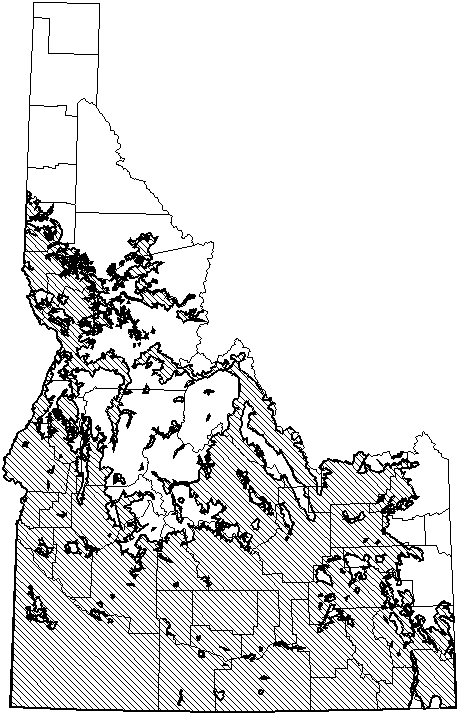
Myotis ciliolabrum
(Western Small-footed Myotis )
Order: Chiroptera
Order Description: Bats
Family: Vespertilionidae
Family Description:
Description:
The upper fur is brownish and tends to have an yellowish-orange cast in Idaho. The blackish ears, containing a short pointed tragus , are rounded at the margin and do not extend forward beyond the muzzle. A distinct black mask exists across the muzzle and face to the ears. The calcar is keeled and the foot small.
Range:
Southern British Columbia, Alberta and Saskatchewan along the western edge of the Dakotas, Nebraska, Kansas, Oklahoma, and northern Texas into central Mexico, then west to northern Baja California and along the eastern half of the Pacific Coast states of California, Oregon and Washington.
Habitat:
This bat has been found in a range of habitats in Idaho and is likely one of the more common bats. It appears to be more abundant in southern Idaho in lava-tube caves where it hibernates in cracks and crevices. In other states, it occurs in montane and coniferous forests and is found under exfoliating bark, in cracks and crevices in rocks, and in old buildings.
Found in arid habitat associated with cliffs and talus slopes. In Texas, principally found in mountainous, wooded areas, with a few found in grassland and shrub steppe habitats. In Canada, inhabits arid, short-grass prairies with clay buttes and steep riverbanks.
Diet:
Western small-footed myotis eat small insects including moths, flies, true bugs and ants. The food taken may vary with the diet of similar-sized sympatric species, especially California myotis. Subdivision of forage areas to rocky bluffs occurs when this species occurs sympatrically with California myotis.
(Oregon study identified Lepidoptera , Hemiptera , and Diptera ; British Columbia study found Trichoptera ).
Ecology:
The classification of this bat has changed from Myotis subulatus and later M. leibii. It may also be incorrectly identified as M. californicus, a species which has a more globular cranium, tri-colored fur and is usually found in dryer areas. Individuals do not cluster together and hibernation appears to be extended for a longer period of time in western small-footed myotis than California myotis.
Hibernates in caves and mines in winter (one of the last bats to begin hibernation ). In Idaho, known to winter in lava-tube caves in southern part of state. Roosts in summer in rock crevices, under boulders, beneath loose bark, or in buildings. During warmer months, leaves daytime roost shortly after sunset. Forages along cliffs and rocky slopes at heights of 1-3 m. Foraging activity peaks between 2200-2300 hr and 0100-0200 hr. Species is sympatric with California myotis; appears to coexist by spatial partitioning of available food source.
Reproduction:
Swarming is known to occur at high elevations in September. Mating takes place prior to and potentially after hibernation. Sperm are stored until spring ovulation occurs. A single pup is born. Nursery colonies are likely small but little is known about group size in this species in Idaho.
Little information is available. Observations of pregnant and lactating females indicate that parturition occurs from late May or June through early July. In U.S., females usually produce 1 young (sometimes 2 at more southern latitudes). Maternity colonies are small.
Conservation:
| Status: | Unprotected nongame species |
| Global Rank: | G5 |
| State Rank: | S4 |
Important State References:
Genter, D.L. 1986. Wintering bats of the upper Snake River plain: occurrence in lava-tube caves. Great Basin Natur. 46:241-244.
Information written by Barry Keller,© 2000
Map image provided by Stephen Burton,© 2000
Design by Ean Harker©1999, 2000.
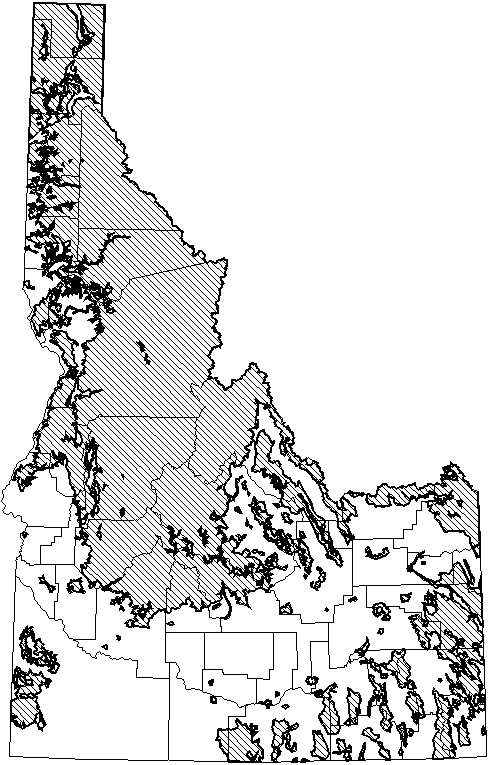
Lasiurus cinereus
(Hoary Bat)
Order: Chiroptera
Order Description: Bats
Family: Vespertilionidae
Family Description:
Description:
The dorsal fur is yellowish to brownish with white tipped hairs producing a frosted appearance. The furred ears have black rims, are wide and fully rounded. The tragus , curved forward and wide at the base, is less than one-half the length of the ear. The tail membrane is heavily furred, usually to the margin. A tan throat patch is present and a cream-to-white spot in just behind the thumb. Newborn bats are covered with fine silvery-gray hair. This is the largest bat found in Idaho.
Range:
Southern British Columbia east across Northern Canada to Nova Scotia, southward along the Atlantic Coast to Northern Florida, west into Texas and South into Mexico, west to Baja California and North along the Pacific coast. Collected sites in Idaho include 13 counties but the hoary bat it is likely resident in all areas containing forested habitat but may be less common in urban areas.
Habitat:
Hoary bats usually roost at the edge of clearings preferring foliage of both coniferous and deciduous trees. Less common sites include cavities or, in unusual situations, caves or anthropomorphic structures.
Diet:
Grasshoppers, dragonflies, wasps, beetles, flies, and moths, apparently the preferred food, are eaten.
Ecology:
Hoary bats are most common in the southwest. They roost individually in trees, usually at the end of branches where they often choose a site that is not visible from above. The area below the roost is open and likely is along the edge of a clearing. Jays appear to be significant predators on this species. Hoary bats may fly in waves from northern forests to southern latitudes, usually in the late fall. Spring return migrations do not appear to be organized, but more needs to be learned about the migratory pattern of this species. This bat has a swift flight pattern. It usually flies high and direct to feeding areas along watercourses and meadows. Hoary bats enter torpor during cold periods and may feed in cold weather.
Swift flier. Usually emerges after dark, though one source states that emergence occurs early in evening. Feeding activity peaks 4-5 hr after sunset, with secondary peak occurring several hr before dawn. Frequently forages around clearings, but may forage around lights in nonurban situations. May forage at considerable distances (a mile or more) from diurnal roost site. Usually roosts in tree foliage 3-5 m above ground with dense foliage above roost and open flying room below, often at edge of clearing. Sometimes roosts in rock crevices; rarely uses caves. Generally dispersed population allows little chance to obtain density figures.
Reproduction:
Females do not form nursery colonies and males and females rarely occur together, except during breeding which appears to occur during migration. Individual females give birth to one to four pups in May to July. The average number of young is two.
Breeds from September-November in North America. fertilization is delayed. Gestation lasts 90 days. Female produces 1 litter of 1-4 young (average 2) in mid-May to early July (May or June in Idaho). Young are able to fly at 4 wk, and probably become sexually mature in first summer. Female sometimes may carry young during feeding flight.
Conservation:
| Status: | Unprotected nongame species |
| Global Rank: | G5 |
| State Rank: | S4 |
Important State References:
Keller, B.L. 1987. Analysis of the bat species present in Idaho, with special attention to the spotted bat, Euderma maculatum. Dept. Biol. Sciences, Idaho St. Univ., Pocatello. 25pp.
Information written by Barry Keller,© 2000
Map image provided by Stephen Burton,© 2000
Design by Ean Harker©1999, 2000.

Eptesicus fuscus
(Big Brown Bat)
Order: Chiroptera
Order Description: Bats
Family: Vespertilionidae
Family Description: Bats
Description:
The dorsal fur, often oily, is a dark brown to cinnamon brown. The typically bare ears are broad with rounded margins that, if extended forward, do not reach significantly beyond the tip of the broad nose. The tragus , which is slightly curved forward, is less than one-half the length of the ear. The calcar is keeled. The tail, enclosed in the tail membrane, usually extends several millimeters beyond the posterior margin of the membrane. Young of the year are usually darker and have duller fur than adults.
Range:
Broadly distributed from British Columbia east across southern Canada to Maine southward along the Atlantic coast to Florida and west to Baja California. This species extends south through Central America into Columbia. In Idaho, it has been collected in 15 counties but likely occurs everywhere in the state.
Habitat:
A common species in urban areas, the big brown bat often roosts in homes, especially behind shutters, in cool attics, and under eaves. In other buildings it may occur between enclosed walls. In forested areas, hollow spaces in snags or living trees are occupied. It is a common species near the entrances of caves and mines but usually does not cluster with other individuals in these colder locations. It appears to hibernate for a shorter period of time than members of the genus Myotis.
Diet:
A predator on beetles, this species is important as a result of its consumption of cucumber beetles which are agricultural pests. A variety of other insects are consumed, especially along water courses and in forests. Food items may include up to ten orders of insects.
Dependent upon flying insects; in many areas, small beetles are most common prey. Species' large size, powerful jaw muscles, and robust teeth allow predation on larger insects with tough exoskeletons (i.e., beetles).
Ecology:
Forages over land or water, around clearings and lake edges, around lights in rural areas, or around trees or forest canopies. Common in towns and cities. Initial foraging period occurs within 5 hr after sunset, although most activity occurs within second hr after sunset (may subsequently retire to night roost). Flies less than 2 hr each night. Distance from day roost to foraging area averages about 1-2 km. Caves, mines, and human-built structures are used for hibernation . In temperate areas, many individuals do not appear at hibernacula until November. Winter colonies rarely number more than a few hundred. Less gregarious in winter; usually roosts alone in crevice, but sometimes 2-20 may roost together. Summer roosts are generally in buildings, but hollow trees, rock crevices, tunnels, and cliff swallow nests may also be used; prefers roosting sites that do not get hot. Males are often solitary in summer, but may roost with females or in all-male colonies. When young are flying, males may join nursery groups to form large late-summer colonies. Individuals are capable of living at least 20 yr, but few attain old age.
Big-brown bats may select temporary roosting sites during bouts of foraging on warm, dry nights, although foraging usually occurs near their permanent roosts . Seasonal movements to hibernal areas are largely restricted to nearby sites. Females demonstrate strong fidelity to nursery sites which are often used by a larger number of individuals as contrasted to hibernal sites. Bats taken from roosting areas and released elsewhere can return to the area of collection, in one study, return occurred over a distance of 450 miles.
Reproduction:
Reproduction begins in the fall upon break-up of maternity roosts and may extend over winter and spring. Maternity colonies appear to be located in warm conditions and may move to alternate roosts by females that carrying their young in flight. Implantation occurs from April to May and birth about 60 days later. In the west, a single pup is born in late May or early June.
Breeds in fall and intermittently throughout winter. In temperate regions, ovulation and fertilization are delayed until after hibernation . Gestation lasts 2 mo. Female produces 1 young in western range, 2 in east, in May-July. Lactation lasts 32-40 days; young fly at 4-5 wk. Males are usually sexually mature in first fall; not all females reproduce at end of first year. Nursery colony rarely numbers more than a few hundred.
Conservation:
| Status: | Unprotected nongame species |
| Global Rank: | G5 |
| State Rank: | S4 |
Important State References:
Keller, B.L. 1987. Analysis of the bat species present in Idaho, with special attention to the spotted bat, Euderma maculatum. Dept. Biol. Sciences, Idaho St. Univ., Pocatello. 25pp.
Information written by Barry Keller,© 2000
Map image provided by Stephen Burton,© 2000
Design by Ean Harker©1999, 2000.
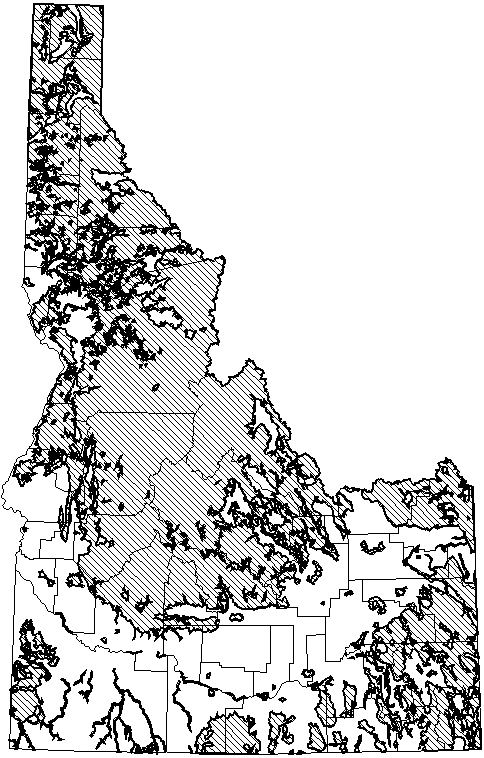
Lasionycteris noctivagans
(Silver-haired Bat)
Order: Chiroptera
Order Description: Bats
Family: Vespertilionidae
Family Description:
Description:
The dorsal fur is longish and usually blackish or dark brownish with silver-tipped hairs. The tragus is short and blunt, the ear cupped and broadly rounded. The calcar is not keeled.
Range:
Occurs throughout U.S. and most of southern Canada. Small populations may also be found in northern Mexico and southern Alaska. Apparently, most individuals overwinter in southern part of range. Males seem to stay farther south in spring and summer than do females. Idaho distribution is not well known.
Habitat:
This bat is found in a wide range of elevations in trees containing natural or bird-excavated cavities or under exfoliating bark. In northern Idaho, hibernating single individuals have been found in mine adits. In southern Idaho, lava-tube caves may be used as day roosts during fall north-south migrations. Logging, especially snag destruction, likely impacts the distribution of silver-haired bats. In Idaho, maternity colonies consist of small populations of females that change locations during pup rearing. The degree of yearly Site fidelity is unknown.
Diet:
Beetles, moths and a wide variety of small insects found along water courses, impoundments, and ponds are consumed.
Ecology:
This species has been studied in southern Idaho forest. Large numbers are rarely caught at any single netting site. The silver-haired bat may be an especially good indicator of the number of snags and green trees needed to support breeding and recruitment. In Idaho, over 50 percent of bats submitted that test positive for rabies are silver-haired bats. Thus, this bat should never be handled, especially if found on the ground during daylight hours.
Hibernates (rarely in caves). Species is relatively cold tolerant; may be active at low air temperatures (roosting migrants in Manitoba study became torpid at air temperatures below 20° C). Forages over small water bodies, forest canopy, and (in more open habitats) low over ground and shrub vegetation. Leaves roost and begins to forage relatively late. Major activity peaks 3 hr after sunset and 7-8 hr after sunset, but this varies with latitude. Usually roosts singly, but will occasionally form groups of 3-6. Summer roosts and nursery sites are in tree foliage, cavities, under loose bark, or sometimes in buildings (in Manitoba study, migrants typically roosted in narrow crevices in tree trunks). Densities are probably low. May congregate in large numbers and migrate several hundred miles.
Reproduction:
It appears likely that this species has evolved a sex specific population structure in some areas as males and females appear to be broadly geographically separated in some states. Maternity colony sites may contain several dozen individuals in Idaho. Females give birth to twins in late June after 50-60 days of gestation .
Conservation:
| Status: | Unprotected nongame species |
| Global Rank: | G5 |
| State Rank: | S5 |
Important State References:
Bohn, K. M. 1999. Day roost selection by silver-haired bats (Lasionycteris noctivagans) and the effects of a selective timber harvest on bat populations in Caribou National Forest. M.S. Thesis, Department of Biology, Idaho State University, Pocatello. 89 pp.+ appendix.
Keller, B.L. 1987. Analysis of the bat species present in Idaho, with special attention to the spotted bat, Euderma maculatum. Dept. Biol. Sciences, Idaho St. Univ., Pocatello. 25pp.
Information written by Barry Keller ,© 2000
Map image provided by Stephen Burton,© 2000
Design by Ean Harker©1999, 2000.
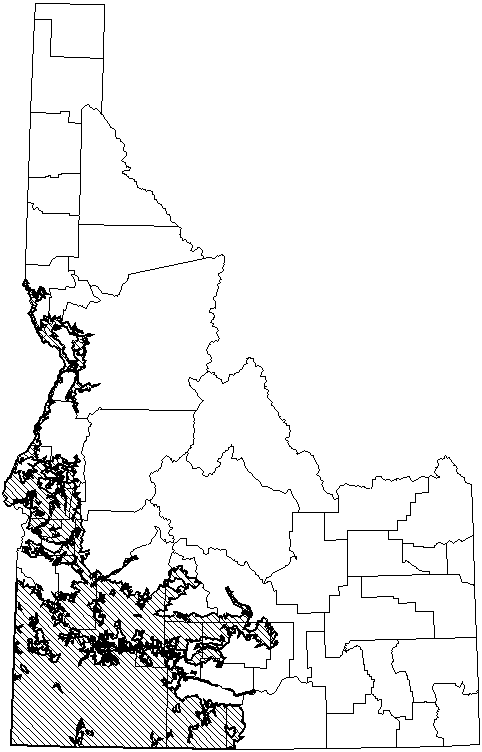
Pipistrellus hesperus
(Western Pipistrelle)
Order: Chiroptera
Order Description: Bats
Family: Vespertilionidae
Family Description:
Description:
This very small bat, which flutters during flight, has dorsal fur that is smoky to a yellowish gray brown color. The face and ears are blackish, the ears broadly rounded and short, not reaching beyond the nostrils when laid forward. The tragus , less than half of the length of the ear, is club-shaped. The calcar is not keeled.
Range:
From southeastern Washington, south through western and southwestern U.S. to Michoacan and Hidalgo, Mexico. Known to winter in Nevada, California, Arizona, and Texas, but limits of winter range are not known. Distribution in Idaho is poorly documented.
Pipistrells occur in Eastern Washington and Oregon, Western Idaho through Utah and western Colorado to Texas, south into Central American to Columbia and west into Baja California and California. In Idaho, the western pipistrelle is found in Gem, Nez Perce, Twin Falls and likely other western counties.
Habitat:
Found (up to about 2100 m) in deserts and lowlands, desert mountain ranges, desert scrub flats, and rocky canyons. In Idaho, prefers cliffs and canyon walls close to water.
Pipistrells occur in arid rocky desert canyons near water, but have been collected in lower elevation mixed conifer forests. They roost in crevices, in mines, and buildings emerging in the early evening, especially in canyon areas, where they are often seen over slack water, feeding.
Diet:
An important predator on small swarming insects, pipistrells feed on flying ants, mosquitoes, leafhoppers, and fruit flies, but often selects only one kind of insect that is abundant when feeding.
Ecology:
Pipistrells hibernate sporadically, awakening during warm periods to feed. Because they are small, they would appear to be unable to accumulate sufficient fat reserves to migrate to distant hibernal sites. As contrasted to other bat species in Idaho, they are active earlier in evenings and in the morning during early daylight but remain inactive in temporary roosts in the middle of the night. The population ecology of this species is exceptionally difficult to study as a result of the small size of individuals and the type of habitat they occupy.
Reproduction:
This species is known to swarm in large numbers, a condition that is likely important for reproduction. Mating occurs in the fall. Fertilization is delayed to spring and gestation lasts about 40 days. It has been suggested that two young may be produced but one appears to be the most common pattern, at least in California. Maternity colonies are small, comprised of fewer than a dozen individuals.
Conservation:
| Status: | Protected nongame species |
| Global Rank: | G5 |
| State Rank: | S1 |
Important State References:
Keller, B.L. 1995. The status of bat populations in the Craig Mountain Area, Nez Perce County, Idaho. Cooperative Challenge Cost-share Project, Idaho Department of Fish and Game and Bureau of Land Management, Boise, Idaho. 21pp.
Information written by Barry Keller,© 2000
Map image provided by Stephen Burton,© 2000
Design by Ean Harker©1999, 2000.

Euderma maculatum
(Spotted Bat)
Order: Chiroptera
Order Description: Bats
Family: Vespertilionidae
Family Description:
Description:
The spotted bat is distinctly colored with a blackish upper fur with patches of white over each shoulder and at the base of the tail. The ears are pinkish, long (over 40mm), and translucent in living individuals. This is the only Idaho species that has an audible echolocating call within the range of human hearing.
Range:
Euderma occur in British Columbia west to South Dakota, south to Mexico and west through California to southern Oregon. The distribution of populations is highly spotty, likely as a result of the habitat requirements of this species. In Idaho, populations occur in the south western corner of the state. An unvouchered capture along the Salmon River in Nez Perce County exists. Two voucher specimens have been collected in Idaho.
Habitat:
Found, up to 2450 m, in various habitats from desert to montane coniferous forests. In Idaho, recently observed in canyons of Owyhee County.
Spotted bats have been collected in desert pinion-juniper woodlands near sandstone cliffs or over streams and water holes in coniferous forests with rock cliffs nearby. Individuals normally roost in deep rock crevices of canyon and cliff walls but specific roost characteristics are not well documented. Two cave sightings have been reported, but likely represent unusual conditions that led to temporary use. The first specimen collected in Idaho was found under a tree in Canyon County.
Diet:
Insectivorous ; feeds primarily on noctuid moths.
Ecology:
Apparently relatively solitary but may hibernate in small clusters; winter habits are poorly known. Roosts in cracks and crevices in cliffs and canyons. British Columbia study found individuals used same roost each night from May-July, but not after early August. Individuals roosted solitarily during active season, appeared to maintain exclusive foraging areas, and foraged up to 6-10 km from day roost each night. Species forages primarily over dry, open coniferous forest. In western Texas study, nearly all individuals netted were caught after midnight. In British Columbia study, individuals left day roost an average of 49 min after sunset (13 min in radio-tagged bats), and returned an average of 67 min before sunrise; foraging activity peaked at 0000-0300 hr (emergence from day roost was not significantly influenced by moonlight). Individuals flew continuously (5-15 m above ground) between departure from and return to day roost; foraging areas of different individuals overlapped. Spotted bat calls can be detected by the human ear. Species is very sensitive to human disturbance.
Foraging activity in this bat seems to vary geographically, but often occurs over wet meadows. In British Columbia, individuals exited their roost approximately one hour after sunset and returned shortly before sunrise. In Texas, individuals apparently either exit later or drink water late as they are netted after midnight, a situation also observed in Oregon. Some research suggests this bat maintains exclusive foraging areas but tolerates overlap by other individuals while foraging. Fewer than one hundred specimens of this bat exist in museums. As a result of rarity, most netted individuals are immediately released by individuals conducting surveys.
Reproduction:
Following delayed fertilization and implantation , births apparently occur in late May or early June in southern range, possibly later in north. Female probably produces 1 young.
Conservation:
| Status: | Unprotected nongame species |
| Global Rank: | G4 |
| State Rank: | S2 |
Important State References:
Keller, B.L. 1987. Analysis of the bat species present in Idaho, with special attention to the spotted bat, Euderma maculatum. Dept. Biol. Sciences, Idaho St. Univ., Pocatello. 25pp.
Information written by Barry Keller,© 2000
Map image provided by Stephen Burton,© 2000
Design by Ean Harker©1999, 2000.

Corynorhinus townsendii
(Townsend's Big-eared Bat)
Order: Chiroptera
Order Description: Bats
Family: Vespertilionidae
Family Description:
Description:
The dorsal fur is brownish to grayish brown. The ears, which may be curled like ram horns during torpor and hibernation , are brown and long (30-39mm); the tragus is about one-half the length of the ear. Glandular lumps occur on the face between the nostrils and eyes.
Range:
A map of the state-by-state distribution of this species showing maternity sites, hibernacula , mist-net capture sites and museum voucher specimen sites was prepared in 1995 and is referenced below. This bat is found in British Columbia, east through Montana, south into western south Dakota, Nebraska, Kansas, Oklahoma and Texas, south into Mexico and along the Pacific Coastal States of California, Oregon, and Washington. In Idaho, it has been collected or observed in hibernal sites in 17 counties. Four maternity sites have been found in Boundary, Bonner, and Butte Counties. Many abandoned mine sites, often extremely dangerous to enter, are used by nonbreeding females and males for roosting in summer.
Habitat:
Townsend's bats occur in a variety of habitats from desert shrub to deciduous and coniferous forests at a wide range of elevations. In Idaho, some individuals likely migrate to hibernal sites to overwinter and disperse to forested areas during summer when the sexes separate. Other individuals found near Lake Pend Oreille seem use the same mine during both summer and winter. This species is captured or observed in abandoned mines and both unoccupied and actively used old buildings where it may be considered a pest as a result of deposition of guano and urine. In California, two radiotagged females have been relocated in tree cavities where they remained for several days. It is probable that hollow cavities in large trees or snags may constitute an important undocumented resource for maternity colonies of this species, a condition that may be displacing some nursery colonies to man-made structures.
On West Coast, found regularly in forested regions and buildings. In Texas, ranges from shrub steppe to pinyon/juniper woodlands, but is consistently found in areas with canyons or cliffs.
Diet:
C. townsendii are moth specialists. Their diet consists mostly of moths in the family Noctuidae. Beetles and flies and lesser amounts of other insects may also be consumed.
Ecology:
The winter ecology and summer distribution of this species is under intensive investigation in Idaho as a result of concern about declining numbers observed at winter hibernal sites. Mines and caves that have been surveyed by netting during summers usually yield from one to six individuals. In northern Idaho, winter hibernal sites contain fewer than a dozen individuals. The largest maternity colony, containing a total of 50 females and pups, occurs in a actively used outbuilding in Bonner County. Thermal profiles for this structure suggest pups are delivered in cooler conditions that documented in other states. In southern Idaho, several lava tube caves exist that contained from 150 to 400 overwintering individuals. The larger population has declined significantly, but it is unclear whether the decline resulted through human induced mortality as a result of disturbance, displacement, or as a result of a natural tendency for this species to shift site locations.
In western range, species seems to prefer cool, damp sites for hibernation ; hibernacula average 38° -54° F. Hibernates singly, or in clusters in some areas. Maternity and hibernation colonies occur exclusively in caves and mine tunnels. Often moves between caves, even in coldest weather. Does not use crevices or cracks; hangs from ceiling, generally near zone of total darkness (in Idaho, individuals hang in exposed, open areas of cave). Occasionally uses buildings, bridges, and tree cavities for night roosts. Forages near foliage of trees and shrubs; foraging activity usually begins well into night. Population densities of western populations are approximately 1 bat/139 ha. In Idaho, individuals are sedentary and have high degree of site attachment.
Reproduction:
Mating takes place during the fall, and ovulation and implantation in spring. A single pup is produced by each female in June in northern Idaho. Maternity colonies may require warmer temperatures to speed pup development, but more research is needed on the variation in temperatures required for successful rearing and recruitment throughout the range of this species.
Mating begins in autumn and continues into winter. ovulation and fertilization are delayed until late winter/early spring. gestation lasts 2-3.5 mo. Female produces 1 young, in late spring/early summer. Young are weaned by 6-8 wk, and fly at 1 mo. Females reach sexual maturity in first summer; males are sexually mature in second year (California). Females form nursery colonies, of up to 200 (western range) or 1000 (eastern range) individuals; males roost separately, in small groups, or singly during summer.
Conservation:
| Status: | Unprotected nongame species |
| Global Rank: | G4 |
| State Rank: | S2 |
Important State References:
Wackenhut, M.C. 1990. Bat species overwintering in lava-tube caves in Lincoln, Gooding, Blaine, Bingham, and Butte Counties Idaho, with special reference to annual return of banded Plecotus townsendii. M.S. Thesis, Idaho St. Univ., Pocatello. 63pp.
Information written by Barry Keller,© 2000
Map image provided by Stephen Burton,© 2000
Design by Ean Harker©1999, 2000.
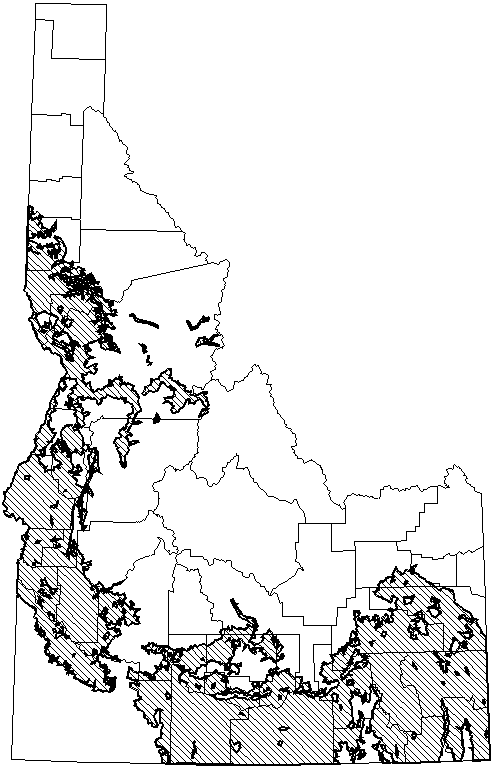
Antrozous pallidus
(Pallid Bat)
Order: Chiroptera
Order Description: Bats
Family: Vespertilionidae
Family Description:
Description:
The dorsal fur is yellowish to pale-creamish brownish. The ears are large, up to five-eights of an inch (=15mm) across at the base and broadly rounded along the margin. The tragus is less than one-half of the length of the ear.
Range:
Southern British Columbia south along the western and southern section of Idaho, most of Wyoming, and south west through Utah, Colorado, Kansas, western Oklahoma, Texas and Mexico, then west including Baja California and along the Pacific Coast through California, Oregon and the central portion of Washington. Specimens have been collected or identified at roosts in seven counties in Idaho.
Habitat:
Pallid bats frequent arid or semi-arid shrub steppe , grasslands and, to a lesser extent, higher elevation coniferous forests. They roost in rock crevices, mines, hollow cavities in trees, and occupied or vacant buildings. They may also roost in objects placed on the ground.
Diet:
This species usually feeds on ground dwelling arthropods, gleaning scorpions, Jerusalem crickets, cicadas, beetles or smaller insects associated with flowers and cactaceous plants. Lesser amounts of flying insects appear to be consumed.
Ecology:
Pallid bats are gregarious and may feed together at sites containing abundant prey. Because they have larger eyes than bats in the genus Myotis, feeding is likely aided by both sight and passive sound that indicates the location of moving prey. Maternity colonies may be large and move in relation to temperature conditions. Warmer temperatures are selected at maternity roosts. The winter ecology of this species is poorly documented. Individuals do not appear to migrate or to hibernate for long periods and individuals have been observed flying during cold weather. Night roosting individuals emit audible calls that likely indicate the location of a group to other flying individuals but the exact function of these calls is poorly understood.
Species is gregarious . Usually forms clusters in diurnal roosts (Yuma myotis may roost among pallid bats). May also gather in night roosts that are frequently near, but separate from, day roosts (40-75% of time away from diurnal roost may be spent at night roosts). Usually roosts in rock crevice or building, less often in cave, tree hollow, or mine (in Oklahoma, night roosts are typically in caves). Emerges from day roost relatively late; foraging peaks at beginning and end of nocturnal activity cycle. Captures prey on ground, after an aerial search; also takes prey in flight, within few meters of ground vegetation. Bimodal foraging and audible communication is known. Species is largely inactive in winter, and is believed to hibernate (in Idaho, species is migratory).
Reproduction:
Breeding occurs between October and February and sperm is stored until spring ovulation . Maternity colonies form in May or June. From one to three pups are born likely depending on the parity of the female.
Copulation usually occurs from October-December; fertilization takes place in spring. In U.S., usually 2, but sometimes 1, young are born from: late May-early June in California; mostly late June in Kansas; and probably early May to mid-June in Texas. Young fly at 6 wk, and are weaned in 6-8 wk. Maternity colonies are usually small, but may include up to 200+ adults, including some adult males.
Conservation:
| Status: | Unprotected nongame species |
| Global Rank: | G5 |
| State Rank: | S1 |
Important State References:
Keller, B.L. 1987. Analysis of the bat species present in Idaho, with special attention to the spotted bat, Euderma maculatum. Dept. Biol. Sciences, Idaho St. Univ., Pocatello. 25pp.
Information written by Barry Keller,© 2000
Map image provided by Stephen Burton,© 2000
Design by Ean Harker©1999, 2000.
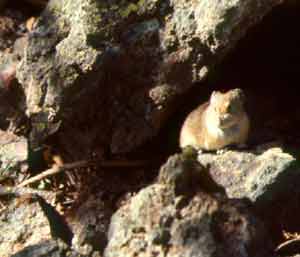
Ochotona princeps
(American Pika)
Order: Lagomorpha
Order Description:Lagomorphs
Family: Ochotonidae
Family Description: Pikas
Description:
Pikas are tailless, have somewhat circular ears, are grayish to brown and are about the size of a guinea pig. Their total length is 6.8 to 8.4 inches (170-210 mm), they weigh 5.3 to 6.2 ounces (150-175 grams). Like all lagomorphs, they have double upper incisors but the front pair is large and functional and the very small posterior pair is peg-like. Pikas have hair on their feet, an adaptation that gives them great traction as they scurry about on rocks. Pikas are recognizable behaviorally. They dart about on talus slopes and you may hear their distinct, shrill whistle call or a short “mew” that sounds like an insolent cat. Often the call will give away their presence even though you cannot sight them.
Range:
Distributed discontinuously in mountainous areas from southern British Columbia and southern Alberta, south to southern California, Nevada, southern Utah, and northern New Mexico, and east to Wyoming and Colorado. They are typically found in mountains in Idaho, but a population exists in Craters of the Moon National Monument in southern Idaho.
Habitat:
Found from sea level to 9800 feet (3000 m) in northern range, infrequently below 8200 feet (2500 m) in the southern part of their range. Restricted to rocky talus slopes, primarily talus-meadow interface. Often found on high alpine slopes at about 2700 m, above treeline up to limit of vegetation. Also found at lower elevations in rocky areas within forests or near lakes. Occasionally found on mine tailings , or piles of lumber or scrap metal. Ideal habitat includes rockslides that include rocks large enough to allow them freedom of movement under and between rocks and small patches of vegetation for food. Unique habitat in Idaho includes the Craters of the Moon National Monument where the landscape is characterized by rather recent lava flows not typical of mountain talus slopes. It has been reported that a melanistic (black) form of Pikas exists in Craters of the Moon, probably an adaptation to the black rocks.
Diet:
Feeds primarily on grasses and sedges, but also eats flowering plants and shoots of woody vegetation, even conifer twigs and lichen . They are active food storers and haul in and pile rather large quantities of vegetation in piles up to 3 feet in diameter and holding up to 50 pounds of vegetation. The “food” they cut provides them a good supply of food for the winter.
Ecology:
Active all year. Relatively inactive on warm days; may be inactive at midday in hot weather near lower elevational limit. In late summer and fall, harvests and stores food and defends haypiles built for winter consumption. May forage in winter in snow tunnels. Does not dig burrows, but may enlarge den or nest site under rock. May defend territory of about 400-700 m2; home range is about twice that size, but varies seasonally (largest during spring breeding season). Male and female territories are same average size. Adjacent home ranges tend to be occupied by opposite sexes. Colorado study found population density of 3-10/ha in favorable habitat in mid-August (same as in other regions); density-related social behavior maintains population stability. Juveniles tend to stay on natal or adjacent home range. Individuals may live 5-7 yr; adult mortality is 37-56%/yr. Pikas practice copraphagy . They do not have the enzyme necessary to digest cellulose, a main component of their herbaceous diet. Instead, they have a large caecum, or sac, in their large intestine, where various microorganisms digest the cellulose . Pikas defecate soft pellets that still contain considerable nutrients, especially vitamin B, where are not asorbed in the caecum . The soft pellets, usually deposited at night, are reingested (eaten) and the vitamin B is then absorbed in the small intestine. The final product is small, round, dry fecal pellets, about the size of a BB.
Reproduction:
Seasonally polyestrus . Gestation lasts about 30 days. Young are born May-September (possibly March in some low elevation areas). Female produces 1-2 litters of 2-5 young/litter. Young depend on mother for at least 18 days, and are weaned at 3-4 wk. Juveniles establish territories and haypiles, but do not breed until second summer.
Conservation:
| Status: | Protected nongame species |
| Global Rank: | G5 |
| State Rank: | S5 |
Important State References:
Bunnell, S.D. and D.R. Johnson. 1974. Physical factors affecting pika density and dispersal. J. Mammal 55:866-869.
Information written and photo by Donald Streubel,© 2000
Map image provided by Stephen Burton,© 2000
Design by Ean Harker©1999, 2000.

Sylvilagus nuttallii
(Mountain Cottontail)
Order: Lagomorpha
Order Description: Lagomorphs
Family: Leporidae
Family Description:Rabbits and Hares
Description:
This cottontail is grayish brown with a slight yellowish appearance above and whitish below. A diagnostic characteristic is a narrow, black line along the margin of the ear. They have a fairly large tail that is dark above and white underneath. Their total length is 13.5 to 16.6 inches (338-415 mm), tail length is 1.2 to 2.2 inches (30-54 mm), and they weigh 1.4 to 1.9 pounds (630-870 grams).
Range:
From eastern slopes of Cascade-Sierra Nevada ranges, east to western North Dakota and Black Hills, and from southern Canada south to Arizona and New Mexico.
Habitat:
Prefers brushy, rocky areas in dense sagebrush, and streamside thickets and forest edges. May sometimes climb into junipers. In southeastern Idaho, prefers areas with relatively greater amounts of forbs . They are prevalent in rock hills and canyons and may even be found in conifer forests.
Diet:
Feeds on grasses and other herbaceous and woody vegetation, including sagebrush and juniper. In Idaho, diet includes sagebrush, rabbitbrush, grasses, brush, bark, shoots, buds, and crops.
Ecology:
May be active any time of day or night, but is primarily crepuscular. Active throughout year. Uses burrows and forms. Usually feeds in or near cover. The mountain cottontail is more solitary than other cottontails. In some areas, gopher snakes and western rattlesnakes are important predators on juveniles. In Oregon study, population density ranged from 19-254/100 ha; in southern British Columbia study, density in sagebrush was 23-43/100 ha. In Idaho, species is known to carry tularemia.
Reproduction:
Breeds in late winter, spring, and summer. Gestation lasts 28-30 days. Females may produce 4-5 litters of 4-5 young/yr. Females construct small, fur-lined nests, and their young are capable of moving about independently in 4 to 5 weeks.
Conservation:
| Status: | Game species |
| Global Rank: | G5 |
| State Rank: | S5 |
Important State References:
Johnson, M.K. and R.M. Hansen. 1979. Foods of cottontails and woodrats in south-central Idaho. J. Mammal. 60:213-215.
Information written by Donald Streubel,© 2000
Map image provided by Stephen Burton,© 2000
Design by Ean Harker©1999, 2000.
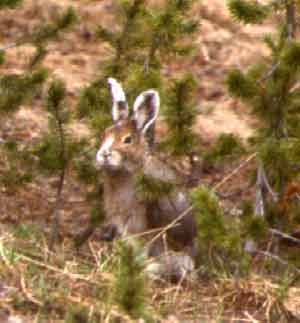
Lepus americanus
(Snowshoe Hare)
Order: Lagomorpha
Order Description: Lagomorphs
Family: Leporidae
Family Description:Rabbits and Hares
Description:
The snowshoe hare, sometimes called the varying hare, is white in winter except for black-tipped ears and gray with light flecks in summer. It has a larger body, ears and feet than the mountain cottontail. The soles of its feet are heavily furred which probably provides more surface area for movement in the snow. Their total length is 14.4 to 20 inches (360-520 mm), their hind foot is 4.5 to 6 inches (112150 mm), they weigh 3 to 4 pounds (1.4-1.8 kg).
Range:
From the Rockies, northern Great Lakes region, and New England, north through most of Canada and Alaska. Scattered populations exist in Appalachian Mountains, south to Great Smoky Mountains.
Habitat:
Prefers dense cover of coniferous and mixed forests, but will also inhabit coniferous swamps and second-growth areas adjacent to mature forests and alder fens and conifer bogs. In Idaho, most abundant in young lodgepole pine stands.
Diet:
In summer, eats succulent vegetation. In winter, consumes twigs, buds, and bark of small trees (particularly alder and balsam).
Ecology:
Mainly crepuscular and nocturnal . Populations fluctuate widely over 10-11 yr cycle. Densities may vary from 1 to several hundred/2.6 km2. Home range is typically about 4 ha; male ranges are larger (in Montana study, home range of male was 10 ha, female was 6 ha). It is an important prey item for many forest predators such as bobcats, lynx, coyotes, red fox, hawks, eagles and owls. Early Hudson Bay fur trapping records showed an intriguingly regular correlation between snowshoe hare population cycles and lynx populations. The molt from the gray coat to white occurs in fall and takes about 70 to 90 days. The change is triggered by photoperiod (changing day length).
Reproduction:
The breeding period extends from March to late August. gestation lasts 37 days. Young are born from May to September. Females produce 1 to 4 litters of 1 to 6 (average 3) young per year. Females breed in their second year. Young grow rapidly; they are weaned in about one month at about 9 times their birth weight. They reach adult size in about 5 months.
Conservation:
| Status: | Game species |
| Global Rank: | G5 |
| State Rank: | S5 |
Important State References:
No references available at this time.
Information written and photo by Donald Streubel,© 2000
Map image provided by Stephen Burton,© 2000
Design by Ean Harker©1999, 2000.
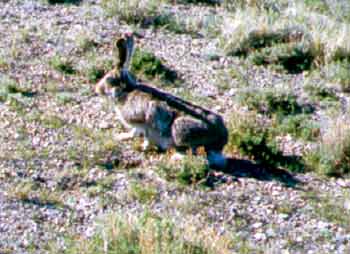
Lepus townsendii
(White-tailed Jackrabbit)
Order: Lagomorpha
Order Description: Lagomorphs
Family: Leporidae
Family Description:Rabbits and Hares
Description:
The White-tailed jackrabbit’s summer pelt is brownish with some black and tends to appear grayish, it turns white in the winter. The ears are black-tipped, even when the species turns white in winter. The tail is white but occasionally has a dark streak dorsally. It is the largest rabbit in Idaho, being 22 to 26 inches (550-655 mm) total length. This jackrabbit is capable of bursts of speed up to 40 mph with intermittent high and long leaps. It has been recorded jumping higher than 12 feet. The ears and feet of this species are smaller than the black-tailed jackrabbit (ears 3.8 to 4.5 inches; hind feet 5.8 to 6.9 inches). They weigh 6.6 to 13 pounds (3 to 6 kg).
Range:
Primarily in Great Basin and northern Great Plains, from Sierra Nevada east to Mississippi River, and from central Canada south to northern New Mexico.
Habitat:
Found in open grasslands and montane shrublands generally above shrub steppe . At higher elevations, found in open areas in pine forests and in alpine tundra . Prefers grass and scattered shrub between sagebrush and mountain forest zones, and is attracted to aspen and fir groves.
Diet:
In summer, eats grasses, forbs , and grains; may feed on cultivated crops. In winter, browses on twigs, buds, and bark. It seems to be attracted to roadsides after dark to feed on green, succulent vegetation that results from rainfall runoff from the road surface.
Ecology:
Active throughout year. Generally solitary but sometimes aggregates. Primarily crepuscular ; active in early morning and late afternoon and evening (one source reported nocturnal activity period). Rests by day, usually in shallow depressions (form) at base of bush, or beside or in cavity in snow. Occupies greatest range of any jackrabbit. Home range is about 2-3 km in diameter. Populations are known to fluctuate as drastically as with snowshoe hare. Usual population density is generally 2-15/km2, but up to 71 (Iowa) and 43 (Minnesota) per km2 have been reported. Reduction in Northwest populations has been due to overgrazing and agricultural development. They are preyed on by many predators which seems typical of all lagomorphs. There are occasional battles between males, which never seem to result in injury. Kicking with the hind feet while leaping over an opponent seems to be their offensive maneuver.
Reproduction:
Breeds from late February to mid-July in North Dakota, from May-early July in northern range. Female produces up to 4 litters/yr (1 litter in northern range) of 1-11 young. gestation lasts 5-6 wk. Young become independent in about 2 months.
Conservation:
| Status: | Predatory wildlife |
| Global Rank: | G5 |
| State Rank: | S5 |
Information written by Donald Streubel,© 2000
Photos by D.L. Chesemore and Edson Fichter, ©1961, 2001
Map image provided by Stephen Burton,© 2000
Design by Ean Harker©1999, 2000.
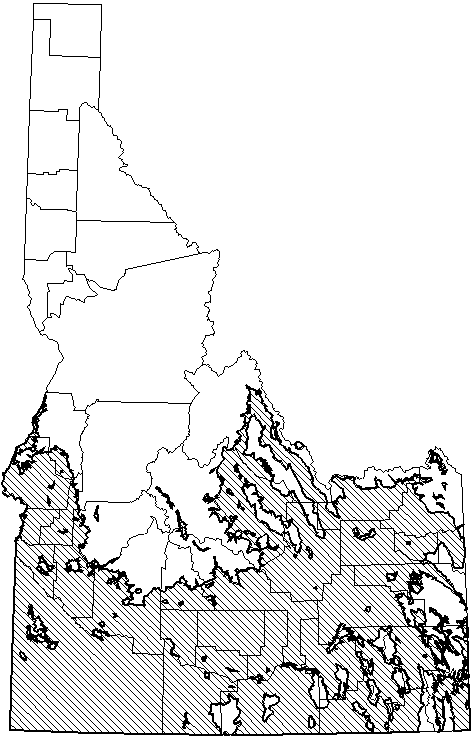
Lepus californicus
(Black-tailed Jackrabbit)
Order: Lagomorpha
Order Description: Lagomorphs
Family: Leporidae
Family Description:Rabbits and Hares
Description:
Their total length is 18 to 25 inches (465-630 mm). They have long-black tipped ears, 4 to nearly 7 inches (99-131 mm) long. Their back is gray to blackish, sides are gray, and whitish underneath. They don’t change color in the winter. Their hind feet are large. They weigh 4 to 8 pounds (1.8-3.6 kg).
Range:
From Pacific Coast, east to Missouri and Arkansas, and from Washington and Idaho, south to central Mexico. They are more abundant and widespread compared to the white-tailed jackrabbit.
Habitat:
Inhabits open plains, fields and deserts, and open country with scattered thickets or patches of shrubs. In Idaho, found in lower-elevation rangeland associated with shrub steppe communities of southern part of state; adapts well to areas of agricultural development.
Diet:
In summer, forages on grasses, forbs , crops, and hay; in winter, eats buds, bark, and leaves of woody plants. Southeastern Idaho studies reported winterfat, green rabbitbrush, cheatgrass, crested wheatgrass, and perennial grasses were primary foods. This species obtains water from vegetation and re-ingests soft fecal pellets produced while resting.
Ecology:
Active throughout year. Primarily crepuscular and nocturnal . Rests by day in shallow depression (form). May travel up to 1.6 km from daytime retreat to night feeding area. May gather in large group to feed. In northern Utah study, home range varied from less than 1 km2 to 3 km2; in Idaho study, home range was 12.5-18.2 km2. Populations are known to fluctuate markedly, slowly reaching peak over several years, and falling off rapidly in several weeks or months (in Idaho, population peaks at 10-yr cycle). Populations may increase or decrease with grazing. Both raptors and carnivorous mammals respond numerically and functionally to changes in jackrabbit abundance. Some research suggests there may be a connection between their population fluctuations and coyote population fluctuations. This species adapts better to agriculture than the white-tailed jackrabbit, thus their populations are often higher in Idaho, especially historically. They are susceptible to diseases such as tularemia , which can decimate a population, as well as tick fever.
Reproduction:
Breeding period may extend from late winter to late summer (in southeastern Idaho study, length of breeding season was variable and not affected by weather). gestation lasts 41-47 days. Females produce 1-4 litters of 1-8 (usually 2-4) precocial young each year (in eastern Idaho study, estimated production was 2.5 litters/yr). Their growth is rapid, young are nearly as large as adults in 10 weeks.
Conservation:
| Status: | Predatory wildlife |
| Global Rank: | G5 |
| State Rank: | S5 |
Important State References:
Johnson, D.R. and J.M. Peek. 1984. The black-tailed jackrabbit in Idaho: life history, population dynamics, and control. Coop. Extens. Service, Univ. Idaho, College Agricult. Bull No. 637, Moscow. 16pp.
Information written by Donald Streubel,© 2000
Map image provided by Stephen Burton,© 2000
Design by Ean Harker©1999, 2000.
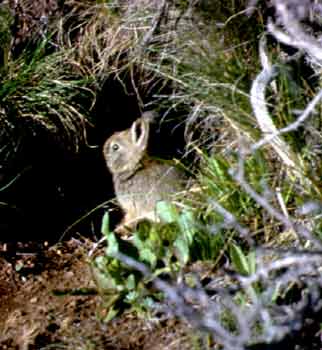
Brachylagus idahoensis
(Pygmy Rabbit)
Order: Lagomorpha
Order Description: Lagomorphs
Family: Leporidae
Family Description:Rabbits and Hares
Description:
As the name implies this is the smallest of Idaho rabbits. It differs from all other rabbits because its small, fluffy tail has no white on it. It also has much smaller hind feet than other rabbit species. The upper part of its body is buffy gray to almost black, the nape of the neck and front legs are cinnamon color. It has whitish spots on the side of its nostrils that also distinguishes it from all others. The pygmy rabbit is small, total length is 9.7 to 11.3 (250-290 mm), tail length is .75 to 1.25 inches (20-30 mm), and it weighs only 8.5 to 16 ounces (246-458 grams).
Range:
Its range is limited, from Great Basin (with isolated population in east-central Washington), north to extreme southwestern Montana. It is limited to the high plains in this area between 4500 and 7000 feet.
Habitat:
Typically found in dense stands of big sagebrush growing in deep, loose sediment. In Idaho, closely associated with large stands of sagebrush; prefers areas of tall, dense sagebrush cover with high percent woody cover.
Diet:
In Idaho, big sagebrush is primary food source, but grasses and forbs are eaten in mid- to late summer.
Ecology:
Active throughout year. May be active at any time of day or night, but is generally crepuscular . It may be the only rabbit that digs and uses a fairly complex burrow system. Burrows are an average of 7.6 cm in diameter, and may have 3 or more entrances with shallow trenches often extending out from the entrances. The entrances are often located at the base of sagebrush. They also may use badger and marmot burrows. Individuals do not appear to move far from burrow when feeding. Predators include weasels, coyotes, and owls.
Reproduction:
Breeding period extends from spring to early summer (Idaho study found males capable of breeding from January-June, females from February-June; juveniles did not breed). Gestation probably lasts about 27-30 days. Female may produce 6 young/litter . Idaho study found lower reproductive potential in this species than in most lagomorphs.
Conservation:
| Status: | Game Species |
| Global Rank: | G4 |
| State Rank: | S3 |
Important State References:
Green, J.S. and J.T. Flinders. 1980. Habitat and dietary relationships of the pygmy rabbit. J. Range Manage. 33:136-142.
Information written by Donald Streubel,© 2000
Photo by Edson Fichter, ©1999
Map image provided by Stephen Burton,© 2000
Design by Ean Harker©1999, 2000.
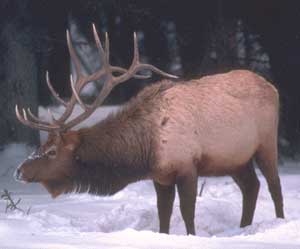
Cervus elaphus
(Elk)
Order: Artiodactyla
Order Description: Hoofed Mammals or Ungulates
Family: Cervidae
Family Description: Deer, Elk, Moose, Caribou
Description:
Elk are the second largest members of the deer family (Cervidae) behind moose, the largest. Males in Idaho will weigh between 600 to over 1000 pounds (270-450 kg), while females weigh between 450 to 650 pounds (200-320 kg). They will stand up to 5 feet (1.5 m)at the shoulder. Males have large antlers consisting of a single beam angling upward and backward for up to 5 feet from the head, with up to 6 and occasionally 7 points or tines on each side of adult bulls. Females do not have antlers. Elk have short tails, only about 3 to 8 inches (7.5-20 mm) surrounded by a tan colored rumppatch. Their backs are brownish to tan above, somewhat reddish during the summer, and their underside is darker. Males especially appear to have thick necks with a dark brown mane on their throat region. The name “elk” leads to confusion. It comes from the German word “elch” which refers to the European moose. Shawnee Indians named elk, “wapiti” which means white rump. The red deer of Europe is the same species as the elk, but it is referred to as a “deer”. Here, in North America we clearly distinguish between elk and moose, but it is confusing for European visitors.
Range:
Elk are formerly widespread in North America, but now range from southern British Columbia through parts of Alberta into Manitoba south to central New Mexico and Arizona forested mountains, and from Vancouver Island south to northern California along the Pacific coast. Isolated populations, mostly transplanted, exist in some eastern states and even into Oklahoma.
Habitat:
Their habitat varies according to location. They seem to prefer mountainous country with mixed open, grassy meadows, marshy meadows, river flats, and aspen parkland, as well as coniferous forests, brushy clearcuts, forest edges, and shrub steppe. Studies in Idaho, have shown that some populations live year-round in sagebrush desert, and that they used grass-shrub for feeding and tall shrub or pole timber for resting in spring; they fed in clearcuts and shrub fields and rested in pole timber in summer; and stayed in mesic (moderate moisture) pole timber in autumn.
Diet:
There is considerable geographic and seasonal variation in the diet of elk. However, this species is primarily a grazer, relying of grasses for most of the year, but they also consume forbs in summer, and may browse on willow and aspen where grasses are unavailable, especially during winter months.
Ecology:
They are active at night, but most active at dusk and dawn. diurnal feeding is more common in summer than in winter, but feeding periods are more prolonged in winter, and are concentrated in morning and evening. Individuals tend to bed down in meadows in the afternoon and again after midnight to chew their cud. In Idaho, and throughout the northern Rockies, herds move to lower elevations in winter to feed. Elk tend to avoid roads in all seasons. Individuals exhibit a high fidelity to their home range, but may abandon it if they are excessively disturbed. The species is gregarious , though some bulls may be solitary. Males tend to spend much of winter spring and summer in separate male groups or solitarily from female and young herds. Females form herds which includes young of the year and even some yearling bulls. Males shed antlers in March and April. They are preyed on by mountain lions and wolves where these predators are present. Grizzly bears prey heavily on calves in the spring in the first month of the lives of calves. After about a month old, calves can usually outrun grizzly bears. Coyotes occasionally will also take calves, and on rare occasions golden eagles have been known to kill a calf. Elk are heavily hunted and many populations are controlled by hunting as a recent Idaho study points to hunter access and intensity, not habitat parameters, as a major factor in population control. A Yellowstone National Park study showed 31% calf mortality during the first 28 days after birth, and in Yellowstone 68% of the total elk mortality is due to predators.
Reproduction:
In September and October, during the rut , mature bulls establish harems of up to 30 females. The bulls “bugle” which actually starts with sort of a bellow, then changes to a whistle and ends with a series of grunts. Bugling is common during the rut as the bulls are advertising their presence to their harem , and to other bulls as a challenge. There is some fighting among mature bulls during the rut , and a lot of wallowing, pawing of the ground and conducting much behavior which appears to be “marking” their “territory”, although rutting bulls are not thought of as territorial. Older, dominant males do most of mating, and younger males, although capable, rarely breed with adult females. Females breed at 2 years. Most births (late spring) are single, but twins are common. Calves are about 28 pounds at birth. Females have their young away from the herd, and commonly plant their young, spotted calf, in thick cover while they feed. After a week or two the cow and her calf will join with other females and their calves. Elk calves grow rapidly and can outrun most predators by 3 to 4 weeks of age. Gestation lasts 249 to 262 days. An Idaho study reported that winter herd composition included 16% calves.
Conservation:
| Status: | Game species |
| Global Rank: | G5 |
| State Rank: | S5 |
Important State References:
Unsworth, J.W., L. Kuck, M.D. Scott, and E.O. Garton. 1993. Elk mortality in the Clearwater drainage of north-central Idaho. J. Wildl. Manage. 57:495-502.
Information written by Donald Streubel,© 2000
Photos by Don Streubel and from © Corel Corporation, 1993 - Corel Professional Photo Series # 94000, Yellowstone National Park, #94015.
Map image provided by Stephen Burton, 2000
Design by Ean Harker 1999, 2000, 2001.
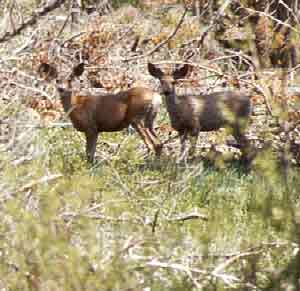
Odocoileus hemionus
(Mule Deer)
Order: Artiodactyla
Order Description: Hoofed Mammals or Ungulates
Family: Cervidae
Family Description: Deer, Elk, Moose, Caribou
Description:
Mule deer are “mule-like” in that they have large ears that seem to be constantly moving, and are about ¾ the length of their head. Their unique bounding movement is stiff-legged and almost a hop where all four feet seem to leave the ground at the same time. This contrasts to the gallop-type movement of other members of the deer family in North America. They are grayish in winter but reddish to yellowish-brown in summer. They have a white throat patch and a rumppatch that is white to yellowish. Their tail is black tipped. Males have antlers in which the main beam divides somewhat equally which can divide again forming points or tines. Bucks weigh from 110 to 475 pounds (50-215 kg), and females weigh between 70 and 160 pounds (32-66 kg).
Range:
This species ranges from southeastern Alaska, south through Canada and most of western U.S. and Great Plains, to Baja California and the southern end of the Mexican Plateau. They do range east to the western edge of Minnesota. They are common throughout the intermountain West and the northern Rockies in a diversity of habitats.
Habitat:
Mule deer are found in coniferous forests, shrub steppe, chaparral , and grasslands with shrubs, from dry, open country to dense forests. Often associated with early successional vegetation or vegetation resulting from disturbance, especially near agricultural lands. However, in southeastern Alaska, uses old-growth forests almost exclusively in winter and spring. In Idaho, prefers rocky brushy areas, open meadows, open pine forests, and burns.
Diet:
They browse on a wide variety of woody plants, primarily during the winter when snows cover grasses and forbs . Common browse plants include sagebrush, aspen, dogwood, juniper and Douglas fir. They graze on various grasses and forbs heavily during spring, summer and fall. They do occasionally feed on agricultural crops. Some studies have suggested that in the Rocky Mountains, their diet may be nutritionally inadequate during at least part of the year. They do require open areas that provide a diversity of grasses and forbs , and this is not always available in forested country.
Ecology:
Throughout year, most of their activity occurs at dawn and dusk, although nocturnal and daytime activity is common. Their home range size may be 36 to 243 ha or more; size is directly correlated with availability of food, water, and cover. In the Pacific Northwest, deep winter snows are major factors limiting population size. An Idaho study found that deer showed a high fidelity to their summer range, but less so to their winter range; deer from one summer range migrated to different winter ranges. Mule deer migrate from high, mountainous country to lower valleys and foothills during late fall to avoid heavy snow. They are a primary prey of mountain lions, and smaller mule deer are preyed on by coyotes, bobcats, and occasionally golden eagles. They are very common in Idaho and throughout the intermountain West. Bucks tend to be solitary or in small groups (2 to 4) during the rut. Does and their young (fawns and yearlings ) tend to stay together as a family group but remain separated from other similar family groups. Mule deer do herd during the winter in specific areas having a good combination of shelter and food. Severe winter conditions can reduce their populations drastically. This is probably the most common large game animal in Idaho and thousands are shot by hunters each year.
Reproduction:
The breeding season, or rut , peaks in mid-November to mid-December. gestation lasts about 203 days. In much of their range, young are born mostly in May and June; but July and August births occur in some areas. They typically have one or two fawns , depending on the age and condition of the female. Weaning begins at about 5 weeks, and is usually completed by week 16. Females usually breed at 2 years, males at 3 to 4 years.
Conservation:
| Status: | Game species |
| Global Rank: | G5 |
| State Rank: | S5 |
Important State References:
Brown, C.G. 1992. Movement and migration patterns of mule deer in southeastern Idaho. J. Wildl. Manage. 56:246-253.
Information written by Donald Streubel,© 2000
Photos by Don Streubel and from © Corel Corporation, 1993 - Corel Professional Photo Series # 94000, Yellowstone National Park, #94007, 94017.
Map image provided by Stephen Burton,© 2000
Design by Ean Harker©1999, 2000.
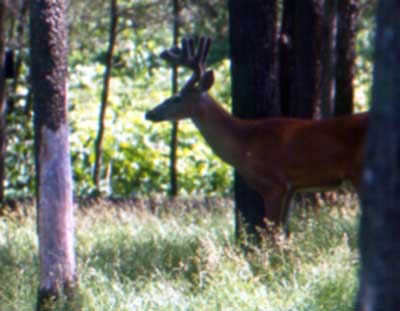
Odocoileus virginianus
(White-tailed Deer)
Order: Artiodactyla
Order Description: Hoofed Mammals or Ungulates
Family: Cervidae
Family Description: Deer, Elk, Moose, Caribou
Description:
White-tailed deer are grayish in winter and tannish to reddish brown in summer. Their underside and throat are white. They have a larger tail than the mule deer and it is not black tipped. The tail is white underneath, which brightly shows when white-tailed deer raise their tail. Antlers on bucks consist of a single non-branching beam with single, unbranched tines or points coming off the main beam on each side. This is a distinct difference from mule deer, which have branching main beams. This species is smaller than the mule deer, males weigh between 150 and 300 pounds (63-135 kg) and females from 120 to 250 pounds (54-115 kg).
Range:
The white-tailed deer is found from southern Canada, south through most of U.S. and Mexico to South America. But, it is absent from dry, desert country and foothills though much of the southwestern United States. In Idaho and some other northern Rocky Mountain states, it seems confined primarily to river bottoms and it may be expanding its range in these states. In appears to be more common in lowland areas in northern Idaho. Because their populations have increased in recent years, they have become pests in some suburban areas of the eastern U. S.
Habitat:
This species can be found in various habitats from forests to fields with adjacent cover and especially in riparian habitat and brushy, often wet, bottomlands. In northern regions, they usually require stands of conifers for winter shelter but they avoid large stands of very dense forests. In north and in montane regions, limited ecologically by depth, duration, and quality of snow cover. In Idaho, they prefer low to intermediate elevations and dense, deciduous woodlands and brush, as well as marshy areas near water.
Diet:
In the north their diet is dominated by grasses in spring, forbs in early summer, leafy green browse in late summer, acorns and other fruits in fall, and evergreen woody browse in winter. Where winters are severe they often herd up in lowland areas with dense coniferous cover in areas called “yards”.
Ecology:
White-tailed deer are active day or night, but are mainly crepuscular . Their populations consist of two basic social groups: adult females and young; and adult and, occasionally, yearling males. Adult males are solitary during the breeding season except when attending estrus females. Their home range varies from 40 to 300 acres (16-120 ha), depending on conditions. Annual home range of sedentary populations averages 145 to 1350 acres (59-520 ha). Population density has been recorded at 1 per 6 to 47 acres (2.4-18.6 ha), depending on environmental conditions. Dispersal from the mother's home range is mostly by yearling males. Home range formation may extend over 2 to 3 years. Winter weather (snow accumulation) may strongly affect populations. Because of the dense populations in their yards, they often browse so heavily on conifer twigs and branches that they damage the plants that provide their food. Repeated use of the same yards in successive winters can reduce the ability of the vegetation to support them and malnutrition and starvation can result. Because of their “yarding” behavior in severe winters, winter weather is a more important population regulation factor than predators. This species is preyed on by canids, such as coyotes and wolves, by bears and by bobcats and mountain lions in the west. White-tailed deer vocalize with loud snorts which almost sound like a whistle at times, which serves as a danger signal. They are also famous for using their tails as a danger signal. When alerted to potential danger white-tails raise their big tails which show very white and brightly in an erected position. This serves as a clear signal of danger; it also probably helps fawns keep track of their mothers as they are feeding in dense brush or other cover. Being so numerous, especially in the eastern half of the U. S. they are probably the most popular big game animal. More than a million are shot by hunters throughout the U. S each hunting season.
Reproduction:
They breeds from late October to mid-December, the rut peaking in November. A female's receptive period lasts 1 to 2 days but, reoccurs in 3 to 4 weeks if not impregnated. Gestation varies from 187 to 222 days. Females have 1 to 2 fawns (occasionally 3 in optimal habitat ) which are born May or June. The young are reddish-brown with white spots and are initially hidden for 1 to 2 weeks. They are usually weaned by 10 weeks (by fall). Females may breed during their first fall, but usually not until their second fall (1.5 years). Males reach sexual maturity around 18 months. Few individuals exceed the age of 10 years.
Conservation:
| Status: | Game species |
| Global Rank: | G5 |
| State Rank: | S5 |
Important State References:
Pauley, G.R. 1990. Habitat use, food habits, home range, and seasonal migration of white-tailed deer in the Priest River drainage, north Idaho. M.S. Thesis, Univ. Idaho, Moscow. 153pp.
Information written by Donald Streubel,© 2000
Photos by David L. Chesemore ©2001
Map image provided by Stephen Burton,© 2000
Design by Ean Harker©1999, 2000.
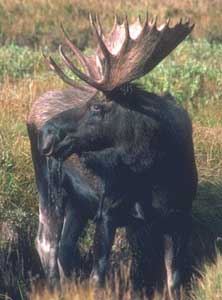
Alces alces
(Moose)
Order: Artiodactyla
Order Description: Hoofed Mammals or Ungulates
Family: Cervidae
Family Description: Deer, Elk, Moose, Caribou
Description:
Moose are the largest members of the deer family, rivaling an adult horse in size. They are dark brownish to black on their back and sides with fairly large, humped shoulders. Their long, dark hair in the winter provides them great insulation against winter cold. Both sexes have a pendulous muzzle with a large over-hanging upper lip and a dewlap or “bell” which is a large tuft of hair hanging from their throat. Males in the northern Rockies may weigh up to a 1000 pounds (450 kg), females up to 920 pounds (430 kg), but further north in Alaska, they may weigh 80 to 300 pounds more. The males have antlers unique in the deer family; they are large and palmate with tines extending off the palm part, rather than consisting of a main beam with tines or points. They may have antlers up to 80 inches across in Alaska, but less than that in Idaho. Females do not have antlers. Their large body size and long legs allow them to forage in deep snows of winter, and deep water of ponds in summer.
Range:
Moose range through most of Canada, south to Maine and west through the northern Lake States, in the west down through the Rocky Mountains through Idaho to northeastern Utah and northwest Colorado. They are circumpolar in distribution, ranging across northern Eurasia, but are called elk in Europe and Asia. They are found in some of the coldest parts of the continent during the winter.
Habitat:
Moose prefer a mosaic of second-growth forests, openings, lakes, and wetlands, but basically are inhabitants of the northern boreal forest. In Idaho, they prefer shrubby, mixed coniferous and deciduous forests with nearby lakes, marshes and bogs. They range over wide areas, and dispersing young may be found in drier parts of southeastern Idaho, which hardly resembles northern boreal forests. They seem to require water bodies for foraging and beaver ponds provide this, and hardwood or conifer forests for winter cover. They avoid hot summer conditions by utilizing dense shade or bodies of water. During hot summer days, they are known to completely submerse themselves in shallow water and mud of beaver ponds, with the exception of their nose. A northern Idaho study found old-growth grand fir and Pacific yew stands were critical components of their winter habitat. In some areas of the northern Rockies, moose are known to migrate to higher elevations during the winter, seemingly to seek out wind-blown ridges where snow depth is less and browse more attainable. Moose tend to use even-aged pole timber and open areas in summer. In southeast Idaho, they occasionally wander into towns and cities such as Pocatello and Idaho Falls. Moose are excellent swimmers and have been observed swimming across large lakes at up to 6 miles per hour.
Diet:
Moose are primarily browsers, and rely on browse much more than elk. In summer they browse on new growth of trees and shrubs, and on vegetation associated with water; they seem attracted to the high-sodium content of aquatic plants. In winter they feed on conifer and hardwood twigs. An Idaho study found menziesia , yew, alder, maple and willow were their most important diet items. Willow, aspen and fir are known to be important food for moose in most locales. Adult moose are known to consume 40 to 50 pounds of browse per day.
Ecology:
Moose can be active day or night, but they are mainly crepuscular . Depending on the habitat, their home range may reach several thousand ha. An Idaho study reported a cow's summer home range was 15.5 to 25.9 km2, a bull's was 31-51.8 km2; their winter home range was reduced to 5.2 to 15.5 km2. Population density has been reported at up to 11.6 per 10 km2, but 18 to 20 per 10 km2 was reported in un-hunted areas in eastern Quebec. Moose tend to be solitary, although cows typically have their young with them through most of the winter. Cows typically chase away their young before giving birth, but appear to occasionally accept a yearling back after the birth of their calf. They may herd in winter along river and creek bottoms where there is an abundance of willow. Snow characteristics, such as depth, density, hardness and the length of persistence of these factors, may affect populations more than predator density. Their main predators in the north are wolves, and grizzlies take calves in the spring. Human hunting and road kills can be major mortality factors in some regions. Moose do seem to adapt to humans in some areas, especially in towns and cities of Alaska. Favorable winter conditions may produce a large annual increase (20-25%) in population size. Large populations may degrade habitat, resulting in population declines, as will severe snow conditions in extremely cold winters.
Reproduction:
Moose breed in September to late October. During the rut , or breeding season, bulls can be dangerous and unpredictable. Some have been known to charge vehicles and there is an account of one charging a train. The outcome of that charge should be obvious. Cows with calves are also protective and dangerous. Gestation lasts 240 to 246 days. One calf, less commonly two, is born late May-early June. In years when winter weather is mild, and nutritional health of the female is high, there is a higher occurrence of twin calves. Calves are a lighter, almost chocolate brown to reddish in color and are not spotted. Young forage for vegetation in two weeks after birth and can move about with its mother hours after birth. Sexual maturity occurs in 1.5 years, although most males breed at 5 to 6 years due to intrasexual competition ; females reach peak productivity at 4 years.
Conservation:
| Status: | Game species |
| Global Rank: | G5 |
| State Rank: | S4 |
Important State References:
Pierce, J.D. and J.M. Peck. 1984. Moose habitat use and selection patterns in north-central Idaho. J. Wildl. Manage. 48:1335-1343.
Information written by Donald Streubel,© 2000
Photos by Don Streubel and from © Corel Corporation, 1993 - Corel Professional Photo Series # 94000, Yellowstone National Park, #94077.
Map image provided by Stephen Burton,© 2000
Design by Ean Harker©1999, 2000.
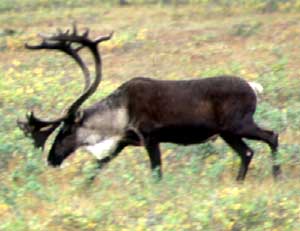
Rangifer tarandus
(Woodland Caribou )
Order: Artiodactyla
Order Description: Hoofed Mammals or Ungulates
Family: Cervidae
Family Description: Deer, Elk, Moose, Caribou
Description:
Caribou have variably brown hair on their back with a whitish neck and mane. The belly, rumpand underside of their tail are whitish. They have a large-appearing snout with short ears. Their rounded hooves contain large, soft pads in the summer, but the pads shrink and become hardened during the winter. A unique feature among the deer family (Cervidae) is that both sexes of caribou have antlers. The antlers of bulls are larger, semi-palmated with tines or points and they have a fairly large, flattened brow tine projecting forward over the forehead, referred to as a “shovel” by some observers. Antlers of cows are spindly appearing and not as long, and they lack a brow tine. Males weight between 275 and 600 pounds (115-275 kg), and females between 150 to 300 pounds (64-135 kg).
Range:
Historically the woodland caribou was found as far south as central Idaho, through the Great Lakes area and northern New England. Wild populations currently exist in Alaska, Canada, northeastern Washington, and extreme northern Idaho in the Selkirk mountains. The northern Idaho population, currently endangered, has been supplemented by transplants from Canada.
Habitat:
Caribou are found in arctic tundra , the subarctic taiga (scrub forest and open muskeg ), mature coniferous forests, semi-open and open bogs, rocky ridges with jack pine, and riparian zones. They are most often found where lichens are common. In Idaho, they occupy high-elevation open forests in winter, moves to more mature stands of timber with high lichen density for spring calving, then to shallower slopes with greater understory cover in summer, and finally to lower-elevation forests with denser overstories in fall. Northern populations migrate long distances between summer and winter habitat.
Diet:
Caribou rely heavily on lichens in the winter, but throughout the summer they eat leaves, buds and bark of trees and shrubs, grasses, sedges, forbs , mushrooms, and terrestrial and arboreal lichens (found in tree branches). Arboreallichens are probably a most important winter food in northern Idaho. In summer, they move to new areas to find new plant growth.
Ecology:
Caribou are primarily diurnal , but their feeding periods are crepuscular . They are gregarious as in the tundra , they are usually found in bands of 10-50, or in loose herds of up to a 1000. The sexes may segregate seasonally. In May females form herds after fawning. Tundra caribou may travel extensively in the summer in an attempt to avoid bothersome insects. Caribou often incur high calf losses, mostly due to predation. Survival of calves to 1 year is usually only 10 to 15%. In Idaho, grizzly bears, mountain lions, and humans are predators. The transplanted Idaho population is experiencing high levels of predation from mountain lions. As of 1995, the population in the Selkirks ecosystem had stabilized at about 50 animals. In the northern tundra wolves are a major predator. Caribou are excellent swimmers as their hollow, insulative hair provides great buoyancy. They can run for short bursts at over 40 mph, and they can move steadily for long periods of time during seasonal migrations .
Reproduction:
They breeds mostly in October. Gestation lasts about 7 ½ to 8 months. Cows bear usually 1, sometimes 2, young in May and June. Calves are precocious in that they are able to stand about 30 minutes after birth, run a bit after 90 minutes and keep up with the herd after their first day of life. They are about 11 pounds at birth and begin to eat solid food after two weeks. During the rut bulls attempt to establish harems of 12 to 15 cows and expend a lot of energy thrashing about and even battling other bulls.
Conservation:
| Status: | Protected nongame species |
| Global Rank: | G5 |
| State Rank: | S1 |
Important State References:
U.S. Fish and Wildlife Service. 1993. Recovery plan for woodland caribou in the Selkirk Mountains. Portland, OR. 71 pp.
Information written by Donald Streubel,© 2000
Map image provided by Stephen Burton,© 2000
Design by Ean Harker©1999, 2000.
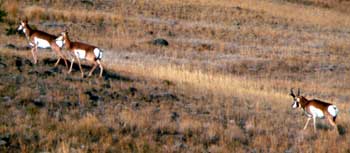
Antilocapra americana
(Pronghorn)
Order: Artiodactyla
Order Description: Hoofed Mammals or Ungulates
Family: Antilocapridae
Family Description: Pronghorn
Description:
Their upper body and back is pale tan to reddish tan, their sides, belly, inside of the legs and their rumpare white. They have two broad white bands across their throat. Bucks have a black band on the snout that extends from the nose down to a black neck patch. Both sexes have horns that are unique among the hoofed animals because the outer sheath of the horn is shed annually. The horns are black and curve backward and inward at the tips. They are between 12 and 20 inches long in males but, usually not more than about 4 inches long in females. The horn of males have a forward pointing, short branch called a “prong”, hence the name pronghorn. Pronghorns are somewhat small compared to other hoofed mammals; males weigh between 90 and 140 pounds 41-62 kg), females between 75 and 105 pounds (34-48 kg). Their large, white rump patch can serve as a danger signal when the long, white hairs are erected as danger is detected. This white patch can be seen from long distances. Their coat includes long outer, hollow hairs which provides great insulation against severe winter cold.
Range:
Pronghorns range from the southern Prairie Provinces of Canada (Alberta and Saskatchewan) east to western North Dakota, south through the intermountain Western U.S. through western Texas and Arizona to northern Mexico.
Habitat:
They are generally found on grasslands, shrub steppe, and foothills. They seem to prefer rangeland with vegetation less than 2 feet in height and wide open, expansive range. They are often found in low shrubs such as sagebrush, and grassy vegetation in arid regions with less than 10 to 12 inches of snow on the ground in the winter. This may lead them to upper, wind-swept slopes in the winter, or fairly long migrations between summer and winter range. They seem to need water within about 4 miles.
Diet:
In the winter, northern populations depend heavily on browse, especially sagebrush. In the summer, forbs are the most important; they rarely utilize grasses. Southern populations use more forbs and less browse.
Ecology:
Their daily activity pattern varies seasonally. Alternating periods of feeding and resting occur throughout day, with fairly continuous feeding in early morning and late afternoon, and longer rest periods at night. An Idaho study found that major summer feeding peaks were in early morning and late evening; they spent 30% of the day feeding, and 65% resting or loafing. Their home range varies between 0.2-0.6 km2, but an Idaho study found summer home ranges averaged about 2000 ha. Home range of yearlings was 2 to 5 times greater than adults. Large herds form in the winter but disperse in spring and form separate bachelor and female-fawn groups in spring and summer. Males associate with females in late summer and early fall. In Idaho, pronghorns typically migrate to lower elevations in winter and move back to the heads of mountain valleys in the spring. Pronghorns have some unique adaptations for their existence in open country. They have tremendous vision accommodated by an eyeball up to 1.5 inches in diameter (the size of they typical horse eye). The rods and cones of their eye are spread on a horizontal plane providing for excellent sight on a flat plane corresponding to the horizon. Most mammals’ rods and cones are concentrated in the center of the eye. This does not provide for good eyesight above them, but are known to detect movement up to 4 miles out toward the horizon. Their heart, lungs and trachea are 2 to 4 times larger than similar sized ungulates (such as goats). Their blood is very rich in hemoglobin and their muscle tissue is densely packed with mitochondria . Their leg bones are estimated to be twice as strong as cow bones, which are twice as thick. Obviously, their bones are very dense. All of these adaptations allow them to be the fastest mammals in North America. They have been clocked at nearly 70 mph and they can obtain and maintain speeds of 30 to 45 mph for fairly long distances. The dense bone prevents injuries while running at fast speeds over very rough terrain, and certain the large heart and “rich” blood accommodate their stamina. Its been estimated that if a pronghorn raced a cheetah (the fastest known mammal), the cheetah would win in a short sprint, but the pronghorn would quickly outdistance the cheetah after the sprint. Pronghorns, at times seem playful, and have been known to race along vehicles driving on roads through their habitat, and even chasing their most common predator, the coyote. Bobcats are also predators of young. Historically, pronghorns were extremely numerous throughout the west, but agricultural development, cattle grazing and construction of fences drastically reduced their populations. Many pronghorn populations have not adapted to fences and their movements, and even seasonal migrations, have been blocked by fences. Some pronghorns do crawl under fences.
Reproduction:
Pronghorns breed from mid-September to early October in their northern range, from late July to early October in the south. gestation lasts 240 to 250 days in northern range, and is shorter in south (e.g., 210-225 days in Texas), however, implantation of the fertilized egg does not occur for about a month after breeding. Births occur earlier in their southern range than in north; for example, in April and May in Texas, but late May and early June in the northern Rockies. Adult females usually give birth to twins but yearling females may produce only a single fawn. The unspotted young are weaned by 4 months, but continue to follow mother during first winter. High mortality in young is common, mostly from predation. In Idaho, a ratio of 75 fawns to 100 does is considered good. Males become territorial in mid-summer and “round up” harems of females, often up to 20. Territorial bucks mark their territorial by rubbing scent glands on the side of the neck behind the jaw on vegetation, and possibly by pawing the ground and urinating and defecating on the paw marks. They defend their territories with frequent loud “snorts”, various ritual displays, and occasionally battles and incredibly speedy chases of intruding bucks. In the wild there are few events more spectacular than two territorial bucks chasing each other at incredibly high speeds.
Conservation:
| Status: | Game species |
| Global Rank: | G5 |
| State Rank: | S5 |
Important State References:
Autenreith, R.E. and E. Fichter. 1975. On the behavior and socialization of pronghorn fawns. Wildl. Monog. 42:1-111.
Information written by Donald Streubel,© 2000
Photos from © Corel Corporation, 1993 - Corel Professional Photo Series # 94000, Yellowstone National Park, #94042 and Yellowstone- National Park Service, Nov 1999.
Map image provided by Stephen Burton, 2000
Design by Ean Harker 1999, 2000, 2001.
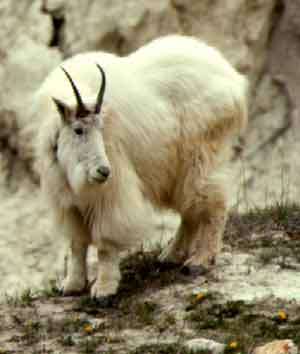
Oreamnos americanus
(Mountain Goat)
Order: Artiodactyla
Order Description: Hoofed Mammals or Ungulates
Family: Bovidae
Family Description: Goats and Sheep
Description:
Mountain goats are striking with their long, white hair that occasionally has a yellowish tan tone. In winter their hair appears long and shaggy, in summer it is shorter. Adults have long hair under their throat forming a “beard” that may be up to 5 inches long (125 mm). Both sexes have sharp pointed horns that curve up and slightly backward, in females they reach 9 inches (230 mm) in males about 12 inches (300 mm). Their hooves are well adapted to their living on cliffs and ledges, they have a hard, straight outer margin, with soft and flexible inner pads that provide excellent traction in their precarious habitat. They stand about 3 to 3 ½ feet (90 to 100 cm) at the shoulder and weigh between 100 and 300 pounds (455-135 kg). Females are about 15% smaller.
Range:
Mountain goats range from southeastern Alaska, south to Washington and the Olympic Peninsula, to western Montana and southern Idaho. They have been introduced in Colorado, Oregon, Olympic Peninsula of Washington, Beartooth Mountains of Montana, and South Dakota. Some Idaho populations were introduced outside historic range.
Habitat:
Environmental extremes characterize their habitat. They are found in high mountain alpine and subalpine habitat where extremes of temperature and weather occur. At various locations in their range they can be found from sea level to about 8000 feet (2440 m), but they are usually at timberline or above. They favor steep grassy or talus slopes, grassy ledges of cliffs, or alpine meadows. During the winter they may seek shelter and food in stands of spruce or hemlock. They seem comfortable on precarious cliff ledges and extremely steep, talus slopes.
Diet:
Mountain goats graze on grasses and forbs in summer, but also browse on shrubs and conifers. Their winter diet is often variable; they may feed on mosses and lichens , as well as grasses, shrubs, and conifers.
Ecology:
They tend to be most active from dawn to mid-morning and late afternoon to evening. They move to more sheltered habitat in October and November when snow begins to fall, and back to high alpine habitat in April and May with the spring thaw. In Idaho, they may move up to 16 km in the winter to appropriate habitat which typically is the lowest suitable range on south-facing mountainsides. One Idaho band of 10 animals wintered in only 205 acres (81 ha). Males are solitary or in small male groups most of the year, but join the female and young groups in October or November prior to the rut . There is a strong social hierarchy in female groups; the dominant are females. Adult females and young form small groups in summer. Annual home range in different areas of Montana was reported at 6-24 km2. Because they are so inaccessible they have few predators. Golden eagles are known to take young, often by forcing them off of cliffs, and cougars are known predators as well. A major cause of mortality is accidents. Their habitat is dangerous even though they are so “sure footed”; they do occasionally fall and are injured or killed.
Reproduction:
Mountain goats mate in November, but the rutting season can last into December and even January. Males do not butt heads as do Mountain sheep, but most of their rutting competition consists of threats, with occasional battles in which the males swipe their sharp horns at each other. Males have scent glands at the base of their horns, and will scent mark females they will breed with by wiping the side of their head on the female’s body. Gestation lasts about 178 days. One (sometimes 2, occasionally 3) precocial young is born in late May or early June. Often young are born in a “safe” area consisting of a narrow ledge on a cliff or very steep slope; while this may seem dangerous for the newly born young, its location probably provides protection from predators. The young are very precocial and can scamper after their mother with amazing agility. The young stays with their mother for a year until the next year’s young are born. Young are sexually mature in about 2 years, although in some areas some yearling females may breed. Young to female ratios vary between 39:100 and 72:100 were recorded in one Idaho study.
Conservation:
| Status: | Game species |
| Global Rank: | G5 |
| State Rank: | S4 |
Important State References:
Hayden, J.A. 1989. Status and population dynamics of mountain goats in the Snake River Range, Idaho. M.S. Thesis, Univ. Montana, Missoula. 147pp.
Information written by Donald Streubel,© 2000
Map image provided by Stephen Burton,© 2000
Design by Ean Harker©1999, 2000.
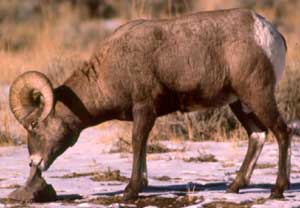
Ovis canadensis
(Bighorn Sheep)
Order: Artiodactyla
Order Description: Hoofed Mammals or Ungulates
Family: Bovidae
Family Description: Goats and Sheep
Description:
Bighorn, or mountain sheep are large, muscular appearing, with dark brown hair on top in northern populations, to a tan color in southern populations. Underneath they are white. They have a distinctive white rumppatch, along with a white muzzle and eye patch. Their tail is short and brown. Rams have massive, curled horns that curl upward and back, the tips of which can eventually reach the same level as the base of the horn . This is called a “full curl”. Ewes have shorter, more slender horns that curl much less, usually not more than a half curl. Their thick winter coat is shed in patches during the summer. Being expert climbers, their hooves are very well adapted to their climbing on rock ledges and cliffs. They have a very hard outer layer with a straight outer edge, and with a softer, almost rubbery inner section, which provides them with excellent traction. Their skull is a labyrinth of bone with hollow areas supported by bony trusses, which accommodates their head banging behavior during the mating season. Rams weigh 127 to 316 pounds (58-142 kg) and stand 3 to 3 ½ feet (90-100 cm) high at the shoulder, while ewes weigh between 74 and 200 pounds (34-86 kg) and stand 2 ½ to 3 feet (76-90 cm) at the shoulder.
Range:
Bighorn sheep range from mountains of southwestern Canada, south through the Rocky Mountains, into the Sierra Nevada range, and in desert mountains of the southwestern U.S. into portions of Mexico. Recently, in Idaho, bighorn sheep have been transplanted into historic ranges along the southern border of the state with Nevada and Utah. California bighorns, a subspecies, are found in desert canyons of southwestern Idaho, while Rocky Mountain bighorns are found in the central Idaho mountains.
Habitat:
They are found in a variety of habitats from alpine meadows high in the mountains to desert grasslands associated with southwestern U. S. mountains. With their excellent climbing abilities they are found on cliffs and canyon walls, but also in grassy foothills.
Diet:
They rely heavily on grasses which probably provides the majority of their diet, but they also include significant amounts of woody shrubs like junipers, especially in the winter, and forbs .
Ecology:
Bighorn sheep exhibit feeding peaks in early morning and at dusk that alternate with rest and rumination (chewing their cud, like cattle) periods. They are gregarious , but most of year, adult males live apart from females with young. In the winter their elevation range is often between 2500 to 5800 feet (760 to 1523 m); in the summer their elevation range varies from over 6000 to 10000 feet (1828 to 3100 m). One study reported that the January through June home range of adult females was 19-27 km2, while a Nevada study found male annual home range reached 37 km2. The carrying capacity for bighorns can be reduced by the grazing of other ungulates (cattle, burros in the southwest, etc.). In Idaho, seasonal elevation movements occur in response to winter snows or lack of water in summer. In the desert, individuals can survive 10 or more days in summer without drinking. Bighorn sheep seem susceptible to diseases. In some areas, lungworm infections may predispose bighorns to respiratory bacterial infections, and they do contract lungworms, whose life cycle involves a gastropod intermediate host. Lungworm infections has been known to cause major mortalities in some populations. Some bighorn populations, such as in Yellowstone National Park, have been known to contract “pink eye” caused by a bacterial infection of the eye. In severe cases it can cause blindness, not a good situation for an animal that lives in and around cliffs and rocky ledges. Predators include mountain lions, wolves, bobcats and coyotes. Golden eagles have been documented carrying off young lambs and even knocking them off cliffs.
Reproduction:
Their mating season varies from July through January throughout their range, but it occurs in November and December in Idaho. Gestation lasts about 175 to 180 days which in Idaho, leads to most births in May. Females usually produces 1 lamb, occasionally 2, but twins are rare. Young are weaned in 4 to 6 months (September in Idaho). Females usually begin breeding in their second year in their southern range, and third year in the northern part of their range, and occasionally in first year in some areas. Annual precipitation may affect reproductive success. Males join the ewe-lamb herds during the breeding season. Dominant males claim females in estrus, but are challenged by other males. Males then face off and batter each other head to head with incredible force. The bone structure in their skull and their large horns absorb the force, but visibly seems to occasionally leave them a bit stunned. The larger, dominant males do most of the breeding.
Conservation:
| Status: | Game species |
| Global Rank: | G4 |
| State Rank: | S4 |
Important State References:
Taylor, E., M. McCoy, and W. Bodie. 1993. California bighorn sheep ecology: habitat selection. Job completion report, Idaho Dept. Fish & Game, Boise. 38pp.
Information written by Donald Streubel,© 2000
Photos by Don Streubel and from © Corel Corporation, 1993 - Corel Professional Photo Series # 94000, Yellowstone National Park, #94043.
Map image provided by Stephen Burton,© 2000
Design by Ean Harker©1999, 2000.

Canis latrans
(Coyote)
Order: Carnivora
Order Description: Carnivores
Family: Canidae
Family Description: Wolfs, Coyotes, and Foxes
Description:
Coyotes are not as large as they appear, weighing only 20 to 40 pounds (9.1-18.1 kg). Their total length is 41 to 52 inches (105-132 cm), tail length is 11 ¾ to 15 ½ inches (30-39 cm). Their hair is long and a grizzled gray to brownish gray on top and a buff color underneath. They have somewhat long ears compared to a wolf or many dogs, and the ears are somewhat reddish on the back. They have a long, bushy tail that is black tipped, which helps make them look larger than they are. Coyotes consistently run with their tail between their legs, which helps distinguish them from wolves and most dogs. They also are known as the fastest canids as they can reach a speed close to 40 mph for short distances.
Range:
Coyotes are widespread and locally abundant in a diversity of localities throughout North America, with only widely scattered populations in southeastern United States. They are found from southern Alaska through most of southern Canada south throughout the U. S. and well into Mexico. Their range expanded into the eastern U.S. with opening of forests and extermination of the wolf as agriculture developed and expanded in the east.
Habitat:
They are found in a wide range of habitats, from open prairies of the West to heavily forested regions of the Northeast. They are even present in many urban areas, especially in western States.
Diet:
They are opportunistic feeders, feeding on carrion, small vertebrates, and invertebrates. They do occasionally feed on vegetation. Their diet has been studied extensively in southeastern Idaho, and study findings indicated cottontails, jackrabbits, pocket mice, voles, ground squirrels, and kangaroo rats dominated their diet. They are capable of preying on larger animals such as pronghorn fawns, elk calves, mule deer, and some will kill domestic livestock (especially sheep) as well. In urban areas they often prey on pet cats and smaller dogs.
Ecology:
Coyotes are known by most residents of the western U. S. because they are so common. Additionally, they have been the primary subject of much of our Native American folklore, and stories of the “old West”. Millions of dollars have been spent on eradicating them in order to prevent livestock losses, but most attempts have been unsuccessful. The conclusion that can be drawn from this is that coyotes are tremendously adaptable canids. Coyotes are active year-round; they are mainly crepuscular and nocturnal, though commonly observed during daylight hours in some areas. Their home range may reach 80 km2 or more in some areas, and may be larger in winter than in summer. Home range increases greatly after the pups are reared. An Idaho study noted 3 kinds of behavioral use of home range, resting, hunting, and traveling. Traveling behavior was observed in those parts of their home range that were little used. Typical population density is about 0.2-1.0/km2, although seasonally higher densities have been recorded in Texas. Most of a population is usually less than 3 years old. Coyotes are preyed on by wolves and cougars. Research in Yellowstone National Park has shown that wolves displace coyotes when the two species are in the same area. Since wolves were introduced to the Park in 1995, much of the coyote population has been reduced by as much as 50% by the wolves. In the Park, wolves have actually been observed running down coyotes and killing them. Coyotes are known to interbreed freely with domestic dogs, especially in the east, and they can breed with wolves. Coyotes are not considered to be as social as wolves, but in protected areas, definite packs have been observed. In the packs there is an alpha (dominant) male and female, and they are the ones that breed. Pack members do cooperate on hunts of larger prey such as sick or wounded deer, pronghorn and even elk that are near death. Their howling, important for their social structure, is used as a means of advertising their presence and location and typically occurs as a greeting when members of a pack return to a den site. They also vocalize with yips which may serve as a threat. Postures are also important in communication. Dominance is signaled by a stiff-legged gait, ears forward and erect and hair on the back erected and with the tail at about a 45 degree angle. Submissiveness can be rolling on their back, retracting their lips in a “submissive grin”, urinating, or an approach in a crouch-walk with their tail tucked or held low and face licking of the dominant individual by the submissive. Pups establish a dominance hierarchy early. Often, highest ranking and lowest ranking pups may be the first to disperse from a family group.
Reproduction:
Mating occurs in late winter and Gestation lasts 60-65 days. Litter size averages 4 to 7 young, depending on area. Young are born from March to May, and are tended by both parents. The family leaves the den when the young are 8 to 10 weeks old. Young become independent by late fall and reach sexual maturity in 1 to 2 years. Some research evidence suggests that litter size varies according to the food supply of the parents, or population density. It appears that if food is in short supply, litter size is reduced, while if food supply is plentiful, litter size is larger.
Conservation:
| Status: | Predatory wildlife |
| Global Rank: | G5 |
| State Rank: | S5 |
Important State References:
Laundré, J.W. and B.L. Keller. 1981. Home-range use by coyotes in Idaho. Anim. Behav. 29:449-461.
Information written by Donald Streubel,© 2000
Photo from © Corel Corporation, 1993 - Corel Professional Photo Series # 94000, Yellowstone National Park, #94041.
Map image provided by Stephen Burton, 2000
Design by Ean Harker 1999, 2000, 2001.
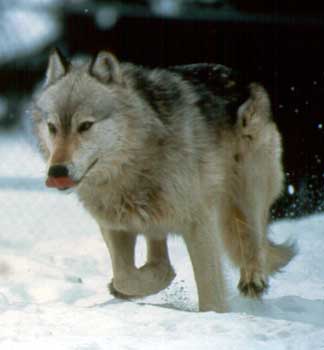
Canis lupus
(Gray Wolf)
Order: Carnivora
Order Description: Carnivores
Family: Canidae
Family Description: Wolfs, Coyotes, and Foxes
Description:
Gray wolves are the largest members of the canid family in North America. Males weigh between 45 and 175 pounds (20-78 kg) while females range between 40 and 120 pounds (18-52 kg). The largest of the reintroduced wolves in Yellowstone weighed 141 pounds. They are easily distinguished from coyotes by their large size, relatively shorter ears and broad snout. Unlike coyotes they hold their tail horizontally when running. They appear much “stockier” than coyotes. Their coloration is much more variable than coyotes, from the common grizzled, gray color to almost white to black. Their long, bushy tail is commonly black tipped. Total length is 40 to 80 ½ inches (100-205 cm), and tail length is 14 to 20 inches (35-50 cm).
Range:
Historically gray wolves were found over most of North America, but intensive and systematic shooting and trapping by humans decimated their populations by the early 1900’s. Now they are found south of Canada only in northwestern Montana, central and northern Idaho and Yellowstone National Park as a result of reintroduction in 1995 and 1996, northeastern Minnesota, northern Wisconsin, Michigan's Upper Peninsula, and Cascade Mountains of Washington near the Canadian border at Ross Lake.
Habitat:
Wolves were once found throughout Idaho, but now they are restricted to forested areas and mountainous country in central and northern Idaho. They move over vast areas in forests, high mountain valleys and in other habitat where large ungulates, their primary prey, are present.
Diet:
They prefer ungulates such as deer, elk and even bison, but they also eat beaver, snowshoe hare, rodents such as ground squirrels and mice, and carrion. In Yellowstone National Park it is not uncommon to observe wolves “mousing” in grassy meadows much like coyotes and red fox. Individuals may take livestock as secondary prey when ungulates are less vulnerable or available.
Ecology:
Wolves seem to require areas with low human population, low potential for human interactions, high prey densities, and secluded denning and rendezvous sites. These requirements restrict them to fairly large tracts of wilderness. They commonly hunt in packs that often consist of one family group of variable numbers, but up to 20 or more on rare occasions. There is a highly organized social structure in packs. The alpha male is dominant over the alpha female and other members of the pack, the alpha female is dominant over other females, and a dominance hierarchy exists among the subordinate members of the pack. The social structure results from strong bonding between the pups and the parents (usually just the alpha pair) and other members of the pack who all help care for and feed the pups. The social structure leads to cooperation during hunting and capturing prey. Wolf packs are territorial, marking their territory by urinating and defecating, and their howls also help advertise their presence and location. Besides howling, they communicate with a diverse array of postures and even facial expressions. The pups, after emerging from the natal den site are usually moved to a rendevous site, often an open grassy area within their territory. Gradually, as the pups grow they are included in hunts and taught to hunt by adults in the pack. Their summer home range may be smaller than winter range; their annual range may reach several hundred km2. Individuals may occasionally move several hundred km, especially when dispersing. Because of their large range and territories, population density is typically low. Prior to introduction in Idaho, where wolf activity was closely linked to seasonality of ungulate movements, population density of naturally occurring wolves was unknown, but was probably very sparse. The total population was estimated at 15 animals in early 1980's. In 1991-92, wolves were documented in Bear Valley (Valley Co.) and Kelly Creek drainage (Clearwater Co.). Then in 1995, 15 wolves were released along Middle Fork of Salmon River in the Frank Church River of No Return Wilderness; in 1996, 20 more wolves were released in same general area. Those wolves currently roam throughout central Idaho and adjacent areas of Montana. Their population is currently (late 2000) estimated to be in excess of 150 wolves. During 1995 and 1996, wolves were also reintroduced in Yellowstone National Park, and that population is currently (late 2000) estimated at close to 200 wolves. Because wolves prey on large ungulates, they are selective predators. They typically only prey on old, sick or young members of their prey population. In this sense, some biologists refer to their predator habits as having a “cleansing” effect on the prey population. Besides humans, wolf pups could be preyed on by bears, but their large size precludes them as targets by other predators. While they appear to be large and ferocious predators there have been very few documented instances of wolves attacking humans.
Reproduction:
Wolves breed between January and March. The dominant male and female mate and rear 1 litter of 4 to 10 young (average 6-7) per year. In some instances more than one female in a pack mates with the dominant male. Gestation lasts 63 days. Young are born in late April or early May. Pups are weaned in about 50 days (5 weeks has also been reported). Some offspring remain with the pack; others disperse as they mature. The den in which the pups are born is usually in a secluded, sheltered location, and it is often used for more than one year. Females stay with the young for the first month or two while other pack members bring food to her and her pups.
Conservation:
| Status: | Protected nongame species |
| Global Rank: | G4 |
| State Rank: | S1 |
Important State References:
U.S. Fish and Wildlife Service. 1994. Final Environmental Impact Statement. The reintroduction of gray wolves to Yellowstone National Park and central Idaho. Helena, MT. 441pp.
Information written by Donald Streubel,© 2000
Photo from Yellowstone- National Park Service, Jan 2001.
Map image provided by Stephen Burton,© 2000
Design by Ean Harker 1999, 2000, 2001.
Vulpes vulpes
(Red fox)
Order: Carnivora
Order Description: Carnivores
Family: Canidae
Family Description: Wolfs, Coyotes, and Foxes
Description:
Red fox are small, active canids with a reddish-brown coat above, with white underparts except for a black tipped nose and lower legs. It also has a large, very noticeable, bushy tail that is white tipped. This species has several different color phases including a melanistic or black phase. This black phase often has white-tipped guard hairs that gives it a grizzled or silvery appearance; it is commonly called the silver fox. There is a “cross fox” color phase that has a blackish or brownish color across the shoulders and down the back. This is a common color phase throughout the Rocky Mountains. Average weight of red fox varies between nearly 8 to 15 pounds (3.6-6.8 kg). Total length is 35 to 40 3/8 inches (90-103 cm), tail length is 13 ¾ to 17 inches (35-43 cm).
Range:
The red fox is widely distributed throughout most of North America north of Mexico, except for parts of the Southwest and along the southern Pacific coast.
Habitat:
They are found in a variety of open and semi-open habitats including riparian zones and transitional areas between forest and open habitat. These are typically areas where there is a high density of small mammals. They usually avoid dense forests, but frequently occurs in open woodlands. They are sometimes found in suburban areas.
Diet:
The red fox is an opportunistic omnivore eating small mammals, carrion, birds, insects, considerable fruits and other plant foods. Rabbits and hares often comprise a major part of their diet as well as mice.
Ecology:
Red fox can be quite common, but are rarely seen. Their shy and nervous habits, have earned them a reputation as being “clever”. Perhaps this reputation comes from the fact that they have been observed cooperatively hunting where one might chase a rabbit toward the other. They are mainly crepuscular and nocturnal, and they seem very stealthy. Summer home range varies from 57 to 518 ha; winter range is more extensive. Home range diameter is usually 2 to 4 km, but may reach 8 km or more if food is scarce. Recorded population density averaged 1 family (approximately 7 foxes) per 10 km2. Red fox populations are typically reduced by the presence of coyotes, while in the presence of wolves (which tend to displace coyotes), their populations will be higher. Human-caused mortality includes shooting, trapping, and roadkill. Young red fox seem to be especially susceptible to road kill. This species seems to be susceptible to rabies. It is one of the most widely distributed carnivores in the world. Red fox are classic “mousers”. They hunt fields where there is an abundance of mice by stalking very slowly, listing for mice rustling about in the grass. When one is located they jump spectacularly high and pounce on the mouse. A quick snap of their canines and the mouse is dead and becomes a meal. Red foxes typically don’t run down their prey as do most other canids. Young foxes are preyed on by coyotes and larger raptorial birds. Red fox have traditionally been the “enemy” of farmers because they do occasionally take chickens and other domestic stock.
Reproduction:
After hunting together as a pair, they breed in January or February. Gestation lasts 51 to 56 (average 53) days. The female produces a litter of 1 to 10 (average 4-5) young, born in March or April. The male and female may divide the young between 2 dens. The male helps care for the young by bringing food into both the mother and the young. The young emerge from the den after about 5 weeks, when they begin to learn to hunt. After about 12 weeks the young begin to disperse, often for long distances. They reach sexual maturity the winter after birth. Red fox use dens for birthing and caring for the young, but they don’t have winter dens. They merely curl up in the snow with their large bushy tails over them to help maintain their body heat.
Conservation:
| Status: | Game species |
| Global Rank: | G5 |
| State Rank: | S5 |
Important State References:
Fichter, E. and R. Williams. 1967. Distribution and status of the red fox in Idaho. J. Mammal. 48:219-230.
Information written by Donald Streubel,© 2000
Photo from Yellowstone- National Park Service, Jan 2001.
Map image provided by Stephen Burton, 2000
Design by Ean Harker 1999, 2000, 2001.
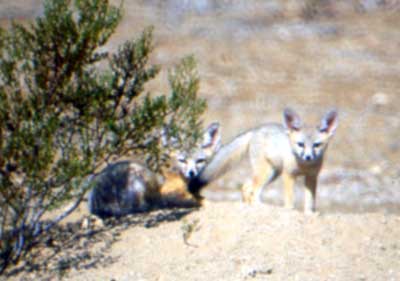
Vulpes macrotis
(Kit fox)
Order: Carnivora
Order Description: Carnivores
Family: Canidae
Family Description: Wolfs, Coyotes, and Foxes
Description:
Kit foxes have a slim body, with ears that are relatively much larger than any other member of the family Canidae, and its tail is long and bushy, about 40% of its total length. The legs look long and slender, typical of the red fox, and the soles of its feet have hair. The nose appears long and slender. Dorsal coloration in a light grizzled or yellowish-gray. The grizzled appearance is from guard hairs that are tipped with black. Its color on the sides and underneath varies from light buff to white. Total length is 28 ¾ to 33 inches (66-82 cm), the tail is 10 ¼ to 12 5/8 inches (26-32 cm), weight is about 4.25 to nearly 5 pounds (1.9-2.2 kg).
Range:
The kit fox ranges over the Great Basin from southwestern Idaho and southeastern Oregon south and east through Utah and southern Wyoming, into central California, Arizona, New Mexico, western Texas and south into northern Mexico. It is typically found in the deserts of this region. In Idaho, the species has been recorded only in Owyhee, Elmore and Oneida counties.
Habitat:
The kit fox is an inhabitant of dry country. They are found in desert and semiarid regions. They prefer flat, shrub-grass communities with very sparse ground cover and light, desert soils. They also occupy sand dunes which often have more cover. Throughout the Great Basin, they occur in shadscale, greasewood and sagebrush.
Diet:
They are primarily, predators on rodents. They seem to rely on jackrabbits and kangaroo rats, but also take various ground nesting birds, reptiles and insects.
Ecology:
Kit foxes hunt and forage for food at night, but little information exists on their habits in Idaho. Den sites consist of a narrow tunnel entrance, usually with more than one entrance, ranging from 2 upward (24 entrances were recorded at a kit fox dens site), and the dens range from 10 to 20 feet long (3-6 m) and reach depths of about 48 inches (121 cm). Dens appear to be somewhat clustered, but most in a particular area are vacant. A pair of foxes will use more than one den per year. population density in Utah ranged from 2 adults per 640 acres (259 ha) to 1 adult per 640 acres (259 ha). Little information is available on their home range requirements, but in Utah, kit foxes rarely ranged more than 1.9 miles (3 km) from their den site. Home range of different families overlap, but they usually don't occupy the same area at the same time. There is no evidence of territorialism or territorial marking in kit foxes. Their populations have been decimated by indiscriminate hunting, trapping and rodent poisoning.
Reproduction:
Females search for den sites in early Fall, and males join them in late Fall. Breeding occurs in December and January. After a Gestation period of 49 to 56 days, young are born in February or March. Males help the female raise the young by bringing food into the den. It appears that some pairs mate for life, but there is evidence that they don't hunt together. Pups emerge from the den after about 30 days, and begin to hunt with the parents at 3 to 4 months. Pups usually begin dispersing in October.
Conservation:
| Status: | Protected nongame species |
| Global Rank: | G? |
| State Rank: | S? |
Information written by Donald Streubel,© 2000
Photo by David L. Chesemore ©1995
Map image provided by Stephen Burton,© 2000
Design by Ean Harker©1999, 2000.

Ursus americanus
(Black Bear)
Order: Carnivora
Order Description: Carnivores
Family: Ursidae
Family Description: Bears
Description:
Black bears are smaller than grizzlies, they are dark in color from almost coal black to black with some brown and tan on their snout.The snout and forehead form a rather straight slope, rather than the convex forehead of a grizzly.They usually lack a hump across the shoulders and they have shorter front claws than a grizzly, about 1 ½ inches long. They occur in different color phases. Here in the Rocky Mountains they can be brown in color, called “cinnamon” bears, and along the coast of northern British Columbia and southern Alaska there is a “blue” phase and a nearly white phase. Males weigh 250 to over 500 pounds (112-225 kg), females are smaller weighing between 225 and 450 pounds (100-200 kg). Some people confuse the brown phase or cinnamon bear with grizzlies. Black bears are more common than grizzlies in Idaho. Total length is 4.5 to 6.5 feet (137-188 cm), tail length is 3 to 7 inches (77-177 mm).
Range:
Throughout North America north of central Mexico; absent from southwestern United States.
Habitat:
Prefers mixed deciduous-coniferous forests with thick understory, but also occurs in various other situations.
Diet:
Opportunistic omnivore; feeds on plant and animal food, including carrion and items from garbage dumps. Idaho study found individuals fed on forbs/grasses in spring, and mast in summer and fall.
Ecology:
Black bears are primarily nocturnal and crepuscular. During the day they rest in day beds usually in forest cover in slight depressions in the ground. They hibernate for 5 to 7 months in their northern range, from about November until April. Their hibernation is not as physiologically deep as some of the rodents, but they are in a deep sleep from which they only periodically arouse. There is no excrement in their hibernation den indicating that they do not defecate while hibernating. However, females do have their young while in hibernation. When inactive in hibernation, they occupy a den under a fallen tree, in a ground-level or above-ground tree cavity or hollow log, in an underground cave-like site, or even on the ground surface in dense cover. In an Idaho study, females used uncut timber for bedding, open timber and shrub fields for foraging and bedding, and riparian areas for feeding and travel corridors. Their home range averages around 28 to 40 km2, but may reach several hundred km2 in some areas. An Idaho study reported 13.5 km2 for males, and 2.7 km2 for females. Female and sub-adult home range is typically much smaller than that of adult males. In Idaho black bears move to higher or lower elevations in response to abundant food such as berries. Population density estimates in different areas were 1 bear per 1.3 to 8.8 km2. In Idaho recorded density was 1 bear per 1.3 km2. Habitat quality affects breeding age and litter size. JA southern Appalachian study found enhanced productivity and survival of young when fall food supply, especially hard mast (nuts), was favorable. Idaho has a bear hunting season and adult males are most susceptible to hunting. Historically they have been hunted for their meat and their fur. Apparently, the guards at Britain’s Buckingham palace wear black hats made of black bear fur. Black bears are dangerous. Females with cubs and bears that have become acclimated to human garbage have been known to attack and even kill humans.
Reproduction:
Black bears breed in June and July. Implantation of the fertilized egg is delayed about 4 months until about November. Young are born nearly naked, their eyes are closed, and they only weight about ½ pound. They nurse while the mother is hibernating, and by about 4 to 5 weeks their eyes open. The cubs are only about 6 to 8 pounds when they emerge from hibernation with their mother. Total Gestation lasts 7 to 7½ mo (average 220 days). Females give birth every 2 years at most; litter size varies from 1 to 5 (average 2). The young remain with the mother until the fall of their second year. Females first give birth at 2 to 5 years (usually 4-5 yr). Males take no part in caring for the young, females aggressively defend their young by chasing off males.
Conservation:
| Status: | Game species |
| Global Rank: | G5 |
| State Rank: | S5 |
Important State References:
Beecham, J.J. 1983. Population characteristics of black bears in west central Idaho. J. Wildl. Manage. 47:405-412.
Information written by Donald Streubel,© 2000
Map image provided by Stephen Burton,© 2000
Design by Ean Harker©1999, 2000.
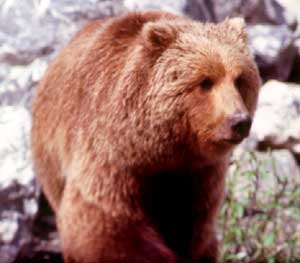
Ursus arctos
(Grizzly or Brown Bear)
Order: Carnivora
Order Description: Carnivores
Family: Ursidae
Family Description: Bears
Description:
Grizzly bears are called “grizzly” because of the white or frosted tips of the hair on their upper side.This gives them a “grizzled” appearance. They have a range of colors, from some being almost black, much like a black bear, to grizzled brown, to a blonde or even almost a chocolate brown color.They are larger than black bears, their adult weight ranges from 325 to 1700 pounds (150-785 kg).The wide range of weight occurs because coastal bears in Canada and Alaska have an abundance of food from spawning salmon, while bears living in the interior in places like Glacier and Yellowstone Parks rarely weigh more than 550 to 600 pounds.A distinguishing difference is the line of the forehead to the snout is concave (rather than straight in the black bear), and adults have a fairly distinct hump across their shoulders.Their claws are much longer, up to 4 inches in adult grizzlies, which helps distinguish the track from a black bear.Total length is 6 to 7 feet (180-213 cm), tail length is about 3 inches (76 mm).
Range:
Historically, the grizzly ranged over most of western North America, except in very dry regions.It currently is found in Alaska, northern and western Canada, the Cabinet-Yaak mountains of northwestern Montana, the Northern Continental Divide Ecosystem in Montana (Glacier Park region), the Selkirk Mountains in on the Montana and Idaho northern border, the northern Cascades (Washington), and the Yellowstone Park ecosystem(Wyoming/Montana/Idaho).It is most common in Alaska parts of Canada in large wilderness areas.In the lower 48 states (those south of Canada) the grizzly bear’s range is estimated to be 1 to 2 percent of its former range, and its population may be as low as 1 percent of it historic population size.
Habitat:
Mostly arctic or alpine tundra and subalpine mountain forests. In Idaho, occupies lodgepole pine/Douglas-fir forests near Yellowstone, and cedar/hemlock, spruce-fir, lodgepole/larch, and shrub fields in Selkirk Mountains. In the southeastern part of Idaho, adjacent to Yellowstone, grizzlies are still occasionally attracted to garbage left in the open by ill informed recreationists.This usually leads to the bear either being killed or captured and transported elsewhere.
Diet:
The grizzly is certainly considered a carnivore, but its diet is dominated by plant material. It also eats carrion, especially in the early spring after emerging from hibernation, mammals, fish, insects, and garbage. In the Yellowstone area a study found ungulate remains composed major part of early season diet, graminoids (grasses) dominated in May and June, and whitebark pine seeds were important in late season prior to hibernation; berries composed minor portion of scats in all seasons. Selkirk study reported extensive feeding on huckleberries in summer.Grizzly bears prey on elk and moose calves in the spring when the calves are first born.By the end of 4 weeks after birth, elk calves can usually outrun grizzlies.Grizzlies rarely prey on adult ungulates, unless the animal is wounded or unhealthy.Most adults can outrun a bear.
Ecology:
Grizzlies tend to be crepuscular, their least activity occurs at midday, but much individual variation exists. Like black bears, they often rest in day beds in forest cover.They hibernate and enter dens in October and November, emerging in April and May (in Idaho, hibernation occurs October through April).They typically dig their own den, usually on steep northern slope where snow accumulates. They rarely use the same den more than once.Individuals may congregate in areas with abundant food, but are otherwise solitary, except when breeding or caring for young.Males do not help care for young.A Yellowstone region study found that berry crop scarcity and large pine seed crop fluctuations were major factors limiting bear density. In the fall, prior to hibernation, whitebark pine nuts are a preferred source of food.Their home range exhibits much variation among areas, seasons, and individuals.A Selkirk mountain study reported adult home ranges of 226 to 454 km2, with male range generally larger than a female's. Density of the Selkirk population was about 1 bear per 40 km2. Mortality in Selkirk population is primarily due to illegal shooting.In the Yellowstone region, a major source of mortality occurs during the elk season.Grizzlies are attracted to elk carcasses left by hunter, often while the hunters are transporting part of their elk to their camps.Upon return the hunter may find a grizzly feeding on the elk that the hunter shot, and an aggressive grizzly usually ends up being shot.Educational programs are now trying to convince hunter to use pepper spray rather than guns to chase off the grizzly.Grizzlies are fast runners.They can run down elk calves, and they have been clocked at speeds over 30 mph.Obviously, a human cannot outrun them, and one shouldn’t try.We all know that in contrast to black bears, grizzlies can’t climb trees.Not true!There have been a number of observations of young grizzlies climbing trees, and on one instance in Alaska, actually climbing a tree to attack a human who had retreated up a tree.They are not as adept at climbing as black bears, and it seems that only smaller grizzlies climb.While their populations in the lower 48 states are low, they have recently stabilized.The enactment of the Endangered Species Act probably prevented the extinction of grizzlies in the lower 48 states.
Reproduction:
Grizzlies breed late spring-early summer, the females at 2 to 4 yr intervals. During courtship and mating, the males may be with a female for up to two weeks. Implantation of the fertilized egg is delayed; Gestation lasts about 184 days.Young are born in hibernation in January. Litter size varies from 1 to 4 (average 2). Young remain with their mother first two winters, but are usually forced to leave in the spring when the female is courted by a male. Females breed first at 5 to 6 years of age, in their southern range, 6 to 9 years in the north.With such a low reproductive potential and loss of habitat, it is no wonder that their populations are endangered.
Conservation:
| Status: | Protected nongame species |
| Global Rank: | G4 |
| State Rank: | S1 |
Important State References:
McCracken, J.G., D. Goble and J. O'Laughlin. 1994. Grizzly bear recovery in Idaho. Idaho Forest, Wildlife and Range Policy Analysis Group. Univ. of Idaho. Moscow. 110pp.
Information written by Donald Streubel,© 2000
Photos by Don Streubel and from © Corel Corporation, 1993 - Corel Professional Photo Series # 94000, Yellowstone National Park, #94080.
Map image provided by Stephen Burton, 2000
Design by Ean Harker 1999, 2000.
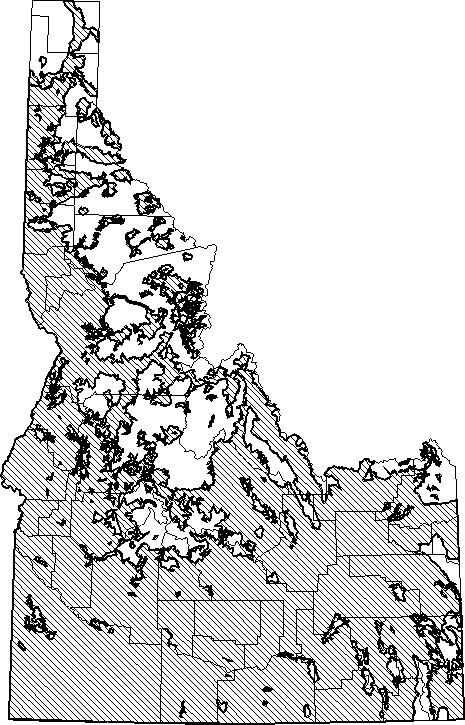
Procyon lotor
(Common Raccoon)
Order: Carnivora
Order Description: Carnivores
Family: Procyonidae
Family Description: Raccoons
Description:
Raccoons have a distinctive “bandit mask” formed by the dark blackish hair around its eyes and cheeks, offset by whitish hair over the rest of its face. Its skull is rather broad, but its muzzle is pointed and thin. Their hair on their back and sides is grizzled (dark with white on the tips) grayish to blackish, but often with rusty red or brown mixed in, underneath they are grayish brown. Their tail is distinctively round with 5 to 7 conspicuous light colored rings. Their distinctive coat has been made into many raccoon coats and hats earlier in the 1900’s and a “coonskin” hat was the trademark of Davy Crockett. They are known for their mischievous habits. Total length is 26-42 inches (655-1050 mm), tail length is 8 to 14 inches (200-350 mm) and they weigh 8 to 20 pounds (3.6-9 kg).
Range:
Raccoons range from southern Canada through most of the U.S. into Mexico and central America.
Habitat:
Found in various habitats including farm fields and forests, but usually along rivers, streams and shorelines. In Idaho they are found usually along rivers and streams as well as irrigation canals. They are not usually found in dry sagebrush habitat.
Diet:
Raccoons are opportunistic omnivores; eating fruits, nuts, berries, corn where grown, insects, small mammals, birds' eggs and nestlings, reptiles' eggs, frogs, fishes, aquatic invertebrates, worms, and garbage. Because they rely so heavily on riparian habitat and marshland, they also eat crayfish, clams, crabs, waterfowl eggs, reptiles and amphibians. They are also known to prey on young muskrats.
Ecology:
They often forage along streams obtaining most food on or near the ground, near water. In the past it has been said that they “wash their food”. However, that is not accurate. They often wriggle their food in water, which may help sensory receptors on their front paws. It is thought that their sense of touch may be better when their “hands” are wet. They are primarily nocturnal and crepuscular. They may become dormant when their foraging trails are covered by deep snow, but they are not known to hibernate. However, during the winter they do lose a large amount of fat that they acquire during the summer and fall. Young may be more active than adults in colder, subfreezing weather. Activity seems to be reduced on nights of full moonlight, which is often the case with many other smaller, nocturnal mammals. When they are inactive, they seek shelter under logs or rocks, in tree holes, or in bank dens. Their average home range varies from 36-61 ha. Population density has been recorded at 1 individual/4-6.5 ha. Individuals are typically solitary, unless female is with young. Male raccoons may be territorial with other males, but not with females. Females don’t appear to be territorial. Because they acclimate to human garbage they often become masters at raiding garbage cans in campgrounds or in suburban areas.
Reproduction:
Male raccoons become sexually active in January and February and actively seek receptive females. Many males remain sexually active into July, when females that were not successful breeders early in the season may be bred again. Most young are born in late April and early May, but some births, probably from second breeding attempts, may occur as late as September. Their kits remain in the den for 8 to 10 weeks, when they are weaned and begin to forage with the mother. Gestation lasts 63 days. A female produces 1 litter of 3 to 7 young (average 3-4). Young are weaned at 10 to 12 weeks, stay with mother through winter or until next litter is born, and reach sexual maturity in 1 to 2 years. The percentage of yearlings breeding varies annually and/or regionally. Males mate promiscuously.
Conservation:
| Status: | Game species |
| Global Rank: | G5 |
| State Rank: | S4 |
Information written by Donald Streubel,© 2000
Map image provided by Stephen Burton,© 2000
Design by Ean Harker©1999, 2000.
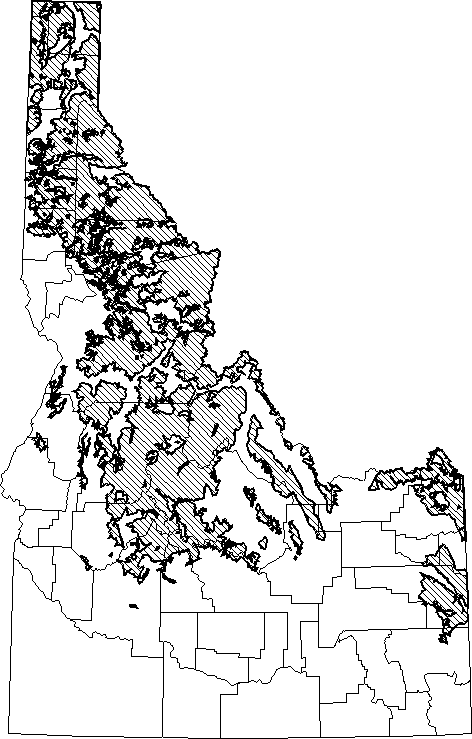
Martes americana
(American Marten)
Order: Carnivora
Order Description: Carnivores
Family: Mustelidae
Family Description: Weasels, Skunks and Others
Description:
Sometimes called the American Marten or the Pine Marten, this member of the weasel family is typical with a long, slender body and pointed face, beautiful, silky fur and a long bushy tail. Its legs are longer and its tail bushier than weasels. Its color is variable but usually brown to almost black on top, sometimes a yellowish brown on top, while underneath it is dark except for a creamy white to orange throat patch. Its legs and feet are usually black. Its tail, about one-third its body length, is very dark. An expert tree climber, it has longer legs than most members of the weasel family and semi-retractile claws. Total length is 18 to 26 inches (460-660 mm), tail length is 5.4 to 6.4 inches (135-160 mm), and they weigh 1 to 3 pounds (400-1400 g).
Range:
It ranges throughout Canada and Alaska in the northern boreal forest, and south through the Rockies and Sierra Nevada ranges, and into the northern Great Lakes Region, and northern New England.
Habitat:
It is usually found in dense, deciduous, mixed, and especially in coniferous upland and lowland forests. In Idaho it is usually found in conifer forests, which include fallen logs, stumps and shrubs. It may use rocky alpine areas. In the central Rockies, it is associated in winter mainly with old-growth forests. An Idaho study found the species used a variety of forest types, but greatest activity was in older stands of spruce-fir.
Diet:
Diet consists mainly of small mammals such as red squirrels and chipmunks, which they often capture by climbing up into trees to prey on. They also eat red-backed voles and meadow voles, and even snowshoe hares, plus birds, insects, and carrion. An Idaho study found that voles were a primary item in their diet. They also eat berries in the late summer. A Grand Teton study showed that from analyzing food items in scats, small mammal remains were found in 90.2 %, birds in 7.2%, insects in 17.4 %, and fruit and berries in 6.2% of the scats analyzed.
Ecology:
In the late 1800's the marten was abundant in the United States, but a tendency toward curiosity that exposes it to easy trapping led to its rapid decline. Heavy trapping nearly decimated the species by the turn of the century. In Europe, royalty commonly wore the fur of the sable, the marten's European (Old World), close relative. Martens are territorial animals. A study in Grand Teton National Park showed that males had territories of 0.9 square miles (2.3 square kilometers), and females had territories of 0.4 square miles (1.1 sq. kilometers). Males and females excluded other members of their gender from their territories, but a male's territory usually overlapped with one to several female territories. Activity may peak at dusk and dawn in summer; individuals have been frequently observed by day in winter. In the Sierra Nevada, foraging activity was observed to be nocturnal in winter, diurnal in summer, and apparently synchronous with activity of prey. For many years the marten was thought to be a primary predator on red squirrels and that they foraged mainly in trees. However, recent studies have shown that they forage primarily on the ground, but also in trees. There is evidence that they track and ambush prey, they use hunting perches, and they rob bird nests. When they are inactive, they occupy holes in dead or live trees, or in abandoned squirrel nests, in the dense crown of conifers, rock piles, burrows, or snow cavities; in winter they mainly use subnivean (under the snow) sites, often associated with coarse woody debris. Densities of l-2/km2 have been recorded in early fall. Some studies suggest species is old-growth dependent. A northern Idaho study of habitat use was initiated in 1995 by the Idaho Dept. Fish & Game. An early naturalist attributed "sky diving" to martens. Snow tracking provides evidence that, when descending a tree, they will occasionally leap out and away from the tree into the snow, often from a height of several meters. One study has reported several marten vocalizations, including huffs, growls, screams, and even chuckles.
Reproduction:
Females achieve estrus during mid-summer, when they frequently scent mark their territory by urinating often and rubbing abdominal glands on sticks, rocks and logs. Breeding occurs after a courtship period that may last up to 15 days. Interestingly, the fertilized eggs are held in an arrested state of development until February or March, when they implant into the uterus. About 25 to 28 days later the young are born. This "delayed implantation" occurs in most other members of the weasel family, as well as in bears. The young weigh only about one ounce (30 g) at birth, weaning begins by week 6 or 7, and by 3 months they are nearly full grown and on their own. Young become sexually mature in their second year.
Conservation:
| Status: | Game species |
| Global Rank: | G4 |
| State Rank: | S4 |
Important State References:
Koehler, G.M. and M.G. Hornocker. 1977. Fire effects on marten habitat in the Selway-Bitterroot Wilderness. J. Wildl. Manage. 41:500-505.
Information written by Donald Streubel,© 2000
Map image provided by Stephen Burton,© 2000
Design by Ean Harker©1999, 2000.
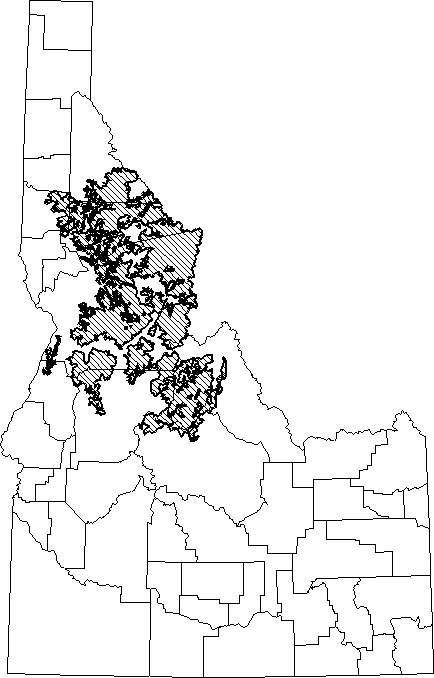
Martes pennanti
(Fisher)
Order: Carnivora
Order Description: Carnivores
Family: Mustelidae
Family Description: Weasels, Skunks and Others
Description:
Fishers are rare in Idaho, but if you should observe one, it looks larger than a marten, almost the size of a small fox, and it has no throat patch. Its longer fur is very dark, black to dark brownish, and often with a grizzled appearance on the face, neck and shoulders. Their legs and feet appear black. They appear stouter than a marten or a weasel. Total length is 31 to 41 inches (790-1033 mm), tail length is 11 ¾ to 16 5/8 inches (300-422 mm), and they weigh 3 to 18 pounds (1.4-8.2 kg).
Range:
They occur throughout much of Canada, and south through the Rockies, and in the northern Great Lakes Region and New England. Fishers were extirpated from Idaho, and re-introduced to three, north-central Idaho sites in the early 1960's. They are rare in other parts of Idaho, but little is known about their distribution.
Habitat:
They are found in upland and lowland mixed, deciduous, or coniferous forests, but they prefer mixed or coniferous forests. In Idaho, they prefer mature or old-growth coniferous forests with a dense canopy. They seem to favor forested riparian habitats in spring, summer, and fall, and younger-aged forests in the winter.
Diet:
They mainly prey on other mammals such as small rodents, shrews, squirrels, hares, muskrat, beaver, porcupine, and raccoons. They also feed on deer carrion, but will also eat birds and fruits. They have a reputation of being predator specialists on porcupines.
Ecology:
Trapping and habitat loss due to logging extirpated them from their range by the early 1900's. However, reintroduction has established their populations in certain areas. They are active both day and night, but seem more nocturnal in summer and diurnal in winter. In a study in Maine, they were mostly active shortly before sunrise and after sunset; and activity was reduced in winter. When inactive, they occupy dens in tree hollows, under logs, or rocky crevices, or in warmer months they rest in branches of conifer trees. Their home range has been estimated at 10 to 800 km2 by snow tracking, and 2 to 75 km2 by telemetry. An Idaho study found their home range to vary from 6 to 120 km2. Generally, the ranges of adults of same sex do not overlap. In Maine, home ranges of females were stable between seasons and years, but males moved extensively in late winter and early spring and their ranges shifted between years. population density in New England and the Great Lakes area has been estimated at up to about 1 per 3 to 11 km2 in summer, and 1 per 8 to 20 km2 in winter. Densities are lower in the western U.S. due to lower habitat quality.
Reproduction:
They breeds from late February to April; the peak occurs in March. After fertilization of the egg, the embryo becomes dormant for 10 to 11 months (delayed implantation). Young are born from March to early April. Litter size averages about 3 young. Young are weaned mid-May to early June, and become independent probably by late August to early September when they can kill on their own at about 4 months of age. They sexually mature in 1-2 yr; not all adult females breed in a given year. Apparently, breeding is promiscuous.
Conservation:
| Status: | Protected nongame species |
| Global Rank: | G5 |
| State Rank: | S1 |
Important State References:
Jones, J.L. 1991. Habitat use of fisher in north-central Idaho. M.S. Thesis, Univ. Idaho, Moscow. 147pp.
Information written by Donald Streubel,© 2000
Map image provided by Stephen Burton,© 2000
Design by Ean Harker©1999, 2000.
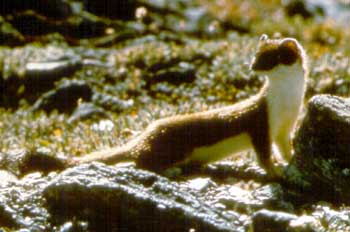
Mustela erminea
(Ermine or Short-tailed Weasel)
Order: Carnivora
Order Description: Carnivores
Family: Mustelidae
Family Description: Weasels, Skunks and Others
Description:
The ermine wears two "coats", a light brown summer coat with white underneath, and an all white winter coat. The tail is black tipped. The white winter coat is the source of the common name "ermine", which is a French word for "white winter color". The ermine has a typical weasel shape; a very long body, short legs and a pointed face with an almost triangular head. Its tail is about 30 to 40% of its head and body length. The short-tailed weasel is most likely the smallest mammalian carnivore in Idaho. There is pronounced sexual dimorphism in ermines. Males tend to be 40 to 80% larger than females. Total length is 8 to 13.6 inches (200-340 mm), tail length is 2.2 to 4 inches (55-101 mm), and they weigh 2.1 to 7 ounces (60-200 g).
Range:
They range from Alaska and Canada, south through most of the northern U.S. down the Rocky Mountain chain to central California, northern Arizona, northern New Mexico, and east to Iowa, the Great Lakes region, Pennsylvania, and northern Virginia.
Habitat:
This species has adapted to a variety of habitats from low-elevation marshes to alpine meadows, or any location where there is an abundance of prey (small rodents). But they prefer wooded areas with thick understory near watercourses.
Diet:
They feed primarily on small mammals, but will also eat other small vertebrates and insects. They are good climbers so they can raid bird and squirrel nests.
Ecology:
Ermine are relatively pure carnivores. One study showed the following proportions in their diet: 36% voles, 16% shrews, 11% deer mice, 9% rabbits, 4% rats 4% chipmunks and a small percentage of beetles, grasshoppers, and frogs. Their predatory skills are remarkable when you imagine that an ermine killing a snowshoe hare is comparable to a pet poodle killing a yearling cow! Tracks in the snow indicate that they can repeatedly leap three times their body length, even in deep snow. Could you leap 15 to 18 feet from a standing start time after time? The ermine, like all weasels, has a very high metabolic rate and a consequently large demand for food. This is due, in part, to their long, slim body shape, a shape that allows higher than usual body heat loss. Their daily activity seems to alternate between periods of rest and activity, although diurnal (activity during the day) activity seems more common during the summer. During the winter it often hunts under the snow and probably uses rodent burrows. Hunting in rodent burrows may be common. They have been observed hunting in ground squirrel burrows repeatedly entering a nest burrow and emerging each time with a young ground squirrel until the nest burrow is empty. When inactive, they occupy a den under logs, stumps, roots, brushpiles, or rocks. Ermines appear to maintain territories which have a wide range in size. Home ranges of from 8 to 500 acres (2.2 -200 ha) have been recorded with sub-territories existing within the larger home range. In a southern Ontario study male home range averaged 50 to 63 acres (20-25 ha) while female range was smaller; and most individuals remained on the study site less than 1 year. There are numerous anecdotes about ermines' "mousing" abilities. They can acclimate to humans and are often found near farms, or rural cabins where they can easily feed on deer mice attracted to the buildings. On occasion they can become very effective predators on chickens or other domestic small animals.
Reproduction:
Breeding occurs in early to mid summer. Implantation is delayed as the fertilized egg divides and begins to develop for about 2 weeks. It then remains inactive until the following spring when it implants in the uterus of the mother. Once implantation occurs, development is rapid and the young are born 4 weeks later. Female produces litter of 4-9 young (average 6-7), born mid-April or early May. Females reach sexual maturity in 3-4 mo; males are probably sexually mature in 12 months. Young are very small at birth, only about 0.07 ounce (2 g), but development is rapid. By the fifth week weaning is underway and the young are fed some meat. They continue to nurse for 7 to 12 weeks.
Conservation:
| Status: | Predatory wildlife |
| Global Rank: | G5 |
| State Rank: | S5 |
Information written by Donald Streubel,© 2000
Photos from Yellowstone- National Park Service, Aug 2000 & Jan 2001.
Map image provided by Stephen Burton,© 2000
Design by Ean Harker©1999, 2000.
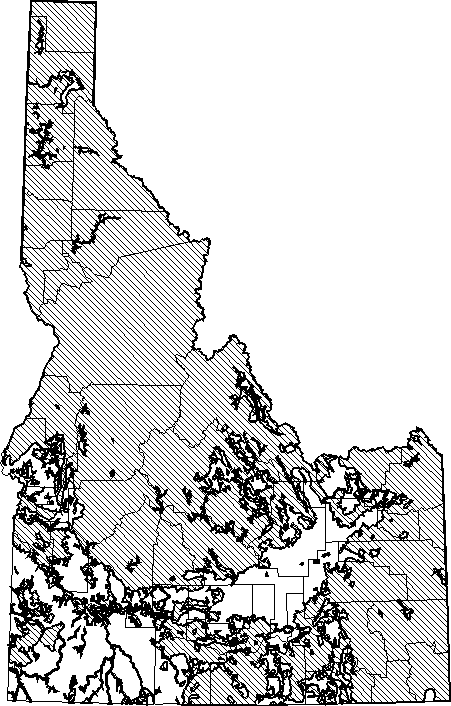
Mustela frenata
(Long-tailed Weasel)
Order: Carnivora
Order Description: Carnivores
Family: Mustelidae
Family Description: Weasels, Skunks and Others
Description:
The long-tailed weasel is larger than the ermine, but they are similar in appearance. Its tail is more than 44% of its total body length and the black tip on the tail is relatively longer than the ermine's. During summer the long-tail weasel is light to dark brown dorsally, and its belly is buff to rusty orange; its chin is white. In winter it turns white except for the black-tipped tail. Males are up to 40% larger than females.
Range:
This species is found throughout North America south of southern Canada except for the extreme Southwestern part of the U.S.
Habitat:
Long-tail weasels inhabit a variety of habitats from open woods to grasslands, and river bottoms to fencerows. In Idaho, occurs from upland brush and woods to subalpine rock slides and semi-open forest areas, but is most numerous in rocky, mountainous regions. Generally, it is found in more open habitat than the ermine.
Diet:
This weasel feeds primarily on small mammals (pocket gophers, mice, ground and tree squirrels and chipmunks), and occasionally on birds and their eggs, other small vertebrates such as snakes and frogs, and insects. Being larger than females, males prey on larger prey, up to snowshoe hare in size. When prey is abundant they will make multiple kills and cache their prey.
Ecology:
Activity of the long-tailed weasel is primarily nocturnal, but they are frequently seen during daytime. When inactive, they occupy rock crevice, brushpiles, hollow stumps, space among tree roots, or abandoned burrows made by other mammals; one individual may use multiple dens. Their home range is larger than the ermine, 80 to 120 ha (200 to 300 acres), but their movement through their habitat is variable, depending on the availability of prey. Individuals are basically solitary. population density depends on habitat and environmental conditions, and averages 1 weasel per 3 -16 ha.
Reproduction:
Like the ermine, the long-tailed weasel has delayed implantation. Breeding is in July and August when both juvenile and adult females come into estrus. After a short period of development, the fertilized egg is quiescent until implantation in the uterus in early spring. The tiny young are born in April and May. They develop juvenile teeth in 3 to 4 weeks, when they can probably feed on some meat supplied by the mother. By 6 weeks they are weaned, and they disperse from the mother in 10 to 12 weeks.
Conservation:
| Status: | Predatory wildlife |
| Global Rank: | G5 |
| State Rank: | S5 |
Information written by Donald Streubel,© 2000
Map image provided by Stephen Burton,© 2000
Design by Ean Harker©1999, 2000.

Mustela vison
(Mink)
Order: Carnivora
Order Description: Carnivores
Family: Mustelidae
Family Description: Weasels, Skunks and Others
Description:
The mink is larger than the weasel and is usually dark brown with a white throat patch. It has a large, bushy tail that is often slightly darker than the body. Its dark fur has a beautiful sheen; its fur has brought recognition to the mink for many years. Many people have “stylishly” worn their mink coat. Mink are well adapted to their semi-aquatic riparian habitat. Their fur sheds water easily and they have partially webbed feet. They are very good swimmers. Total length is 19 to 28 inces (470-690 mm), tail length is 6.2 to 8.8 inches (154-220 mm), and they weigh 2 to 3.5 pounds (0.9-1.6 kg).
Range:
The mink is found throughout Alaska and Canada and most of United States except in the desert Southwest.
Habitat:
They prefer forested, permanent, or semi-permanent wetlands with abundant cover, marshes, and riparian zones. They are rarely found away from water. In Idaho, they prefer aquatic habitats at lower and middle elevations.
Diet:
Mink uphold the reputation of the weasel family as predators. They prey on fish, crayfish, and frogs, which they capture while swimming. In some areas they rely heavily on muskrats for food. During the summer, up to 50% of their diet is crayfish and muskrats, but they will also take waterfowl and even meadow voles. In winter they rely less on aquatic food by continue to eat muskrats and occasionally a rabbit. When food is abundant they will cache it. A researcher in Illinois discovered a mink food cache of 13 muskrats, 2 mallard ducks, and 1 coot. Mink are also good fishermen; they have been observed “herding” small schools of fish into shallow water where they could capture the fish and eat them.
Ecology:
Mink are mainly nocturnal and crepuscular. They may reduce activity in severe winter weather. When inactive, they occupy dens in muskrat burrows, abandoned beaver dens, hollow logs, holes under tree roots, or a self-constructed burrow in a stream bank. Individuals are solitary, except during mating period and when females have young. Their home ranges are almost linearly associated with watercourses, usually about 20 to 50 acres (8-20 ha.) Male home ranges are considerably larger than that of a female. In good habitat, density may be 9 to 22 per 2.6 km2; higher concentrations indicate abundant prey.
Reproduction:
Mink breed from late February until early April. They give birth from early May into July. This Gestation of 40 to 80 days (average 51) is shorter than most weasels but delayed implantation does occur in Mink. The embryo develops in about a month. Once the average litter of 4 to 5 young are born they develop rapidly. Young mink acquire deciduous teeth early and eat some meat by 25 to 30 days. They are weaned at 5 to 6 weeks, and they are hunting with the mother at about 8 weeks. Males may sometimes help care for young.
Conservation:
| Status: | Game species |
| Global Rank: | G5 |
| State Rank: | S5 |
Important State References:
Whitman, J.S. 1981. Ecology of the mink (Mustela vison) in west-central Idaho. M.S. Thesis, Univ. Idaho, Moscow. 101pp.
Information written by Donald Streubel,© 2000
Map image provided by Stephen Burton,© 2000
Design by Ean Harker©1999, 2000.
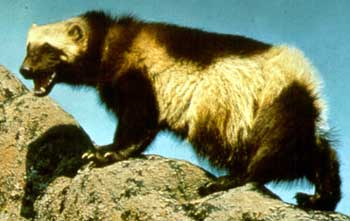
Gulo gulo
(Wolverine)
Order: Carnivora
Order Description: Carnivores
Family: Mustelidae
Family Description: Weasels, Skunks and Others
Description:
The wolverine is the largest member of the weasel family. It measures up to a meter long, it has a shaggy appearance due to long (4 inch) guard hairs extending beyond its underfur. It is black to dark brown with white to yellowish brown on its chest that may extend as bands onto its sides and back to its tail. Its short tail also is shaggy appearing due to very long guard hairs on it. It somewhat resembles a bear cub in size, but it is longer and more squat. Total length is 28 to 42 inches (700-1050 mm), tail length is 7.2 to 10.4 inches (180-260 mm), and they weigh 30 to 60 pounds (14-27 kg).
Range:
The wolverine is found in remote wilderness from Labrador, east to Alaska, and south to mountainous regions of western United States.
Habitat:
It is found in alpine tundra and in boreal and mountain forests. In California, it has been recorded at elevations of 1500 to 14,500 feet (480-4300 m). In Idaho, a 1985 survey indicated that the species inhabits remote, mountainous areas unaffected by human disturbance.
Diet:
Like all members of the weasel family they are effective predators. Wolverines also can be classified as scavengers. They are famous historically as being very ferocious towards other animals and very effective at raiding trap lines in the far north. They are known to effectively prey on a variety of mammals including ground squirrels, beavers, porcupines, and even injured or sick elk and moose or those that might be hampered by deep snow. They also feed on a variety of roots, berries, small mammals, birds' eggs, fledglings, and fish. However, small and medium-size rodents and carrion, especially ungulate carcasses, comprise a large percentage of diet.
Ecology:
Many folk tales and legends surround wolverines: they have been credited with extraordinary cunning, strength, savagery, and gluttony. Many of these tales come from the fur trapping era when wolverines did, in fact, raid trappers' cabins and steal bait and quarry from their trap lines. Like grizzly bears and wolves, wolverines symbolize wilderness. Idaho contains much wilderness and it appears to contain a population of wolverines. However, as humans have become more established in Alaska, Canada and remote areas of the Rocky Mountains, wolverine populations have declined. They are active throughout year, both day and night, but they are primarily nocturnal. When inactive, they occupy a den in a cave, rock crevice, under a fallen tree, or in a thicket. They are adept at climbing trees and swimming. They are solitary but range over vast areas. The mean annual home range of males has been reported at 535 km2 in Alaska, and 422 km2 in Montana; female's range has been reported at 105 km2 in Alaska, and 100 km2 in Montana. A male's home range typically overlaps the home range of more than one female. Another study with radiotelemetry determined annual home ranges for females and males to be 384 km2 and 1582 km2, respectively. Adult home ranges were segregated by sex. Male wolverines dispersed at sexual maturity at distances up to 185 km.
Reproduction:
Breeding occurs from April through October, but is usually in summer. Wolverines are so sparsely distributed a problem for them may be finding a mate. This may account for the six plus month breeding period. After fertilization occurs, implantation is delayed until January. Two to 5 young are born in late March to mid-April. In Idaho, females use high-elevation basins for natal sites.
Conservation:
| Status: | Protected nongame species |
| Global Rank: | G4 |
| State Rank: | S2 |
Important State References:
Copeland, J.P. 1996. Biology of the wolverine in central Idaho. M.S Thesis, Univ. Idaho, Moscow. 138pp.
Information written by Donald Streubel, 2000
Photo from Yellowstone- National Park Service, Aug 2000.
Map image provided by Stephen Burton, 2000
Design by Ean Harker 1999, 2000, 2001.
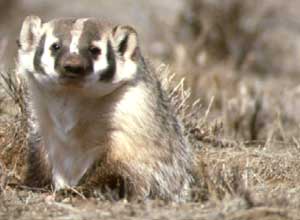
Taxidea taxus
(American Badger)
Order: Carnivora
Order Description: Carnivores
Family: Mustelidae
Family Description: Weasels, Skunks and Others
Description:
The badger's fur is grayish and grizzled with black. It has a "badge-like" black marking on its face, which is accentuated by white that extends from the face rearward. The badger body is well suited for digging; it is short and stout and somewhat flattened. Its ears are rather short and its snout appears slightly upturned. Its legs are short and stout, black colored and well suited for digging. The foreclaws are long and curved and its hind claws are shovel-like. Badgers always adopt a low profile, seeming to hug the ground. Total length is 24 to 30 inches (600-750 mm), their tail is about 4 to 6 inches (105-150 mm) and they weigh up to 26 pounds (12 kg).
Range:
Badgers range from the Great Lakes states west to Pacific Coast, and from Canadian Prairie Provinces, south to Mexican Plateau.
Habitat:
Prefers open areas with enough soil to dig in, but can be found from high alpine country to low valleys. They may also frequent brushlands with little groundcover. They seem especially common in large grass and sagebrush meadows and valleys. In Idaho, this species occurs in shrub steppe, in agricultural areas, and in open woodland forests.
Diet:
They feed primarily on small rodents such as ground squirrels, pocket gophers, kangaroo rats, prairie dogs, and mice, most of which they capture by digging into the burrows of these small mammals. But, they will also eat scorpions, insects, snakes (even rattlesnakes), lizards, and birds, especially when rodent population is low. An Idaho study reported that individuals preyed on Townsend's ground squirrels, lagomorphs, deer mice, kangaroo rats, and various arthropods.
Ecology:
They are usually active day and night, but primarily nocturnal activity has been reported. They remain underground in burrows when inactive. They use permanent dens in the winter, but during the summer they often dig a new den each day. In one Idaho study, individuals rarely stayed underground for more than 24 hours except in the winter. One female emerged from her winter den only once during a 72 day period. A southwestern Idaho study reported winter underground stays from several days to several weeks. Their population density averages 1 badger per 2.6 km2 in prime open country, although a southeastern Idaho study reported 5 badgers per km2 that were associated with ground squirrel populations in areas of sparse vegetation. One Idaho study reported a home range of less than 4 km2, while another in-state study found that adult home range averaged 2.4 km2 Most young-of-year badgers dispersed during their first summer (up to 110 km). Home ranges of badgers tend to overlap, but individuals are basically solitary. Since badgers dig burrows frequently, both in search of prey and for shelter, their burrows are common in badger habitat. Elliptical in shape, about 8 to 12 inches high and 12 to 18 inches wide, their burrows are important ecologically for other species. Various small mammals, such as ground squirrels and rabbits use their burrows for shelter, as do snakes and other vertebrates. Badgers have been maligned by humans because their burrows can be injurious to livestock, but rodent control and the cover their burrows provide for other wildlife probably offset the few leg injuries to livestock. Badgers are considered to be solitary, but recently there have been reports and sightings of badgers and coyotes hunting together. Coyotes take advantage of rodents escaping from burrows being excavated by badgers, and badgers take advantage of rodents escaping from coyote foraging by scurrying into burrows. This seems like an example of predator mutualism. Badgers have earned a reputation for their ferocity. When cornered they use what seems to be their main lines of defense: either burrowing out of sight or hissing loudly and feigning charges.
Reproduction:
Mating occurs mid- to late summer and even into early fall. implantation is delayed until December to February. Females produce 1 litter averaging 3 (2 to 5) young, born from March to early April (Idaho study found 1.4 young). The young are altricial , being blind and only partially furred. Females nurse their young through June and young leave their family groups in early fall. The male will occasionally stay close to the female when young are in the nest burrow. An Idaho study reported 30% of young-of-year females bred, and males reached sexual maturity as yearlings.
Conservation:
| Status: | Unprotected nongame species |
| Global Rank: | G5 |
| State Rank: | S5 |
Important State References:
Messick, J.P. and M.G. Hornocker. 1981. Ecology of the badger in southwestern Idaho. Wildl. Monog. 76:1-53.
Information written by Donald Streubel,© 2000
Map image provided by Stephen Burton,© 2000
Design by Ean Harker©1999, 2000.
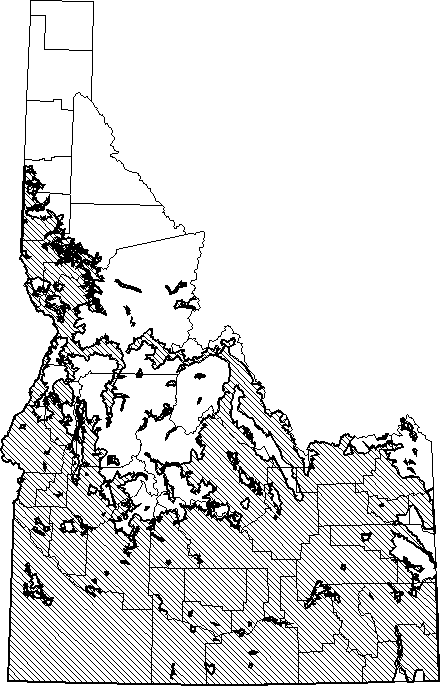
Spilogale gracilis
(Western Spotted Skunk)
Order: Carnivora
Order Description: Carnivores
Family: Mustelidae
Family Description: Weasels, Skunks and Others
Description:
The spotted skunk’s beautiful black hair is punctuated by 4 to 6 conspicuous white to pale yellow stripes that begin at the back of the head and continue rearward, usually breaking up into variously shaped large spots. A spot is usually present in front of each ear. The black tail has a white tip; it is not conspicuously large but it is conspicuously raised when the skunk is excited. Males are about 10% larger than females. Total length is 17-22 inches (426-540 mm), tail length is 5.6 to 9.2 inches (140-230 mm), weight is 1 to 1.4 pounds (425-650 g).
Range:
This species ranges from southern British Columbia and Montana, south throughout most of western North America to Mexico and Central America; barely enters Great Plains to the east.
Habitat:
Spotted skunks are typically found in semi-arid brushlands and thickets in canyons, and on rocky outcrops (rimrock), on hillsides and walls of canyons. In Idaho, it is also found in agricultural areas and riparian woodlands.
Diet:
Skunks are more omnivorous than other members of the weasel family. The spotted skunk eats insects, rodents, small birds and birds' eggs, which constitutes most of their diet, but they will also eat reptiles, amphibians, fruits, and berries.
Ecology:
The spotted skunk is a good climber, a trait that the striped skunk doesn’t have. This probably explains their ability to capture birds and bird eggs. They are not hibernators, rather they are active throughout year. However, they may be inactive for fairly long periods of time in winter in Idaho. They seem to be more nocturnal than the striped skunk; rarely being seen out and about during daylight hours. When they are inactive, they occupy dens in rocks, burrows, hollow logs, brush piles, or under buildings. Adults are essentially solitary. Densities of up to 12 per square mile have been recorded in suitable habitat. Females utilize home ranges of slightly leas than 0.25 square mi. (0.10 ha) while males occupy home ranges of 2 to 4 square mi. (0.8 to 1/6 ha). In Idaho, individuals are destroyed for predator control. When their populations are dense, the species is a known rabies vector. The spotted skunk can spray its strong musk scent up to 10 feet. It does this by facing its foe, arching up its back and tail, and whoosh! Not many predators are willing to tackle the strong defensive odor of skunk spray.
Reproduction:
Breeding occurs from late September through October. Implantation is delayed for about 200 days. After a short period of development once implantation does occur, a litter of from 4-6 young is born in May. Young leave nest about 1 month after birth, they follow mother around until almost fully grown, and reach sexual maturity in 4-5 months.
Conservation:
| Status: | Predatory wildlife |
| Global Rank: | G5 |
| State Rank: | S5 |
Information written by Donald Streubel,© 2000
Map image provided by Stephen Burton,© 2000
Design by Ean Harker©1999, 2000.
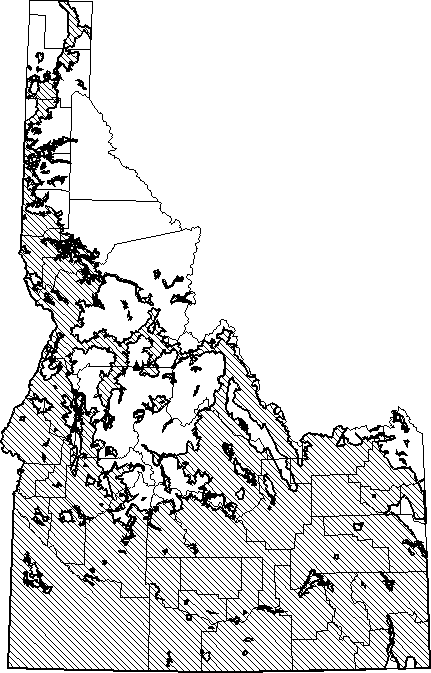
Mephitis mephitis
(Striped Skunk)
Order: Carnivora
Order Description: Carnivores
Family: Mustelidae
Family Description: Weasels, Skunks and Others
Description:
The fur of the striped skunk is coal black with a white stripe from its forehead down to its nose. A broad white stripe beginning at the base of its head forms a "V" down the sides of its back and terminates near the tail. Its bushy tail is variously white. Males are considerably larger than females. A striped skunk is about the size of a domestic cat. Total length is 21 to 30 inches (520-770 mm), tail length is 6.8 to 14 inches (170-350 mm), weight is 4 to 9 pounds (1.8-4 kg).
Range:
The striped skunk is more common throughout its range than the spotted skunk. It ranges from central Canada down through the United State to northern Mexico.
Habitat:
Striped skunks are found in a variety of habitat wherever there is adequate food and shelter. But, it prefers semi-open country with interspersed woodlands and meadows, brushy areas, and bottomland woods. It is frequently found in suburban areas. In Idaho, it prefers marshes, farmlands, and riparian areas in dry country. It usually is not found in dense forests nor in extremely dry areas.
Diet:
Their omnivorous diet includes a variety of plant and animal foods such as insects, small mammals, eggs, carrion, fruits, etc. Half of summer diet is insects including grasshoppers, beetles and moth larvae. They sometimes eat domestic poultry and fruit in orchards. They are known to prey on bees and have been observed actually scratching on beehives and capturing bees as they leave the hive.
Ecology:
Striped skunks are mostly crepuscular or nocturnal, but are sometimes active during daytime. They may be dormant during extended periods of cold, snowy weather; but they do not hibernate. Several individuals, mainly females, may share a winter den. Males seem to be more active in winter. When inactive, they occupy dens under rocks, logs, or buildings; they may excavate burrows or use burrows abandoned by other mammals. Their dens are usually somewhat close to water, but always on a dry site. Home range is variable, from 0.5 to 1.5 square miles (1.3-6.5 square km); males tend to wander more than females. Population density may fluctuate greatly, occasionally reaching high densities. The species is preyed on by humans, canids, felids, mustelids and raptors. This species, like the spotted skunk, is a rabies vector. When rabid, a skunk is often out and about during the day, and unusually aggressive. If a skunk such as this is encountered, it should be avoided for obvious reasons.
Reproduction:
Breeding occurs in mid-February through late March, with the peak occurring in mid-February. One researcher reported a pregnancy rate of 78-96%. Delayed implantation occurs as in all "weasels", total Gestation lasts 62-68 days. litter size varies from 2 to 10 young (average 6-8), and they are born in late April to early June. Females produce 1 litter per year. Young are weaned and begin to follow their mother at 6 to 7 weeks; some young are independent by fall. Individuals reach sexual maturity in their first spring.
Conservation:
| Status: | Predatory wildlife |
| Global Rank: | G5 |
| State Rank: | S5 |
Information written by Donald Streubel,© 2000
Map image provided by Stephen Burton,© 2000
Design by Ean Harker©1999, 2000.

Lutra canadensis
(Northern River Otter)
Order: Carnivora
Order Description: Carnivores
Family: Mustelidae
Family Description: Weasels, Skunks and Others
Description:
The river otter is large for a mustelid and beautifully adapted for its aquatic habits. Its body is sleek and cylindrical, the head is small, and the tail, nearly one-third the total length, tapers into a long, rudder-type round tail. Its feet are webbed, the claws are short. The fur, among the finest of the furbearers, is very dense and dark brown, but its almost black when wet. Their fur is lighter on the sides of the head and it can be silver-gray on the underside of the head and throat. Their fur provides good insulation in the frigid waters it inhabits, and it efficiently sheds water. Their appearance is almost like a seal. A well-meaning geologist once reported seeing seals in Yellowstone Lake in Yellowstone National Park - otters are not closely related to seals, but they do have some similarities. Total length is 40 to 54 inches (1000-1346 mm), tail length is 14 to 20 inches (353-510 mm), and they weigh 10 to 30 pounds (4.5-13.6 kg).
Range:
Otters were once found throughout most of North America, but the fine, high quality of their fur made them a favorite quarry of trappers, and habitat loss from damming rivers, siltation, riparian development of all kinds led to the decimation of this species over much of the United States. Conservation and protection has accommodated it return to part of its former range. It is generally found throughout North America north of Mexico but absent from extremely arid regions of the west and southwest.
Habitat:
River otters are rarely found far from water. They are found along the banks of and in streams and rivers and in lakes, swamps, marshes, and beaver ponds. An Idaho study found that otters preferred valleys to mountain habitats, and stream-associated habitats to lakes, reservoirs, and ponds, and food had the greatest influence on habitat use.
Diet:
They eat mainly aquatic animals, particularly fishes (mostly slow-moving, mid-size species such as suckers), frogs, crayfish, and turtles. They also prey on nesting aquatic birds in some areas as well as insects, earthworms, small mammals an even juvenile muskrats and beavers. An Idaho study reported diet items included fishes, invertebrates, birds, mammals, and reptiles.
Ecology:
River otters seem always on the move and they are especially known for their playfulness. They slide in mud and snow slides along river banks and seem to have great fun. They also have been observed playing with sticks in the water and even dropping pebbles to retrieve them from the bottom of the river. In the water they are agile and lithe, and can swim underwater for up to 6 miles per hour for 2 to 3 minutes. They can forage under the ice in the winter apparently acquiring air from air pockets under the ice. On land they move with a rapid undulating (inchworm) movement at a fairly rapid pace. However, give them some crusty snow or ice and they move along rapidly by alternating a series of hops with belly sliding. With this method they can achieve speeds of up to 15 miles per hour. They remain active all winter, even in fresh, deep snow. In general, they are primarily nocturnal, but may be active by day. Idaho study reported diurnal activity in winter and nocturnal activity in other seasons, with most activity in winter, and progressively less activity in other seasons. They den in hollow logs, spaces under roots, logs, or overhangs, abandoned beaver and muskrat lodges, dense thickets near water, or burrows of other animals. Their home range is typically linear; ranging from 32 to 48 km. (19-30 miles) for a pair or a male, and less for females with young. population density of 1 per 3.5 km (2 mi) of river length has been recorded. An Idaho study reported that home ranges overlapped extensively and ranged in length from 8 to 78 km ( 5 to 47 mi). Home range shape was determined by drainage patterns.
Reproduction:
In Idaho, breeding begins in late April following the birth of a litter from the previous spring. implantation is delayed 10-ll mo, thus total Gestation lasts 9-12 months; but implantation doesn't occur until late winter. Females produce 1 litter of 1 to 5 young (average 2.4 in Idaho). The young open their eyes at about one month old, they leave the den when about six weeks old when they begin to learn to swim. Young stay with mother for about 1 year, and reach sexual maturity in 2 years.
Conservation:
| Status: | Protected nongame species |
| Global Rank: | G5 |
| State Rank: | S4 |
Important State References:
Melquist, W.E. and M.G. Hornocker. 1983. Ecology of river otters in west central Idaho. Wildl. Monog. 83:1-60.
Information written by Donald Streubel,© 2000
Photo from Yellowstone- National Park Service, Aug 2000.
Map image provided by Stephen Burton,© 2000
Design by Ean Harker©1999, 2000.
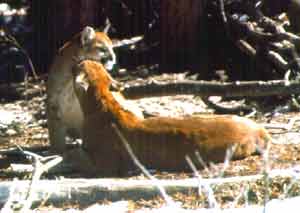
Felis concolor
(Mountain Lion)
Order: Carnivora
Order Description: Carnivores
Family: Felidae
Family Description: Cats
Description:
The mountain lion, or cougar, is the largest cat in Idaho and in the northern U. S. It has a yellowish color, often with some rusty, reddish color on its back. Its tail, which appears to be very long is cylindrical with yellowish on top and lighter color underneath. The tail has a dark tip. There is dark color between the ears and around the muzzle. Adult females may weigh 80 to 130 pounds (37-60 kg) while adult males may weigh 90 to 170 pounds (45-78 kg). Their total body length ranges from 60 to 108 inches (150-270 cm), tail length is 21 to 36 inches (51-85 cm).
Range:
The mountain lion had the widest historic distribution of any native American mammal other than humans, from British Columbia south through Mexico and central America to Argentina, and from the Pacific to the Atlantic coasts. Currently in the U. S. its populations are scattered in wild, mountainous, rugged terrain areas and seems restricted to areas with relatively sparse human populations. It is most widely distributed in the western one-third of the U. S.
Habitat:
They seem to prefer mountainous country with cliffs and rimrock, and semi-wooded canyon habitat with slopes of mixed open and forest. Mountain lions range over vast areas and thus can move through a diversity of habitat types.
Diet:
The cougar relies heavily on mule deer, which may comprise up to 75% of their diet throughout the year. They are somewhat opportunistic, eating large and small mammals such as bighorn sheep, coyote, mice, squirrels, and rabbits. They also prey on porcupines and can actually pass porcupine quills through their digestive system, apparently with no ill effects. They even will eat some insects and reptiles. They do occasionally prey on livestock, primarily sheep and cattle. One Idaho study reported that mule deer and elk were their primary food from September-May, and Columbian ground squirrels were primary food in summer. A study in southern Idaho showed that mule deer were their primary food throughout the year.
Ecology:
They are active day or night throughout year and in all kinds of weather. In the absence of human disturbance, peak activity occurs within 2 hours of sunset and sunrise; near human presence, activity peaks after sunset. They are primarily solitary with the exception of females with kittens. population density is usually not more than 3-4/100 km2 (about 1/20 km2 in Big Cypress and Everglades regions, Florida). In Idaho, mutual avoidance maintains density of breeding adults below level set by food supply. Their annual home range varies greatly in different areas. In Idaho, home ranges of males were from 54 to 230 km2 , while females had home ranges of 14 to 148 km2. However, home ranges of up to 1454 km2 have been reported. Home ranges of resident females overlapped, but those of resident males did not, but one male home range typically overlaps 2 or 3 female home ranges. Seasonal movements occurred within home range in response to prey movements; mountain lions moved farther in summer than in winter while hunting their prey, and some altitudinal movement was associated with ungulate movements and snows in winter. In many areas of the Rocky Mountain states, mountain lions are found in residential areas that have been built in prime mule deer winter range. This, of course, is because mountain lions are following their prey. Males are known to kill kittens, which has been documented in an Idaho study. A radiotelemetry study has been ongoing in isolated mountain ranges of south-central Idaho for over ten years.
Reproduction:
Gestation lasts about 82-96 days. Most births occur April-September. Litter size varies from 1-6. Young are weaned after 2-3 mo, remain with mother for 1-2 yr, and reproduce at 2-3 yr (Idaho study reported female breeding age may depend on social status). Usually 2 years elapse between litters (18-24 mo in Idaho), but if litter does not survive, female may have litters in consecutive years. Once bred, the female raises the young with no help from the male. The male leaves the female shortly after breeding.
Conservation:
| Status: | Game species |
| Global Rank: | G5 |
| State Rank: | S4 |
Important State References:
Hornocker, M.G. 1970. An analysis of mountain lion predation upon mule deer and elk in the Idaho Primitive Area. Wildl. Monog. 21:1-39.
Holmes, B. R. 2000. The mountain lion in southeastern Idaho: population characteristics and a test of optimal foraging theory. M.S. Thesis. Idaho State University. 96 pp.
Information written by Donald Streubel,© 2000
Photos by Donald Struebel and from © Corel Corporation, 1993 - Corel Professional Photo Series # 94000, Yellowstone National Park, #94095.
Map image provided by Stephen Burton, 2000
Design by Ean Harker 1999, 2000.
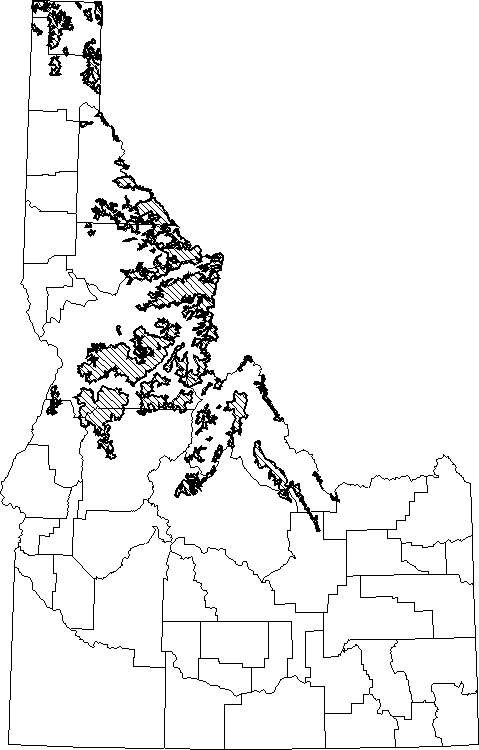
Felis lynx
(Lynx)
Order: Carnivora
Order Description: Carnivores
Family: Felidae
Family Description: Cats
Description:
The lynx is a large cat smaller than a mountain lion, but about the same weight as a bobcat. It is characterized by long, black ear tufts, a short black tipped tail, cheek ruffs that look like a double, pointed beard. Its fur is thick, with a tawny color mixed with black hairs. Underneath it is brownish. It has large feet that are thickly furred, which allow it to walk on top of snow, much like snowshoes. Its chin is white. It can be distinguished from a bobcat by less noticeable spotting, and larger ear tufts. Total body length is about 29 to 47 inches (730-1200 mm), its tail length is 2 to 5 3/8 inches (50-140 mm), and they weigh between 12 to 40 pounds (5.2-18 kg).
Range:
The lynx ranges throughout Alaska and Canada, south through the Rocky Mountains into Colorado, into the northern Great Lakes, and it is rare in northern New England. It is a classic species of the “north woods”.
Habitat:
The lynx is typically found in northern boreal forests with openings, in regenerating mixed forests, and in rugged outcrops, bogs, and thickets. Like many other large carnivores they are found in remote, wild forests having relatively little human disturbance. In Idaho, this species needs early successional forests for foraging, and mature forests for denning.
Diet:
It eats primarily small mammals and birds, particularly snowshoe hares. The Hudson Bay Fur company in Canada had years of data showing the relationship between lynx populations and snowshoe hare populations. Snowshoe hare populations cycle on a 9 to 10 year cycle. The lynx populations follows the peaks and lows by about two years, substantiating the strong predator-prey relationship of the two species. It occasionally feeds on squirrels, small mammals, beaver, and will occasionally take a young deer. It also has been known to feed on moose, muskrat, and birds, some of which may be taken as carrion.
Ecology:
Like most cats, lynx are mainly nocturnal, being most active from 2 hours after sunset to 1 hour after sunrise. When inactive, they typically occupy a den in a hollow tree, under a stump, or in thick brush. They are known to cache food. When prey is scarce, their home range increases and individuals may become nomadic. The range of males is larger than that of females. In western U.S., home range is usually between 24-48 km2. Population density is usually less than 10 (locally up to 20) per 100 km2, depending on prey availability, such as the snowshoe hare. In the northern boreal forest, lynx populations seem closely related to the 9 to 10 year population cycle of snowshoe hare, their primary prey species, but there is about a 2 year lag of the lynx population behind the snowshoe hare cycle. Individuals are usually solitary. This species is uncommon in Idaho and was recently listed as “threatened” by the U. S. Fish and Wildlife Service.
Reproduction:
They breed from March through May in their northern range, and Gestation lasts 62 to 74 days. A female produces 1 litter of 3 to 4 young every 1 to 2 years. Young stay with mother until next mating season or longer. Some females give birth as yearlings. Prey scarcity may suppress breeding.
Conservation:
| Status: | Game species |
| Global Rank: | G5 |
| State Rank: | S1 |
Information written by Donald Streubel,© 2000
Map image provided by Stephen Burton,© 2000
Design by Ean Harker©1999, 2000.
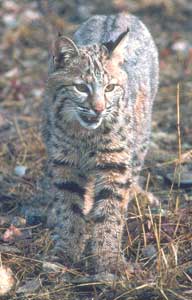
Felis rufus
(Bobcat)
Order: Carnivora
Order Description: Carnivores
Family: Felidae
Family Description: Cats
Description:
The bobcat is a tawny color often with a reddish tone, with black spotting that is not real distinct.In winter their color is more grayish.They have a “bobbed” tail that is short and has 2 or 3 black bars with a black tip above, but it is whitish underneath.The lynx tail is black on both sides.Their face often has thin, black lines, that lead into cheek ruffs.The cheek ruffs do not extend into the beardlike extensions of the lynx.Their ears are slightly tufted, but less so than the lynx.Their weight varies from 14to 68 pounds (6.4-31 kg), males are generally larger than females.Total body length is about 28 to nearly 50 inches (710-1250 mm), tail length is about 4 to 7 inches (100-170 mm).
Range:
They are generally found from southern Canada across the U. S. south to Mexico.Their populations are isolated and only found in suitable habitat through the Midwest and eastern part of the U. S.They are more abundant and widespread throughout the Rocky Mountain states and to the west coast.
Habitat:
Found in various habitats, including deciduous-coniferous woodlands and forest edges, swamps, brushlands, and areas with thick undergrowth. In Idaho, found from deserts to rocky mountains near timberline.
Diet:
Prefers small mammals, especially lagomorphs, but will occasionally eat birds, other invertebrates, and carrion. West-central Idaho study reported voles were primary winter prey. Southeastern Idaho studies found bobcats preyed primarily on jackrabbits, but switched to small mammals when rabbit numbers declined. They have been known to prey on larger mammals such as small pronghorns or deer, but only occasionally.
Ecology:
Mainly nocturnal/crepuscular, but sometimes diurnal in winter. When inactive, occupies rocky cleft, cave, hollow log, space under fallen tree, etc.; usually changes shelter daily. Home range is generally less than 100 km2 (often much less); male's range is greater than female's. West-central Idaho study found summer home range was approximately 4 times larger than winter home range. population density is 1/3.9 km2 in southern range, to 1/12.9 km2 in north (Idaho study reported density of 1/23.3-29.0 km2). Individuals are solitary except when breeding. Southeastern Idaho study found bobcat numbers declined as rabbit numbers declined due to fewer females raising litters. Home ranges also increased.
Reproduction:
Breeds mid-winter through spring (possibly any time of year in some areas). Female produces 1 litter of 1-7 young (average 2.8 in southeastern Idaho), except in southern range, where second litter may be born in early August. Gestation lasts 50-60 days. Both parents feed young while kits are in den. Young are weaned at about 2 mo, stay with mother until early fall, and first breed usually at 1-2 yr.
Conservation:
| Status: | Game species |
| Global Rank: | G5 |
| State Rank: | S4 |
Important State References:
Knick, S.T. 1990. Ecology of bobcats relative to exploitation and a prey decline in southeastern Idaho. Wildl. Monog. 108:1-42.
Information written by Donald Streubel,© 2000
Photos from © Corel Corporation, 1993 - Corel Professional Photo Series # 94000, Yellowstone National Park, #94087.
Map image provided by Stephen Burton, 2000
Design by Ean Harker 1999, 2000, 2001.
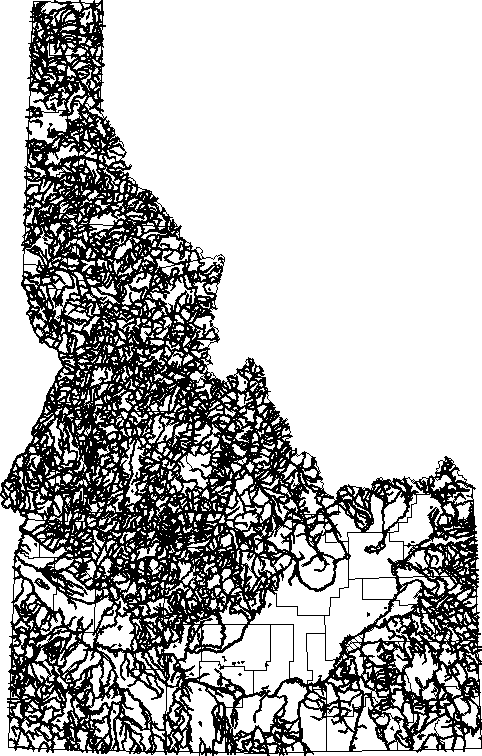
Castor canadensis
(American Beaver)
Order: Rodentia
Order Description:Rodents
Family: Castoridae
Family Description: Beavers
Description:
The beaver is our largest rodent. It is typically dark, reddish brown but varies from a yellowish brown to almost black. They have a very distinctive flattened, scaly tail, which is a fat storage area. Their hind feet are webbed and clawed, and their front feet are smaller and not webbed. Their aquatic habits are accommodated by valves that can close off the ears and nose when underwater, and a clear membrane that closes over the eyes. Their lips seal behind their incisors, which allows them to gnaw wood underwater. Their dense underfur is grayish-brown, and they have long, reddish brown guard hairs. Total length is 40 to 52 inches (1000-1350 mm), tail length is 10.4 to 13 inches (280-325 mm), and they weigh 22 to 75 pounds (10-35 kg).
Range:
Following local extinction because of beaver trapping during the 1800's, conservation has allowed their populations to increase. Presently they are widely distributed through North America north of Mexico, excluding Florida, southern California, and southern Nevada. They are common throughout much of Idaho where ever there are streams, ponds, lakes and even along rivers.
Habitat:
Beavers are dependent on slow-flowing brooks, streams, and rivers for dam construction, but they do also live in small lakes and fairly large rivers in Idaho. They prefer adjacent stands of successional growth trees such as aspen, willow and cottonwood rather than mature forests. Beavers are highly capable of altering their own environment by damming streams and other flowing water to create ponds
Diet:
They prefer bark of deciduous trees such as aspen, willow, birch and even maple as well as various woody shrubs. Willow and aspen seem to be their favorites. They also eat roots of tuberous aquatic plants, especially pond lilies which they utilize more during summer months. They do not eat fish or other aquatic animals, which is contrary to what many people think.
Ecology:
Beavers dam flowing water to create deeper, water held in ponds. Their dams consist of a mixture of tree trunks, branches and mud and can be as high as 6 to 8 feet and in extreme cases up to ž mile long. Most dams are much smaller. Once their dams are constructed, the water deepens and provide safety for them as well as a place to construct their lodges and store food for the winter. They build two types of lodges, those that are constructed in open water of ponds and bank lodges typically along the banks of larger lakes and rivers. Their lodges consist of hollow mounds of sticks and mud with two or more underwater entrances. Inside they build a resting platform above the water level where they rest, feed and have their young. Bank lodges have tunnels beginning underwater and extending up into higher banks along ponds and rivers. The entrance areas are usually covered by large mounds of sticks and mud on the bank. The sticks and mud provide good insulation for their lodges during the winter. Beavers move onto land to cut woody vegetation both for building materials and for food. Beavers can energetically afford to go only so far for their sources of food on land. Beyond a certain point they are too vulnerable to predation as they are too far from the safety of their pond, or they are expending too much energy getting the wood they may cut down to their pond. In effect, they can eat themselves out of "house and home". Thus, the length of time a colony site is occupied depends in part on rate of replenishment of food resources. Over the years, siltation can also cause their ponds to get too shallow for their use, in which case they are forced to move on to other suitable habitat. Beavers are usually active from dusk to dawn cutting saplings and trees or shrubs to acquire food. Prior to the winter they store branches and twigs in underwater piles in their ponds. This food supply sustains them during the winter when their activity is reduced. They commonly move overland when searching for a mate or locating unoccupied water source. A colony typically consists of 4 to 8 related individuals (pair of adults plus offspring from current and previous year). Colony densities may reach 3 per 300 acres (121 ha); 0.6 to 0.9 per km2 has been reported in northern Minnesota. On rivers, population densities may range from 2 to 15 beavers per 2.6 km2. In an Idaho study, males and juveniles showed the greatest migration tendency; a common migration pattern was from upstream to downstream. Beavers can cause extensive flooding and considerable damage by cutting trees. However, they also provide great habitat for waterfowl, numerous song birds, and many small mammals who favor moist, riparian habitat. Here in Idaho, beavers have also been found to be helpful in maintaining good riparian habitat for grazing livestock. A colony of beavers is a social unit that helps all colony members survive. They have a well-known danger signal: a loud, resounding slap of their tail and all beavers in the colony instinctively dive. More than one colony can coexist in large ponds, and members do move from one family to another. Predators include wolves, bobcats, coyotes, and others while on land. Their genus name, Castor, is named after their paired anal scent glands with which they deposit "castor " or scent on scent stations around their ponds.
Reproduction:
Beavers breed from mid-January to early June depending on whether they're in the south or northern part of their range. gestation lasts 106 days which is much longer than for most rodents. parturition , or birth, occurs from April to-June in Idaho. litter size varies from 1 to 9 young, but the average is 3 to 5 (larger in north than in south). Young are weaned in about 6 weeks. A female produces 1 litter per year. A pair can mate for life, and the male cares for young by maintaining the dams, gathering food and helping watch for predators. Young mature and disperse in 1.5 to 2 years.
Conservation:
|
Status: |
Game species |
|
Global Rank: |
G5 |
|
State Rank: |
S5 |
Important State References:
Leege, T.A. 1968. Natural movements of beavers in southeastern Idaho. J. Wildl. Manage. 32:973-976.
Information written by Donald Streubel,© 2000
Map image provided by Stephen Burton,Đ 2000
Design by Ean Harker©1999, 2000.
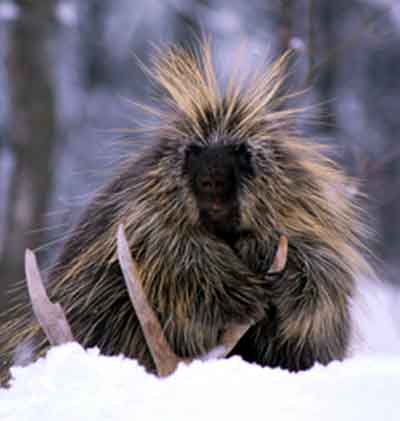
Erethizon dorsatum
(Common Porcupine)
Order: Rodentia
Order Description:Rodents
Family: Erethizontidae
Family Description: Porcupines
Description:
Roughly about the size of a small to mid-sized dog. Brown fur laced with long quills used in defense.
Range:
Throughout Canada, northern Mexico, and U.S. (absent from southeastern U.S.) In Idaho.
Habitat:
Prefers coniferous and mixed forests. In some parts of range, also found in riparian zones, grasslands, and shrub steppe.
Diet:
Feeds on inner bark of trees and on evergreen needles in winter, buds in spring, roots, leaves, berries, fruits and seeds in summer, and mast and fruits in fall.
Ecology:
Mainly nocturnal , but frequently seen during day. Active year-round in southeastern Idaho. Winter den sites include rock outcrops, live hollow trees, hollow logs, and outbuildings; may also shelter in dense conifers. Summer range may average up to 50-100 ha; winter range may be less in presence of extensive snow cover. In southeastern Idaho study, winter home range was reported at 0.07 ha, and summer home range was 23.1 ha for females. Densities may vary from 9-22/km2 in good habitat. Species is preyed upon by felids, canids, mustelids, and raptors.
Reproduction:
Breeds September-December. Gestation lasts 17-18 wk (usually 210 days). Female rears 1 young each year; young reaches sexual maturity in 15-16 mo.
Conservation:
| Status: | Game species |
|
Global Rank: |
G5 |
|
State Rank: |
S5 |
Important State References:
Craig, E.H. and B.L. Keller. 1986. Movements and home range of porcupines, Erethizon dorsatum, in Idaho shrub desert. Canad. Field-Natur. 100:167-173.
Information written by Donald Streubel,© 2000
Photos by Kris Wilcox and from Yellowstone- National Park Service, May 1998.
Map image provided by Stephen Burton, 2000
Design by Ean Harker 1999, 2000, 2001.
Thomomys townsendii
(Townsend's Pocket Gopher)
Order: Rodentia
Order Description:Rodents
Family: Geomyidae
Family Description: Pocket Gophers
Description:
The Townsend’s pocket gopher is larger than the other pocket gophers in Idaho: total length is 9 to 13 ¼ inches (225-354 mm), tail length is 2 to 4 ½ inches (50-112 mm). They are variable in color from a darkish brown to a lighter dark buff, but most are grayish brown. Underneath they are slightly lighter in color, and their upper feet, tail and chin are white. Dark patches behind the ears are also present.
Range:
This species is found in widely separated populations, one in southeastern Oregon and southwestern Idaho northern Nevada, and northeastern California and they have been found in southcentral Idaho as well. They may have once had a continuous range in Idaho, but perhaps modern land use practices has limited their distribution in some areas. Its also possible that a decrease in precipitation over a long period of time may have changed their distribution.
Habitat:
Townsend’s gopher is found in deep soils of river valleys, in old lake beds, and in irrigated farmland. In Idaho, they prefer moist river valleys and irrigated farmland. This species may be more limited to specific soil conditions than other gopher species, preferring moist and deep soils typical of around lakes and river bottomlands.
Diet:
They eat roots, tubers, and some surface vegetation. In Idaho, their diet includes roots of saltgrass, roots and stems of grasses, alfalfa, grains, and crops.
Ecology:
Like all pocket gophers they are primarily nocturnal and fossorial. They forage from underground burrows, and they may pull plants down through the soil (from the surface) into their burrow. They sometimes forage above ground. They collect food in cheek pouches and carry it to underground storage areas. They are active throughout the year; pocket gophers do not hibernate. They are primarily solitary, and individuals fight viciously when together. This species is the largest Idaho pocket gopher. Pocket gophers are ecologically important as prey items and in favorably influencing soils, the microtopography, habitat heterogeneity, enhancing the diversity of plant species, and increasing primary productivity.
Reproduction:
Females may produce 2 or more litters of 3 to 10 young per litter each year. Gestation lasts approximately 19 days.
Conservation:
| Status: | Unprotected nongame species |
|
Global Rank: |
G4 |
|
State Rank: |
S4 |
Information written by Donald Streubel,© 2000
Map image provided by Stephen Burton,© 2000
Design by Ean Harker©1999, 2000.
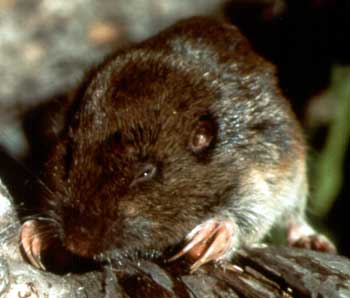
Thomomys talpoides
(Northern Pocket Gopher)
Order: Rodentia
Order Description:Rodents
Family: Geomyidae
Family Description: Pocket Gophers
Description:
The northern pocket gopher is nearly ground squirrel size (total length 6 ½ to just over 9 inches (165-235 mm), it weighs 2 ¾ to 4 5/8 ounces (78-130 g). Like all pocket gophers, they have a tube-shaped body, very small eyes and ears, short and smooth fur that is brownish to tan, and a short tail. Long front claws accommodate efficient digging and its large external, fur-lined pouches are for carrying food. There are dark patches behind their ears.
Range:
This pocket gopher is the most widely distributed species in Idaho. It ranges from Alberta and Saskatchewan, south to northern Arizona and New Mexico, and from Washington east to northwestern Minnesota, including most of Idaho.
Habitat:
They prefer deep soils along streams and in meadows and cultivated fields, but is also found in rocky soils and clay, in brushy areas or along roadsides, and in alpine tundra.
Diet:
Eats roots of forbs, cacti, and grasses.
Ecology:
They are active throughout the year and they do not hibernate but may be inactive in winter and midsummer for brief periods. Their daily activity peaks at dawn and dusk. Most burrowing activity occurs in spring and fall when soil is loose. Food is often carried in cheek pouches and stored in underground chambers, or in or under snow. They may feed in vegetable gardens, grainfields, and orchards, causing damage to crops. They are primarily solitary, home range may occupy over 400 to 530 ft2 (125-170 m2). Population density varies widely with the quality of habitat. Pocket gophers are ecologically important as prey items, they are fed on by coyotes, grizzly bears and great gray owls. They are also ecologically important in influencing soils with their burrowing activity and allowing greater moisture absorption by the soil. This influences plant distribution and helps create greater habitat heterogeneity, and greater diversity of plant species. This species may help reduce erosion as a result of their tunneling, but may also become nuisances and conflict with agriculture and forestry.
Reproduction:
Females only breed once a year (monoestrus). Mating usually occurs from March to mid-June, depending on weather and latitude. A female produces a litter of 4 to 7 young after a Gestation period of 19 to 20 days. Young disperse from the natal burrow at about 2 months.
Conservation:
| Status: | Unprotected nongame species |
|
Global Rank: |
G5 |
|
State Rank: |
S5 |
Important State References:
Kuck. L. 1969. The effects of the northern pocket gopher on reforestation: activity and movement. M.S. Thesis, Univ. Idaho, Moscow. 51pp.
Information written by Donald Streubel,© 2000
Photo from Yellowstone- National Park Service, Sept 1998.
Map image provided by Stephen Burton, 2000
Design by Ean Harker 1999, 2000, 2001.
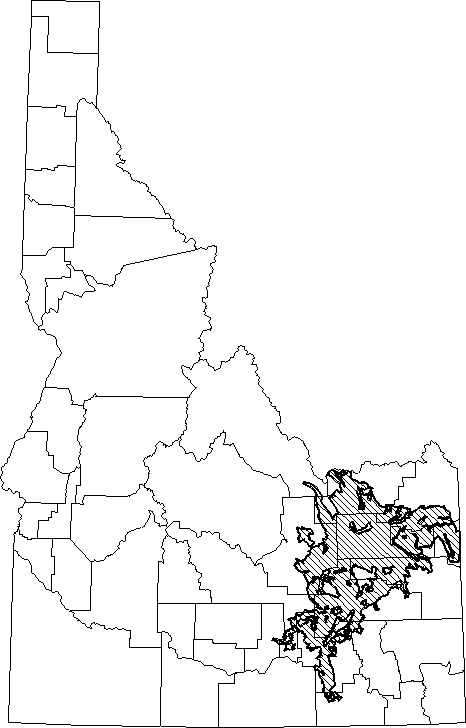
Thomomys idahoensis
(Idaho Pocket Gopher)
Order: Rodentia
Order Description:Rodents
Family: Geomyidae
Family Description: Pocket Gophers
Description:
This pocket gopher is smaller than the Townsend's and northern pocket gophers, and has only recently been described as a different species from the northern pocket gopher. They are yellowish brown with dark brown-tipped hair on the back, their feet are whitish and they have dark gray around their nose. Total length is: 7 3/8 to 9 inches (185-228 mm).
Range:
This species is found in two distinct locations, eastern Idaho and southwestern Montana, with populations found in the extreme southeastern corner of Idaho, western Wyoming, and northeastern Utah.
Habitat:
They are found in shrub steppe, grasslands, and subalpine mountain meadows, but favor shallow, rocky soils more so than the northern pocket gopher.
Diet:
They eat roots, tubers, and some surface vegetation.
Ecology:
They are active throughout the year foraging in underground burrows and above ground at night or on overcast days. Like all pocket gophers, they carry food in cheek pouches and store it in underground chambers. They are primarily solitary except during the breeding season. Predators include coyotes, foxes, and owls. Pocket gophers are ecologically important as prey items and in influencing soils; the microtopography, habitat heterogeneity, diversity of plant species, and primary productivity.
Reproduction:
Probably similar to northern pocket gopher , a female produces a litter of 4 to 7 young after a Gestation period of 19 to 20 days.
Conservation:
| Status: | Unprotected nongame species |
|
Global Rank: |
G5 |
|
State Rank: |
S3 |
Important State References:
Thaeler, C.S. 1972. Taxonomic status of pocket gophers Thomomys idahoensis and Thomomys pygmaeus (Rodentia: Geomyidae). J. Mammal. 53:417-428.
Information written by Donald Streubel,© 2000
Map image provided by Stephen Burton,© 2000
Design by Ean Harker©1999, 2000.
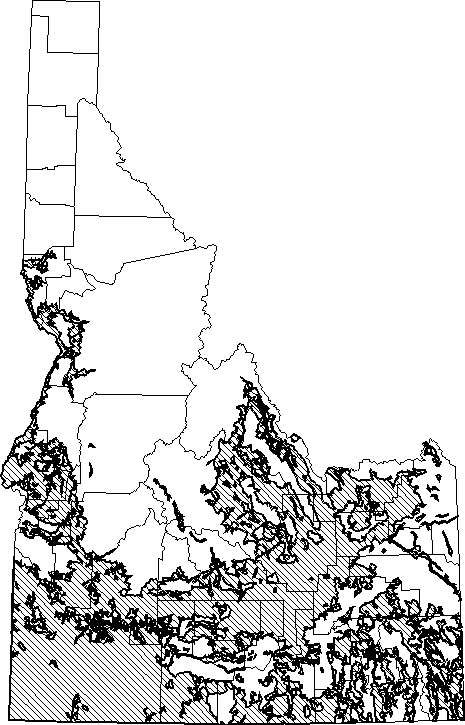
Reithrodontomys megalotis
(Western Harvest Mouse)
Order: Rodentia
Order Description:Rodents
Family: Cricetidae
Family Description: Mice and Rats
Description:
The western harvest mouse is small; total length is 4 ½ to 6 ¾ inches (114-170 mm); the tail is 2 to 3 7/8 inches (50-96 mm), their weight is about 3/8 to ¾ of an ounce (9 – 22 g). They are brownish above, they have buff along their sides, and they are whitish to gray underneath. Their long tail is bicolored, but sparsely haired. An important characteristic is a deep groove running down the middle of the front of each incisor.
Range:
From southern British Columbia, southeastern Alberta, southwestern Saskatchewan, North Dakota, and southern and western Wisconsin, south to northern Baja California, portions of Mexico, Texas, western Oklahoma, Kansas and northeastern Arkansas, and east to Indiana.
Habitat:
Found, up to 3960 m, in old fields, meadows, weedy roadsides, agricultural areas, grassy situations within pine/oak forests, and riparian borders. May also be found in shrubby arid regions. Prefers dense vegetative cover. In Idaho, prefers grassy areas in shrub steppe (Idaho study reported highest density in crested wheatgrass).
Diet:
Prefers seeds of weeds and grasses, but also eats some herbaceous material. In Idaho, eats beetles, seeds, and leaves of sagebrush, halogeton, and grass.
Ecology:
This mouse is primarily nocturnal, with most activity occurring on moonless, rainy nights. They use runways made by voles, and typically occur in areas where voles are present. In a California study, individuals began moving along vole runways about 0.5 hr after sunset, and runway activity ended about 0.5 hr before sunrise. This species climbs in vegetation. Their home range is usually about 0.5 to 1.5 acres (0.2-0.6 ha). Long-distance movements of up to 2 miles (3200 m) have been recorded in Kansas, but a vast majority moved less than 0.19 miles (300 m). Population density has been recorded at 2 to 4 per acre (0.4 ha), but may reach 24 per acre (0.4 ha) in optimum habitat. Populations may decline during peaks in vole abundance. They form mixed-sex social units dominated by a male. They build spherical nests, typically on the ground, but some above ground in shrubs. Adults molt twice annually. Like most mice, they have a very high mortality rate; few reach 12 months of age.
Reproduction:
They breed year-round, but mostly in early spring to late autumn. Gestation lasts 23 to 24 days. Litter size varies from 1 to 6 young (average 4). may produce multiple litters annually. Young are weaned in slightly less than 3 weeks, and reach sexual maturity in 2 to 4 months and females may produce multiple litters annually. Obviously their reproductive capacity is very high.
Conservation:
| Status: | Unprotected nongame species |
|
Global Rank: |
G5 |
|
State Rank: |
S5 |
Important State References:
Larrison, E.J. and D.R. Johnson. 1973. Density changes and habitat affinities of rodents of shadscale and sagebrush associations. Great Basin Natur. 33:255-264.
Information written by Donald Streubel,© 2000
Map image provided by Stephen Burton,© 2000
Design by Ean Harker©1999, 2000.
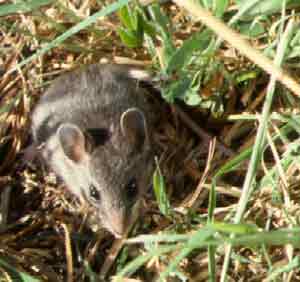
Peromyscus maniculatus
(Deer Mouse)
Order: Rodentia
Order Description:Rodents
Family: Cricetidae
Family Description: Mice and Rats
Description:
The deer mouse has large ears, black, beady eyes, a distinctly bicolored tail and white feet. It occurs in two color phases, the back and sides can be gray or brown, and belly underneath is always white. Its tail is distinctly bicolored, gray or brown on top, and white underneath. Total length is 4 ¾ to 8 ¾ inches (119-22 mm), tail length is 1 ¾ to 4 ¾ inches (46-123 mm). It weighs 3/8 to 1 1/8 ounces (10-33 g).
Range:
Occurs in most of North America; absent in most of Alaska, northern Canada, and western and southeastern Mexico.
Habitat:
Being so widely distributed, it is found in a great variety of upland and riparian habitats, from open areas and brushlands to coniferous and deciduous forests. It is found in deserts, grasslands and woodlands. It also is attracted to human-built structures, cabins, sheds and even houses. It is commonly a pest in many rural human dwellings.
Diet:
Eats arthropods, other invertebrates, fruits, nuts, seeds, green plant material, and fungi. Insects, worms, and snails are most important in summer.
Ecology:
Deer mice are primarily nocturnal, and active throughout the year. They may store food. Their home range averages 2.5 acres (1 ha) or less, but may vary from a few hundred to a few thousand square meters, depending on circumstances. They exhibit territorial behavior during high population densities. population density is generally lowest in spring, highest in fall (sometimes up to about 30 per 2.5 acres (1 ha); densities as high as 109 per 2.5 acres (1 ha) and 163 per 2.5 acres (1 ha) have been reported. Idaho studies of effects of logging and grazing on small mammals show deer mice numbers were not affected by logging or grazing. Species is most abundant small mammal in most Idaho desert habitats, and most common mammal in Idaho. Being nocturnal, they are heavily preyed on by owls, (studies have shown that they can comprise almost half the food intake of owls), foxes and many other predators. Garter snakes seem to follow them into their nest burrows and consume the newborn mice. Considering their high reproductive potential, they obviously have a very high mortality rate due to predation and other factors. They do not hibernate and are active under the protective cover of snow during the winter. They do construct burrows, but also utilize burrows of other small mammals, and they even construct grass-lined nests on the surface of the ground in protective cover.
Reproduction:
Their reproductive potential is extremely high, but the breeding season is shorter in their northern range and at high elevations than elsewhere. Gestation lasts 23 days, and litter size averages 5 to 6 in their northern range, 4.5 in their southern range. Young develop rapidly; naked at birth, they grow fur and teeth in one week, and are weaned and become independent at about 4 weeks. Females produce 1 to 2 litters per year in the northern range, more in south. Young-of-year may attain sexual maturity by 2 months, or may not breed in some areas. Some litters are fathered by more than one male. With their high reproductive potential, it is theorhetically possible for one pair of deer mice to be ancestors of about 60 mice in 20 weeks. Obviously, their mortality is high.
Conservation:
| Status: | Unprotected nongame species |
|
Global Rank: |
G5 |
|
State Rank: |
S5 |
Important State References:
Groves, C.R. and B.L. Keller. 1983. Ecological characteristics of small mammals on a radioactive waste disposal area in southeastern Idaho. Amer. Midl. Natur. 109:253-265.
Information written by Donald Streubel,© 2000
Map image provided by Stephen Burton,© 2000
Design by Ean Harker©1999, 2000.
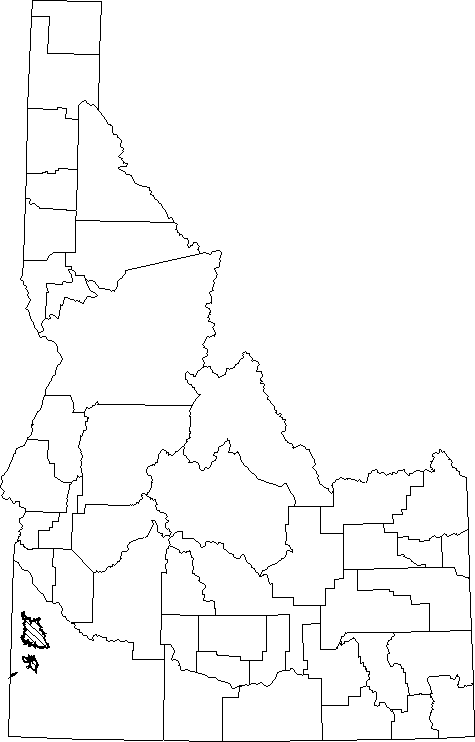
Peromyscus truei
(Piñon Mouse)
Order: Rodentia
Order Description:Rodents
Family: Cricetidae
Family Description: Mice and Rats
Description:
Pinon mice are medium sized compared to other mice, grayish to yellowish-brown above and whitish below. The tail is bicolored, dark on top and light below, heavily furred with a distinct tuft at the end, and their ears are quite large. Total length is 6 ¾ to 9 1/8 inches (171-231 mm), tail length is 3 to 4 ¾ inches (76-123 mm) and they weigh 5/8 to about 1 ounce (19-31 g).
Range:
From central Oregon, northern Nevada, northern Utah, and western and southern Colorado, south to northern Baja California, southeastern Arizona, and southern New Mexico. Disjunct population exists in northern Texas.
Habitat:
They are often found among rocks or on rocky slopes, in a wide variety of habitats, but usually are found in pinyon/juniper woodlands. They are also found in chaparral and desert scrub areas, limestone cliffs, redwood forests, and riparian woodlands. In Idaho, it is found in rocky, desert terrain dominated by western juniper. They seem much more dependent on pinon/juniper woodlands than any other similar species.
Diet:
Feeds on seeds, nuts, berries, fungi, and insects.
Ecology:
Pinon mice are active throughout the year and are primarily nocturnal. They may be the most arboreal mouse of this group, and they exhibit some vocalizations. They carry food in cheek pouches and to deposit in caches. An Idaho study showed home range figures of 0.8-1.4 per 2.5 acres (1ha). They are preyed upon by various vertebrates. Their average life span is less than 1 year.
Reproduction:
They breed primarily in spring and summer, but throughout most of year in Arizona and in some areas of California and Nevada. In New Mexico and Colorado, females produced an average of 3.4 litters per year. Gestation lasts 25 to 27 days for nonlactating females, and about 40 days for lactating females and litter size is about 3 to 4.
Conservation:
| Status: | Unprotected nongame species |
|
Global Rank: |
G5 |
|
State Rank: |
S2 |
Important State References:
Hammond, D.B. and E. Yensen. 1982. Differential microhabitat utilization in Peromyscus truei and Peromyscus maniculatus in the Owyhee Mountains, Idaho. J. Idaho Acad. Science 18:49-56.
Information written by Donald Streubel,© 2000
Map image provided by Stephen Burton,© 2000
Design by Ean Harker©1999, 2000.
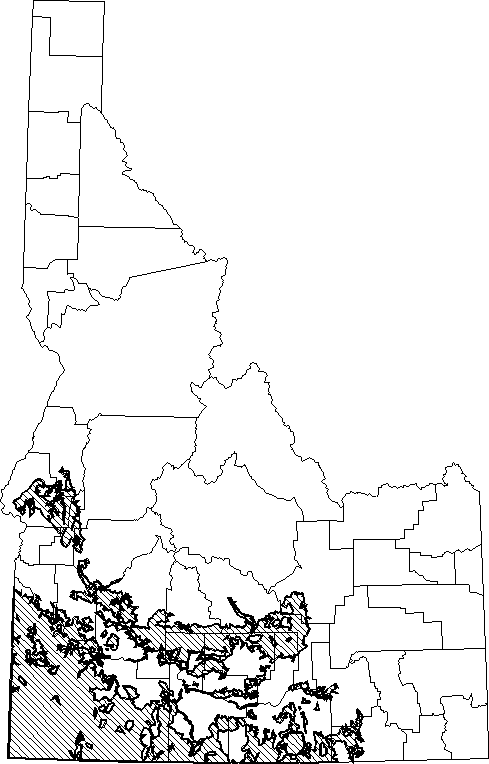
Peromyscus crinitus
(Canyon Mouse):
Order: Rodentia
Order Description:Rodents
Family: Cricetidae
Family Description: Mice and Rats
Description:
Canyon mice are small, grayish to yellow-brown above and whitish below. Its distinctive tail is long, more than half its total body length, darkish on top and whitish below, but heavily furred with a tufted tip. Their ears are smaller than the deer mouse. Total length is 6 ¼ to 7 ½ inches (152-205 mm), tail length is 2 ¼ to 3 ¾ inches (63-97 mm) and they weigh ¾ to 1 5/8 ounce (20-46 g).
Range:
From eastern Oregon, southwestern Idaho, and southwestern Wyoming, south to northwestern Sonora and eastern Baja California Norte, west to northeastern and southeastern California, and east to western Colorado and northwestern New Mexico.
Habitat:
This species is obviously found in canyons, in rocky habitats such as gravelly desert pavement, talus, boulders, cliffs, and slickrock. The vegetation type does not seem to be important. They have been documented in hot, dry deserts near sea level to canyons and rocky habitat in mountains up to 10,000 feet (3000 m).
Diet:
Eats seeds, insects, and green vegetation, depending on availability. In Idaho, diet includes hackberry, rose, currant seeds, and insects.
Ecology:
Canyon mice are active throughout the year. They are primarily nocturnal, and may exhibit diurnal torpor in response to food and water deprivation. They may enter torpor at low environmental temperatures that are less than 42 o F (5° C). They can apparently survive without access to water. Maximum population density has been estimated at 3 per 2.5 acres (1 ha) in California, 27 per 2.5 acres (1 ha) in the Grand Canyon, and 43per 2.5 acres (1 ha) in southeastern Utah. Little is known about the ecology of this species in Idaho.
Reproduction:
Nesting occurs in rocks, even on cliffs. Gestation lasts about 25 to 31 days, and newborn young are heavier than most other mice. Young are altricial at birth, and have a slower postnatal development; they are not weaned until about 28 days, which is later than most other mice. litter size varies from 2 to 4 young per litter (average 3 in southern California and northern Utah). Females may produce multiple litters annually. Young are sexually mature and first breed at 4 to 6 months.
Conservation:
| Status: | Unprotected nongame species |
|
Global Rank: |
G5 |
|
State Rank: |
S3 |
Information written by Donald Streubel,© 2000
Map image provided by Stephen Burton,© 2000
Design by Ean Harker©1999, 2000.
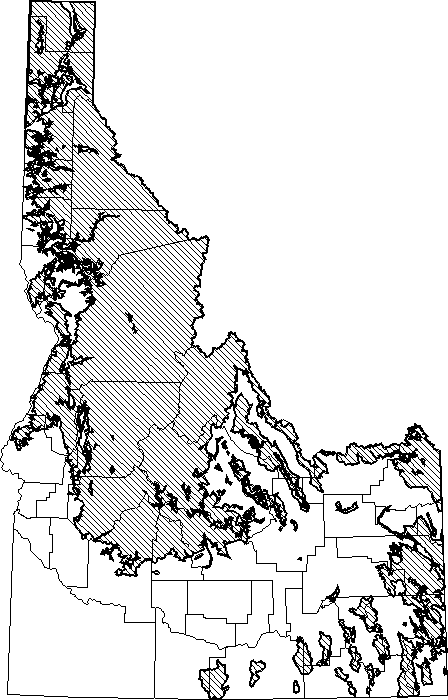
Microtus pennsylvanicus
(Meadow Vole)
Order: Rodentia
Order Description:Rodents
Family: Cricetidae
Family Description: Mice and Rats
Description:
The genus name “microtus” literally mean “small ear”, so this vole and others in the genus Microtus have small ears. Meadow voles are quite dark, dark gray to almost blackish above, but this color is variable. Their feet are dark, and they have a slightly bicolored tail. The tail is about twice the length of the hind foot. They are difficult to distinguish from montane voles. Total length is 6.7 to 7.4 inches (160-185 mm), tail length is 1.8 to 2.4 inches (45-60 mm), and they weigh 1 to 2.3 ounces (30-65 g).
Range:
Most of Canada and Alaska, south through northern half of U.S. to Oregon, northern Utah, central New Mexico, northern Missouri, and Georgia. Has greatest distribution of any vole species in North America.
Habitat:
Found in variety of habitats, from dry pastures and weeded swamps to marshes and orchards. Needs loose organic soils for tunneling. In Idaho, prefers moist grasslands, woodlands, and meadows.
Diet:
Eats vegetable matter such as grasses, roots, and seeds.
Ecology:
The meadow vole and other voles exhibit a distinct population cycle of 2 to 4 years. During this cycle, population at the low point can be 1 to several per acre (0.4 ha) to nearly 100 per acre (0.4 ha) at the peak of the cycle. Since this is such a short term cycle ( 2 to 4 years), predators that rely on meadow voles as prey during the peak of the cycle, need to switch prey during the low of the cycle. Meadow voles are active during the day (diurnal), so they tend to be preyed on by diurnal predators such as coyotes, hawks, weasels and others. They do not hibernate, but are active all winter. They nest on the ground in clumps of dry grass that are usually concealed under brush or logs. They use shallow burrows during the winter. They create distinctive runways in the dense vegetation of their habitat. The voles clip the grass to form the runways and they leave piles of clipped grass along the runways. Males have larger home ranges of about 0.5 acres (0.2 ha) than females (0.25 acre; 0.1 ha) This species has been extensively studied by population biologists, but the cause of their drastic, cyclic, population fluctuations has not yet been clearly elucidated.
Reproduction:
Meadow voles can breed year around, although winter breeding may only be associated with the availability of snow cover or the peak of the population cycle. Peak breeding activity occurs curing April to October. Gestation lasts approximately 21 days, and litter size varies from 1 to 9 young (average is 4 to 5). litter size is smaller in fall than in spring or summer. Young develop rapidly and are weaned at 12 to 14 days. They are capable of breeding at 4 to 6 weeks of age. Females may produce more than 5 litters per year. Their huge reproductive potential is dampened by a very high mortality rate. About 90 % of the young die in their first month of life. It has been calculated that only about 1 in 50 reaches 100 days old, which only allows it enough time to produce 3 litters in their life.
Conservation:
| Status: | Unprotected nongame species |
|
Global Rank: |
G5 |
|
State Rank: |
S5 |
Important State References:
Hoffman, G.R. 1960. The small mammal components of six climax plant associations in eastern Washington and northern Idaho. Ecology 41:571-572.
Information written by Donald Streubel,© 2000
Map image provided by Stephen Burton,© 2000
Design by Ean Harker©1999, 2000.
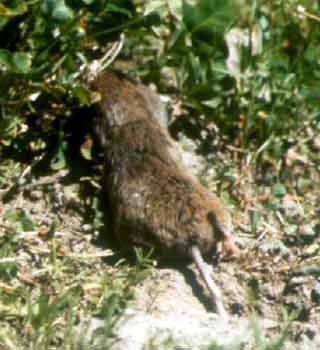
Microtus montanus
(Montane Vole)
Order: Rodentia
Order Description:Rodents
Family: Cricetidae
Family Description: Mice and Rats
Description:
Montane voles is about the same size as the meadow vole, but it is lighter on top; brownish to grayish-brown sometimes mixed with buff or gray which gives it a grizzled appearance. The ventral side is silvery gray. It has a bicolored tail that is about 2.5 times as long as the hind foot. It is not easy to distinguish from the meadow vole. Total length is 5.3 to 7.6 inches (132-190 mm), tail length is 1.4 to 2.3 inches (35-58 mm), and they weigh 1.2 to 3.2 ounces (34-90 g).
Range:
From southwestern British Columbia, south through western U.S. to Arizona and New Mexico.
Habitat:
The montane vole seems to prefer slightly drier habitat than the meadow voles and where they co-occur, the montane vole favors drier habitat. They are found in alpine meadows in their southern range, and in mountain valleys in the northern part of their range. They generally prefer wet meadows and cropland (especially fields and pastures of grass and legumes along fence rows), and grassy areas by streams and lakes. In Idaho, are typically found in moist, mountain meadows and high valleys, but also in shrub steppe (especially crested wheatgrass).
Diet:
Eats grasses and sedges, and leaves, stems, and roots of wide variety of forbs. In Idaho, diet includes grass shoots, seeds, bulbs, tree bark, shrubs, and agricultural crops.
Ecology:
Like the meadow vole, they live in runways and burrows in dense grass. These runways can often be observed by looking carefully at ground level in dense grassy habitat. They are active throughout year, and tend to by diurnally active. Populations may fluctuate dramatically, as their populations exhibit a 3 to 4 year population cycle between highs and lows. In a Utah study, peak population density reached 375-560 per 2.5 acres (1 ha). Utah researchers have also found that a specific chemical factor in their spring food (vegetation) stimulates reproduction. Social organization changes according to population density. Males and females both maintain territories. The male territory is larger and excludes other males but includes several females. The female maintains a small territory, and during estrus she will drive away other females but not males or her young. During periods of low population densities, the female moves to a new territory after her litter is weaned, leaving her young behind. During high population densities the female forces her young to disperse, causing extremely high mortality for the inexperienced young. An Idaho study suggested that cattle grazing may negatively impact populations. This species is important prey to many avian and mammalian predators.
Reproduction:
The primary breeding season is from March to November, but it is capable of breeding year-round, depending on population density. Females can breed shortly after giving birth, and young females can breed at an age of only 3 weeks. A female usually produces 2 to 3 litters per year. Average litter size is about 6 (in northwestern Wyoming, litter size peaked at 3 to 4 year intervals). Again, an incredible reproductive potential exists in this species, but very high mortality rates keep the population in check. Its longevity is probably similar to the meadow vole.
Conservation:
| Status: | Unprotected nongame species |
|
Global Rank: |
G5 |
|
State Rank: |
S5 |
Important State References:
Smolen, M.J. and B.L. Keller. 1979. Survival, growth, and reproduction of progeny from isolated high and low density populations of Microtus montanus. J. Mammal. 60:265-279.
Information written by Donald Streubel,© 2000
Photo from the Yellowstone- National Park Service, © Nov 2001.
Map image provided by Stephen Burton,© 2000
Design by Ean Harker©1999, 2000.
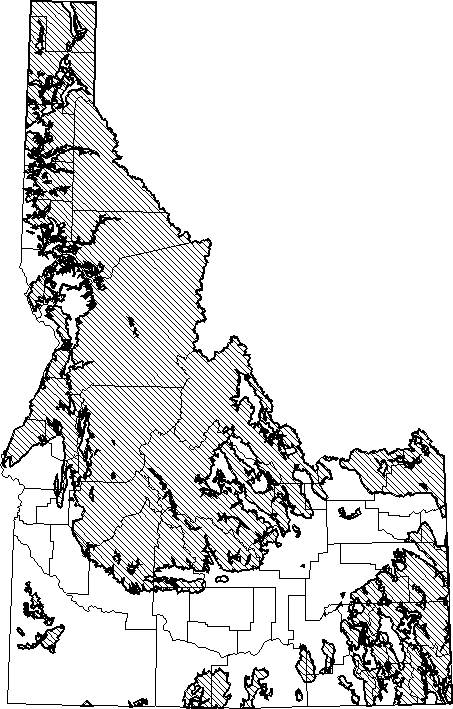
Microtus longicaudus
(Long-tailed Vole)
Order: Rodentia
Order Description:Rodents
Family: Cricetidae
Family Description: Mice and Rats
Description:
As their name implies, they have a longer tail than other voles; it is typically more than 30 % of its body length. They are grayish brown on top, sometimes streaked with blackish hairs, and lighter underneath and they are typically larger than the montane or meadow voles. Total length is 7 to 8.4 inches (175-210 mm), tail length is 2.2 to 3 inches (55 – 75 mm), and they weigh 1.4 to 1.9 ounces (40-55 g).
Range:
From east-central Alaska, south through western Canada and western U.S. to Arizona and New Mexico. Populations at eastern and southern edges of range are generally restricted to high elevations in isolated mountains.
Habitat:
Found, up to at least 3650 m, in various habitats ranging from dense coniferous forests to rocky alpine tundra and shrub steppe. Found in moist meadows, marshes, forest-edge habitat, and recently-cut or burned forests. Not as dependent on moisture as meadow or montane voles.
Diet:
Eats green vegetation, seeds, berries, and fungi. In winter, may feed on inner bark of shrubs and trees.
Ecology:
This species usually does not make well-defined runways like the montane and meadow voles. They will burrow and remain beneath snow for long periods. In Idaho, they are active day and night year-round. Populations may fluctuate dramatically. Population densities are usually relatively low, but may build up to 42 per acre (0.4 ha). Home ranges have been estimated to be about 0.6 (.24 ha)acre for males and 0.5 acre (.20 ha) for females. Individuals seldom live more than 1 year. This species seems to be more solitary than other voles.
Reproduction:
Breeds mid-May to mid-September in Alaska and Idaho, May-October in Nevada (but mostly June-July). Females produce 1-4 litters/yr in Alberta (average 2); in Alaska females produce maximum of 2 litters during lifetime. litter size varies from 2-8; in Alberta, average is 4, in Alaska, 5. Young-of-year breed in Alberta, but not in Alaska.
Conservation:
| Status: | Unprotected nongame species |
|
Global Rank: |
G5 |
|
State Rank: |
S5 |
Important State References:
Rickard, W.H. 1960. The distribution of small mammals in relation to climax vegetation mosaic in eastern Washington and northern Idaho. Ecology 41: 99-106.
Information written by Donald Streubel,© 2000
Map image provided by Stephen Burton,© 2000
Design by Ean Harker©1999, 2000.
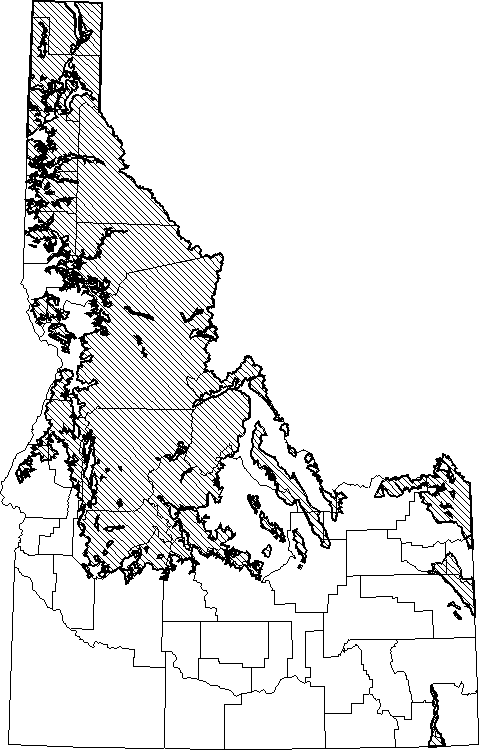
Microtus richardsoni
(Water Vole)
Order: Rodentia
Order Description:Rodents
Family: Cricetidae
Family Description: Mice and Rats
Description:
The water vole is the largest of the voles; it is uniformly dark gray-brown to dark reddish-brown above and grayish with a whitish or silvery tinge below. It has a fairly long bicolored tail. Total length is 7.9 to 11 inches (198-224 mm), tail length is 2.6 to 3.9 inches (66-98 mm), and they weigh about 4.2 ounces (120 g).
Range:
Two disjunct ranges: from southwestern British Columbia, south through Washington and Oregon; and from southeastern British Columbia and southwestern Alberta, south through western Montana, western Wyoming, and Idaho to central Utah.
Habitat:
Found in subalpine and alpine meadows close to water, especially swift, clear, spring-fed or glacial streams with gravel bottoms. Also found in marshes and pond edges.
Diet:
Leaves and, occasionally, stems of forbs are major foods. They also eat grasses, sedges, and willows. They appear to feed on subterranean parts of plants, such as bulbs, throughout the year. It may occasionally consume insects.
Ecology:
Another unique feature of this vole is its semi-aquatic habits. It has burrows and runways in the banks and generally, very close to the edge of small waterways, and it frequently swims across the small streams. It is active throughout the year, and uses underground nests. It is almost like a miniature muskrat, and is definitely more restricted to water than other voles. Populations may fluctuate dramatically yearly or seasonally. In Alberta, monthly density estimates (June-September) in several streamside sites ranged from 0.2-12.2 per 2.5 acres (1 ha); seasonal recruitment from reproduction increased the population size 0.8 to 6.2 times, with highest numbers occurring in August or September. Most individuals overwinter only once, again, because of very high mortality. Individuals dig burrows and swim to escape capture. They are most likely preyed on by hawks, weasels, coyotes and others.
Reproduction:
In an Alberta study, mating activity was recorded in late May to early June through August and September. Young were first documented in the population in early July. Females produced a maximum of 2 litters per year with an average litter size was about 5 to 6 (range 2-9), and about 26% of young bred before their first winter. In the laboratory this vole has a Gestation of 22 days.
Conservation:
| Status: | Unprotected nongame species |
|
Global Rank: |
G5 |
|
State Rank: |
S4 |
Information written by Donald Streubel,© 2000
Map image provided by Stephen Burton,© 2000
Design by Ean Harker©1999, 2000.
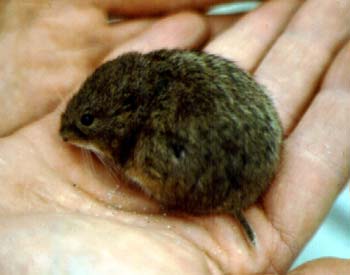
Lemmiscus curtatus
(Sagebrush Vole)
Order: Rodentia
Order Description:Rodents
Family: Cricetidae
Family Description: Mice and Rats
Description:
Sagebrush voles have fairly long, pale gray to dark gray hair above, and silvery gray hair underneath. The short tail is somewhat bicolored, darker above and lighter below. The soles of its feet are densely furred. It is similar in appearance to montane voles, but is typically in much drier habitat than the montane vole. Total length is 4.4 to 5.6 inches (110-140 mm), tail length is 0.64 to 1 inch (11-18 mm), and it weighs 0.6 to 1.2 ounces (17-35 g).
Range:
Portions of Great Basin, extending east through Rocky Mountains of Colorado, Wyoming, and Montana, to edge of Great Plains and just into southern Canada.
Habitat:
Found in well-drained soil (may be rocky), in semi-arid prairies, shrub steppe, rolling hills, and brushy canyons. Vegetation is usually dominated by sagebrush and bunchgrasses, especially crested wheatgrass.
Diet:
Eats almost any green plant material, including bromegrass (but not ripe seeds) and other grasses. Also eats leaves, flowers, and stalks of buckwheat, and some sagebrush leaves. In Idaho, paintbrush and lupine are most common foods in June and August; diet also includes sagebrush, bluebrush, squirreltail, onion, tumble mustard, and downy chess.
Ecology:
This species is active throughout day and year-round, but main activity periods occur 2 to 3 hours before sunset and again 2 to 3 hours after full darkness. When inactive, they occupy an underground burrow which can be lined with sagebrush bark. In winter they occur in clusters, with up to 30 burrow entrances clustered near sagebrush with underground nests about 3 feet underground. There is some evidence that in the spring, they move as a group, to locations such as south-facing slopes where plant growth is advanced. Population density fluctuates widely, but is not cyclic like some of the other voles. An Idaho study documented an average population density of 4 to 16 per 2.5 acres (1 ha) in different areas at different seasons.
Reproduction:
This species appears to breed year-round, except in its northern range, where it may not breed in winter. Most breeding occurs from March to May and again from October to December. A female produces up to 3 litters per season. Gestation averages 25 days, and average litter size is 4 to 6 young (5.6 in Idaho). The young are weaned at about 3 weeks and are sexually mature at one to two months.
Conservation:
| Status: | Unprotected nongame species |
|
Global Rank: |
G5 |
|
State Rank: |
S4 |
Important State References:
Mullican, T.R. and B.L. Keller. 1986. Ecology of the sagebrush vole in southeastern Idaho. Can. J. Zool. 64:1218-1223.
Information written by Donald Streubel,© 2000
Photo by Tim Mullican
Map image provided by Stephen Burton,© 2000
Design by Ean Harker©1999, 2000, 2001.
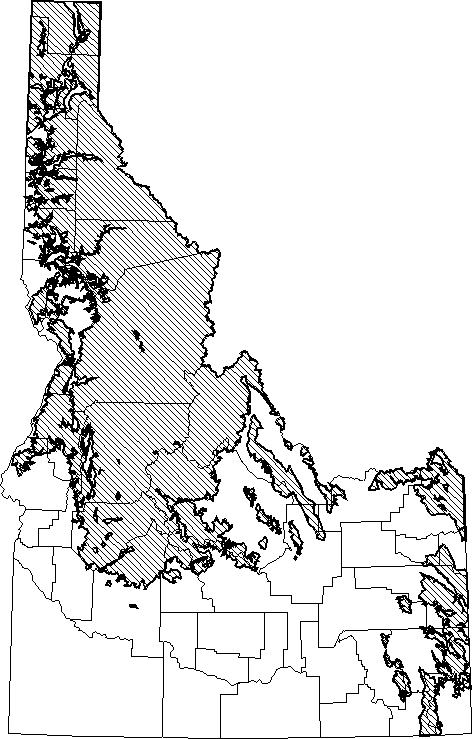
Phenacomys intermedius
(Heather Vole)
Order: Rodentia
Order Description:Rodents
Family: Cricetidae
Family Description: Mice and Rats
Description:
This little-known small mammals is grayish-brown above with a light gray to silvery color underneath. They have a fairly short, bicolored tail. They are hard to distinguish from the montane and meadow voles. Total length is 4.6 to 6.2 inches (115-155 mm), tail length is 0.9 to 1.3 inches (22-33 mm), and it weighs 0.9 to 1.4 ounces (25-40 g).
Range:
From Labrador, west across northern Canada to Yukon Territory, and south to Sierra Nevada and through Rocky Mountains to northern New Mexico.
Habitat:
Found, from sea level to above treeline, in open coniferous forests with heath or shrub understory, in shrubby areas on forest edges, in mossy meadows in forests, and in alpine tundra with cover. Has been trapped in burned and logged areas of northern Idaho.
Diet:
In winter, feeds on bark and buds of shrubs and heaths. In summer, feeds primarily on green vegetation, berries, and seeds.
Ecology:
Relatively little is known about the heather vole, but it is thought to be evolutionarily ancestral to other voles. They do not develop well-defined runways as other voles do, except in the immediate vicinity of their nests. In winter, this non-hibernator builds spherical nests of grasses and lichens under snowcover, and it lives in shallow burrows under logs, roots, or rocks during the summer. Unlike other voles, this species stores some food in winter and summer. It appears to be solitary in summer, except during the breeding season. Family groups may occupy communal nests in winter. population density estimates range from 0.5-10 per 2.5 acres (1 ha) in different habitats in different areas. Preliminary results of a northern Idaho study indicated that this species is uncommon in old-growth coniferous forest stands but more abundant in second-growth and clearcut areas.
Reproduction:
Gestation lasts 19-24 days. Young are born mid-June to early September (season may possibly be more restricted at high elevations). In general, young-of-year females produce 3-4 young (average); older females may produce 2 litters of 4-6 young/litter.
Conservation:
| Status: | Unprotected nongame species |
|
Global Rank: |
G5 |
|
State Rank: |
S4 |
Important State References:
Groves, C.R. 1994. A preliminary report: effects of timber harvest on small mammals and amphibians in old-growth coniferous forests on the Priest Lake Ranger District, Idaho Panhandle National Forests. Idaho Dept. Fish & Game, Boise. 18pp.
Information written by Donald Streubel,© 2000
Map image provided by Stephen Burton,© 2000
Design by Ean Harker©1999, 2000.
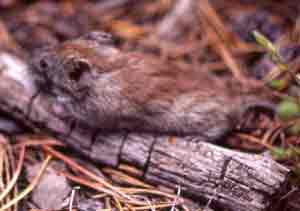
Clethrionomys gapperi
(Southern Red-backed Vole)
Order: Rodentia
Order Description:Rodents
Family: Cricetidae
Family Description: Mice and Rats
Description:
This small, mouse-type mammal has dark brown hair on its back with a reddish, rusty colored band from its head to its tail. Its is grayish to whitish underneath. Its short tail is somewhat bicolored. Total length is about 5 to 6.8 inches (124-170 mm), tail length is 1.4 to 1.8 inches (34-45 mm), and they weigh 0.6 to 0.7 ounces (18-22 g).
Range:
Most of forested Canada, south through Rockies, northern Great Plains, northern Great Lakes, New England, and Appalachian Mountains.
Habitat:
Prefers cool, moist, deciduous, coniferous or mixed forests, especially areas with large amounts of ground cover. Will also use second-growth areas. Mossy logs and tree roots in coniferous forests are optimal. Idaho study found species prefers mature grand fir stands over younger stands.
Diet:
The red-backed vole might be best described as an opportunistic feeder; feeding on fungi (mushrooms) during summer and fall, but shifting to seeds, some roots and bark during the winter. They are also known to eat insects.
Ecology:
They are active year-round, and they appear to be mainly nocturnal. Like deer mice, they travel under thj snow all winter and range over an area of about 1.3 acres (0.5 ha). They build round nests about 4 inches across, composed of grasses and other fine materials. The nests are on the ground and usually tucked under logs or stumps. They appear to have a large water requirement for their size (compared to other similar-sized mice) which probably accounts for their moist habitat requirements. They are know to be important dispersers of viable spores of mycorrhizal fungi and nitrogen-fixing bacteria. Mature females are thought to be territorial. Their populations are do not cycle like other “voles”. In Idaho, population density peaks in late summer to early fall and density up to 26 per acre (65 per ha) have been recorded. This species does not colonize area that have been recently burned, and clearcut logging may reduce their populations. This species is preyed upon by mustelids, canids and raptors. The red-backed vole is often the most common small mammal in coniferous forests.
Reproduction:
They breed in mid-January to late November, but peak breeding activity occurs February to October. Gestation lasts 17 to 19 days, and litter size varies from 1 to 9 young (average 5.6 in Alberta, 6.5 in Colorado). In Alberta, young females produce 1 to 4 litters per year, older females produce 1 to 6; in Colorado, females produce 2 litters per year, and young-of-year breed as well.
Conservation:
| Status: | Unprotected nongame species |
|
Global Rank: |
G5 |
|
State Rank: |
S5 |
Important State References:
Scrivner, J.H. and H.D. Smith. 1984. Relative abundance of small mammals in four successional stages of spruce-fir in Idaho. Northwest Science 58:171-176.
Information written by Donald Streubel,© 2000
Map image provided by Stephen Burton,© 2000
Design by Ean Harker©1999, 2000.
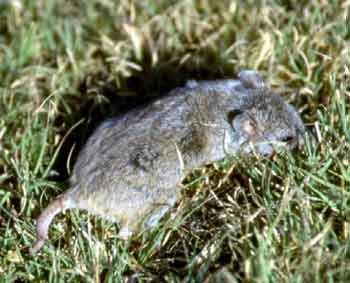
Onychomys leucogaster
(Northern Grasshopper Mouse)
Order: Rodentia
Order Description:Rodents
Family: Cricetidae
Family Description: Mice and Rats
Description:
This species has at least two color phases: grayish above, or cinnamon-buff to reddish brown, they are white underneath. As juveniles, they are dark gray. Their tail is shorter, less than half their body length, but it is bicolored with a white tip. Total length is 5 1/8 to 7 ½ inches (130-190 mm), tail length is 1 1/8 to 2 3/8 inches (29-61 mm), and they weigh about 1 to nearly 2 ounces (27-52 g). They have noticeably long front claws and large front feet.
Range:
From south-central Canada, south through Great Plains to northern Mexico. Extends west through Great Basin and southwestern deserts of Arizona and New Mexico, and also occurs in Rocky Mountains.
Habitat:
They occur, in areas with sandy, diggable soil and sparse vegetation, in grasslands, shrub steppe, overgrazed pastures, weedy roadside ditches, and semi-stabilized sand dunes. In Idaho, species is most numerous in sagebrush areas, but usually in fine sandy or silty soils.
Diet:
Eats 70-90% animal material, primarily arthropods (grasshoppers, beetles, spiders, larval Lepidoptera), but will also eat plant material and small rodents, especially in winter.
Ecology:
Grasshopper mice are active throughout the year, although their activity is greatly reduced during the full moon or heavy, prolonged rainfall. They are nocturnal but their activity seems influences by lunar phases. They occupy underground burrows when inactive which they plug for moisture retention and temperature regulation. They also dig small "retreat burrows" when away from their nest burrow. They may store seeds. They usually occur at relatively low densities, but may become a controlling factor for prey items. Their predatory behavior is well known. They are active predators killing prey as formidable as scorpions. They kill other rodents by gripping them with their long, front claws and biting the prey. They appear to be territorial and actually mark their territory with scent glands. They also emit shrill whistles that seem to function in advertising their presence, much like larger predators like coyotes. They are aggressive toward others of their species, which may be associated with their territorial behavior. They maintain an unusually large home range (or territory) for a small mammals; up to 5.8 acres (2.3 ha).
Reproduction:
Breeding occurs from late spring to early fall, and Gestation lasts about 32 to 38 days. litter size is typically 3 to 4 young, but ranges from 1 to 6. Males assist in caring for the young by bringing insects in to the young. This is very different from typical rodent behavior where males rarely help care for young. Young develop rapidly, and seem to act like young dogs or coyotes by fighting and seeming preparing for their predatory life style. Young reach sexual maturity at 3-4 mo.
Conservation:
| Status: | Unprotected nongame species |
|
Global Rank: |
G5 |
|
State Rank: |
S4 |
Important State References:
Reynolds. T.D. 1980. Effects of some different land management practices on small mammal populations. J. Mammal. 61:558-561.
Information written by Donald Streubel,© 2000
Photos by James Moodie, © Feb 1998.
Map image provided by Stephen Burton,© 2000
Design by Ean Harker©1999, 2000.
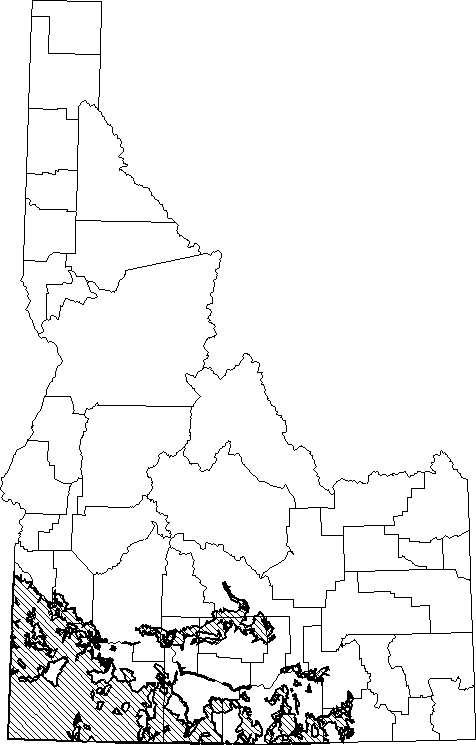
Neotoma lepida
(Desert Woodrat)
Order: Rodentia
Order Description:Rodents
Family: Cricetidae
Family Description: Mice and Rats
Description:
The desert woodrat is yellowish brown to grayish brown above and gray below. They may have streaks of black on their back. Their tail is bicolored, dark on top and white below and their feet are white. Their total length is 8 ¾ to 15 inches (225-380 mm), and tail length is 3 ¾ to 7 ¼ inches (95-188 mm).
Range:
From southeastern Oregon and southwestern Idaho, south to Baja California and extreme northwestern Sonora, Mexico.
Habitat:
Found in sagebrush scrub, in chaparral, and in deserts and rocky slopes with scattered cactus, yucca, pine/juniper, and other low vegetation. In Idaho, occupies rocky areas of desert habitat in greasewood, sagebrush and hopsage.
Diet:
They feed on beans and leaves of mesquite, on juniper, and on parts of available cacti, apparently without getting injured by the spines, creosote bush, thistle, and ephreda. They will also eat other green vegetation, seeds, fruits, acorns, and pine nuts.
Ecology:
The desert woodrat, like most woodrats are primarily nocturnal. When not out and about feeding they occupy an elaborate den built of debris on the ground, in vegetation, along a cliff, or occasionally in a tree. They often use a kangaroo rat or ground squirrel burrow for their den. They carry in sticks, cactus spines and other debris and carefully pile it over the burrow entrance, seemingly to “fortify” it. This is indicative of the “packrat” nature of woodrats. They have a strong tendency to carry in objects, including other animal dung, to their den sites and thus can create fairly large piles of debris on the desert floor. They are capable of deriving water from their diet. This species is isolated and scarce within their Idaho range. Desert woodrats have a curious behavioral trait of rattling their tail against dry desert vegetation which has a sound similar to rattlesnakes. They are probably preyed on by owls, coyotes, perhaps bobcats, and snakes.
Reproduction:
Gestation lasts 30-36 days. Female produces 4 or more litters/yr. litter size usually varies from 2-3 young, but may number 1-5. Young are weaned in 21-34 days (depending on litter size), and reach sexual maturity in 2-3 mo.
Conservation:
| Status: | Unprotected nongame species |
|
Global Rank: |
G5 |
|
State Rank: |
S4 |
Information written by Donald Streubel,© 2000
Map image provided by Stephen Burton,© 2000
Design by Ean Harker©1999, 2000.
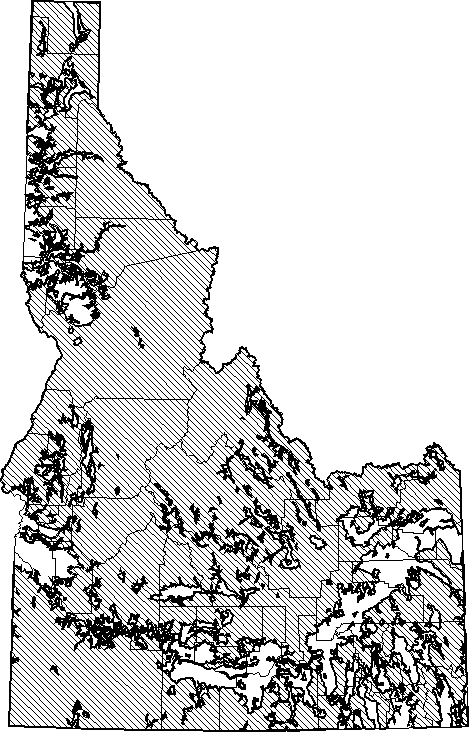
Neotoma cinerea
(Bushy-tailed Woodrat )
Order: Rodentia
Order Description:Rodents
Family: Cricetidae
Family Description: Mice and Rats
Description:
The bushy-tailed woodrat is grayish on its back and tail and lighter underneath, with distinct white feet. It has a fairly large, bushy, but flattened tail, and except for its flat shape, it resembles a squirrel’s tail. It has large ears, prominent eyes, and long whiskers. Total length is about 14 to 18 inches ( 350-450 mm), tail length is 5.4 to 8.8 inches (135-220 mm), and it weighs 8.5 to 10 ounces (240-280 g). The flat, bushy tail is distinctive as other woodrats have round, short-hair tails.
Range:
From Yukon Territory, south to northern Arizona and New Mexico.
Habitat:
Inhabits mountains, cliffs, talus slopes, caves, and rock outcrops, both in forests and open deserts. Can also be found in deserted buildings and mine shafts.
Diet:
Feeds on twigs, shoots, leaves, needles, fruits, and seeds. Southeastern Idaho study found grass, cactus, vetch, sage, and mustard in diet as well as a few arthropods.
Ecology:
This species is active throughout year. They are primarily nocturnal, but may occasionally be seen during day. This species is the true packrat of the group. They have a strong habit of picking up debris, sticks, bones, conifer cones, ungulate, coyote, or other scats, and shiny objects that careless humans might drop, including keys, aluminum can tabs, etc. and carrying them into their nest area. They are sometimes called “traderats” as they tend to drop one item thay may be carrying when they see something else to pick up. Their nests usually are behind piles of debris that they haul in. Their nests are commonly found on cliffs and small caves. They have a unique characteristic of depositing their feces in creacks in rocks adjacent to their nests. When examining these deposits, you cannot help having a strong sense of curiosity at the function of this elaborate behavior. It must be significant in their life history because it is obviously very deliberate and requires considerable energy. These woodrats are territorial and mark their territory with a musky scent. Male may exclude other males from small rock outcrop inhabited by multiple females. They are also adept tree climbers. Because their habitat requirements are quite specific and they are territorial, their population densities are sparse. They are known to thump their hind legs when disturbed. They are probably preyed on by owls, bobcats, coyotes and long-tailed weasels. Their nests have been known to persist over long periods of time because when a nest owner dies, another woodrat will take it over. Archaeologists and paleontologists have actually studied debris in the piles by nests and they have found items that have been in the nests for thousands of years. This provides clues about early humans as well as climate in early times.
Reproduction:
Breeding peaks in spring. Gestation lasts about 5 wk. Female produces 2-3 litters of 3-4 young/litter. Births occur April-August in California. Young males disperse by 2.5 mo; many females breed in natal area.
Conservation:
| Status: | Unprotected nongame species |
|
Global Rank: |
G5 |
|
State Rank: |
S5 |
Important State References:
Johnson, M.K. and R.M. Hansen. 1979. Foods of cottontails and woodrats in south-central Idaho. J. Mammal. 60:213-215.
Information written by Donald Streubel,© 2000
Map image provided by Stephen Burton,© 2000
Design by Ean Harker©1999, 2000.
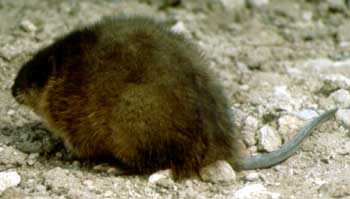
Ondatra zibethicus
(Muskrat)
Order: Rodentia
Order Description:Rodents
Family: Cricetidae
Family Description: Mice and Rats
Description:
The muskrat is well-named; it has musk glands near the base of the tail which give the species a musky odor and its name. It is well adapted to its aquatic existence. Even though it is much larger, it resembles its relatives, the voles, in that it has a large head with small ears and eyes. It has a very dense underfur which actually traps air and forms a waterproof barrier. Its lips seal closed behind its incisors, which allows underwater foraging without gulping in the pond or stream. Its pelage is dark brown to reddish-brown on top and silvery-gray underneath. Its tail is laterally compressed to form a rudder for swimming, and it has stiff hairs forming a fringe around its feet, and partial webbing, which help for swimming. They are large compared to other members of this family; total length is 18 to 22 inches (460-550 mm), tail length is 8 to 10.2 inches (200-254 mm), and they weigh 1.5 to 4 pounds (0.7-1.8 kg).
Range:
Throughout North America north of Mexico, except portions of southwestern U.S. and Florida.
Habitat:
Prefers fresh or brackish marshes, lakes, ponds, swamps, and other bodies of slow-moving water. Most abundant in areas with cattails. Rare or absent from large, artificial impoundments where fluctuating water levels eliminate littoral zone plants (food supply). In Idaho, occurs primarily in lowland ponds, lakes, marshes and streams.
Diet:
Diet consists primarily of aquatic plants, particularly cattails, cordgrass, and bulrushes. Also eats crustaceans and mollusks; in some areas may eat large numbers of mussels.
Ecology:
They are active year-round and during the winter are able to swim out of their den under the ice to acquire food. They can swim up to 180 feet (55 m) under water and can stay submerged for up to 20 minutes. They are mainly nocturnal, but frequently seen in daylight. Activity seems to peak twice daily: between 1600 and 1700 hours, and between 2200 and 2300 hours. They construct dens in bank burrows or conical houses of vegetation in shallow, heavily vegetated water. They build rooted feeding platforms in their houses. Their home range is relatively small as they usually do not forage more than about 35 feet (11 m) from their home site (in marginal areas, foraging excursion areas are greater). Populations fluctuate as density may reach up to 90 per 2.5 acres (1 ha), but it is usually much less. Individuals are generally solitary, but several may use same general area, and in winter several may congregate in a single den. However, territoriality is common. The species can cause damage to river banks and the banks of irrigation canals. Young often build small nest near their parents house shortly after becoming independent. But, in the fall, they are often driven from the “home” pond by the parents and are forced to disperse. They are vulnerable to predators during this time. Predators include mink, which are known to heavily utilize muskrats, other large carnivores such as coyotes, most likely, large raptors and humans. Their fur is very fine and valuable and the muskrat is one of the most heavily exploited furbearers in North America.
Reproduction:
Breeding occurs in the spring and early summer. Gestation lasts 28 to 30 days and females produce an average of 2 to 3 litters per year. litter size varies from 1 to 12 young but in Idaho the average is about 7. Young are weaned and fairly independent after about 1 month, and reach sexual maturity in 4 to 6 months. A high rate of mortality exists in young.
Conservation:
| Status: | Game species |
|
Global Rank: |
G5 |
|
State Rank: |
S5 |
Important State References:
Reeves, H.M. and R.M. Williams. 1956. Reproduction, size, and mortality in the Rocky Mountain muskrat. J. Mammal. 37:494-500.
Information written by Donald Streubel,© 2000
Photo from Yellowstone- National Park Service, May 2000.
Map image provided by Stephen Burton, 2000
Design by Ean Harker 1999, 2000, 2001.
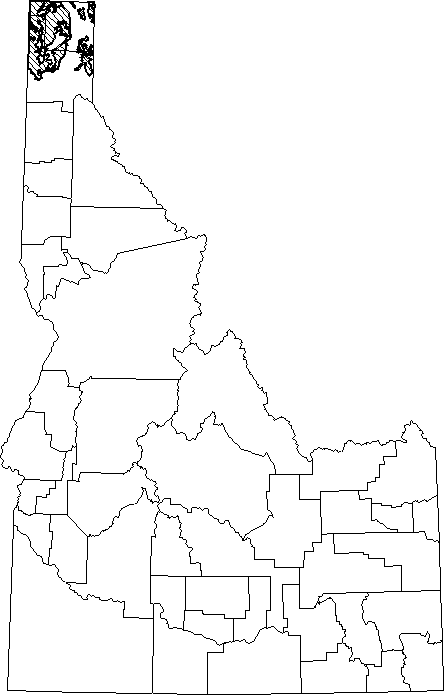
Synaptomys borealis
(Northern Bog Lemming)
Order: Rodentia
Order Description:Rodents
Family: Cricetidae
Family Description: Mice and Rats
Description:
The northern bog lemming resembles voles. They are brownish above and grayish below, and rust-colored hair at the base of their ears. They have a short, bicolored tail. Their upper incisors are grooved which distinguishes them from voles. Total length is 4 ¾ to 5 ½ inches (118-140 mm), tail length is ¾ to 1 1/8 inches (19-27 mm), and they weigh ¾ to 1 ¼ ounces (23-34 g).
Range:
From central Alaska, east to Labrador, and south to Washington, southeastern Manitoba and northern New England.
Habitat:
They are found in sphagnum bogs, wet meadows, moist mixed and coniferous forests, alpine sedge meadows, krummholz spruce-fir forests with dense herbaceous and mossy understory, and mossy streamsides. In Idaho, occupies bog or marsh habitat in montane forest or subalpine zone.
Diet:
Feeds on grasses and other herbaceous vegetation.
Ecology:
They are active day and night throughout the year. They occupy surface runways and burrow systems up to 12 inches (30 cm) deep. Individuals probably maintain a home range of less than 1 acre (0.4 ha). Population densities may reach 36 per acre (0.4 ha). They appear to be very sociable as they may be found in small colonies. Little is known about the ecology of this species.
Reproduction:
They breed from May to August. Gestation probably lasts 3 weeks. Litter size varies from 2 to 8 young (average 4), and a female may produce several litters per year.
Conservation:
| Status: | Protected nongame species |
|
Global Rank: |
G4 |
|
State Rank: |
S1 |
Important State References:
Groves, C. and E. Yenson. 1989. Rediscovery of the northern bog lemming (Synaptomys borealis) in Idaho. Northwest Natur. 70:14-15.
Information written by Donald Streubel,© 2000
Map image provided by Stephen Burton,© 2000
Design by Ean Harker©1999, 2000.
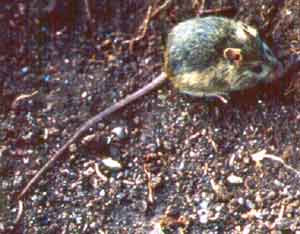
Zapus princeps
(Western Jumping Mouse)
Order: Rodentia
Order Description:Rodents
Family: Zapodidae
Family Description: Jumping Mice
Description:
The western jumping mouse is a beautiful little mammals with a very long tail, dark brown hair on the dorsal surface, white underneath, and yellowish-brown on the sides from the tip of the nose to the base of the tail. The tail is sparsely haired and scaly. The long tail and large hind feet accommodate its hopping (saltatorial) locomotion. Total length is 7.2 to 9.2 inches (180-230 mm), tail length is 4.6 to 5.6 inches (115-138 mm), and they weigh 0.6 to 0.8 ounce (18-24 g).
Range:
From southeast Yukon Territory, east to southwestern Manitoba, south to New Mexico through Rocky Mountains, and south (through eastern Washington and Oregon) to California Sierras.
Habitat:
Found in mountain meadows, along banks of streams and ponds, in marshes, and in dense cover of tall grasses and herbs. In Idaho, prefers wet meadows, bogs, and streamside habitats in forest and subalpine areas. Idaho study in grand fir stands found species preferred willow-alder thickets in mid-successional stages.
Diet:
Feeds on insects and other invertebrates in spring. In midsummer, consumes mostly grass seeds and some berries.
Ecology:
Nocturnal. Hibernates/aestivates. Adult may enter hibernation in September or October. Throughout winter, periods of hibernation alternate with arousal from torpor. In eastern Wyoming, emergence from hibernation occurs mid-May to mid-June; in Utah at high elevations, emergence may not occur until late June or July. When inactive, occupies burrow in well-drained mound, elevated bank, or spherical surface nest. Utah study reported home range averaged 0.2-0.6 ha in different areas in different years. Adult density was 8-32/ha in different areas. Individuals are primarily solitary, are good swimmers, and are known to use erratic running patterns to evade predators.
Reproduction:
Breeding occurs soon after females emerge from hibernation. Gestation lasts 18 days. Most young are born late June-early July. Female apparently produces only 1 litter/yr. litter size is estimated at 2-7 young (average 5). Some females bear first litter at 1 yr.
Conservation:
| Status: | Unprotected nongame species |
|
Global Rank: |
G5 |
|
State Rank: |
S5 |
Important State References:
Scrivner, J.H. and H.D. Smith. 1984. Relative abundance of small mammals in four successional stages of spruce-fir in Idaho. Northwest Sci. 58:171-176.
Information written by Donald Streubel,© 2000
Map image provided by Stephen Burton,© 2000
Design by Ean Harker©1999, 2000.
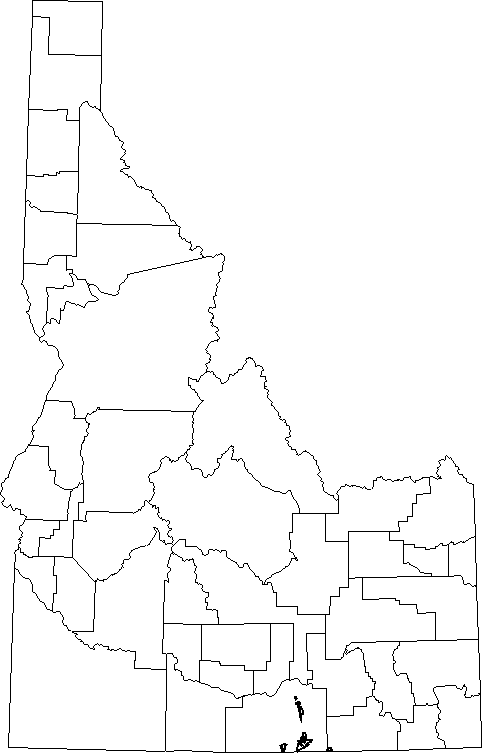
Perognathus longimembris
(Little Pocket Mouse)
Order: Rodentia
Order Description:Rodents
Family: Heteromyidae
Family Description: Pocket Mice,Kangaroo Mice and Rats
Description:
The little pocket mouse is indeed, a small mouse. It occurs in variable colors, the upper body is often yellowish to buff color with some darker, interspersed hair. The ventral side is either buff or brownish. Their coloration seems to somewhat approximate that of the soil they live in. They have a small, white patch at the base of each ear. Total length is about 4 inches to 5 7/8 inches (110-151 mm) and their tail length is just over 2 to 3 3/8 inches (53-86 mm). The tail is not striped, but a uniform brownish color.
Range:
From southeastern Oregon and southwestern Idaho, south to Baja California and northwestern mainland of Mexico.
Habitat:
Found in sagebrush, creosote bush, and cactus communities. On slopes with widely spaced shrubs, found in firm, sandy soil overlain with pebbles. In Idaho, found in shadscale/dwarf sage on lower slopes of alluvial fans in Raft River Valley.
Diet:
Feeds primarily on seeds.
Ecology:
This species is smallest rodent in the Pacific Northwest. The little pocket mouse remains in its den during severe weather and it may enter a state of torpor when inactive. Torpor lowers its metabolic rate considerably and thus saves energy. In Idaho, it is inactive during the winter months, and there is some evidence that it hibernates. If it does hibernate, it is the smallest mammal to do so, with the exception of bats. In southeastern California, it is known to hibernate up to 6.5 months. It is typically nocturnal. In the spring it is most active 2 to 5 hours after sunset, with a second peak just before sunrise. It is able to metabolize water from its food like most members of this family of rodents. It is primarily solitary. Populations may fluctuate markedly from year to year and seasonally. In some areas, such as the desert of Nevada, this species is most abundant mammal; populations have been estimated to be as high as 400 per 0.4 ha (1 acre).
Reproduction:
Female produces 1-2 litters of 3-7 young/litter. Young are born April-July. Species may not reproduce in years with below average precipitation.
Conservation:
| Status: | Protected nongame species |
|
Global Rank: |
G5 |
|
State Rank: |
S1 |
Important State References:
Larrison, E.J. and D.R. Johnson. 1973. Density changes and habitat affinities of rodents of shadscale and sagebrush associations. Great Basin Natur. 33:255-264.
Information written by Donald Streubel,© 2000
Map image provided by Stephen Burton,© 2000
Design by Ean Harker©1999, 2000.
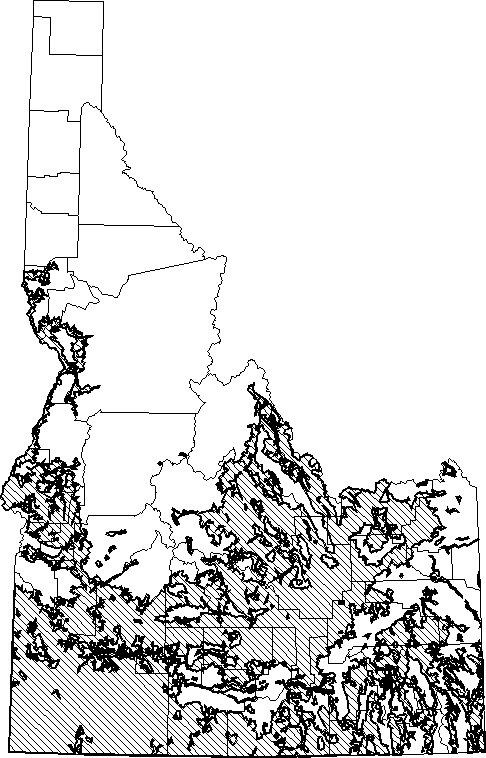
Perognathus parvus
(Great Basin Pocket Mouse)
Order: Rodentia
Order Description:Rodents
Family: Heteromyidae
Family Description: Pocket Mice,Kangaroo Mice and Rats
Description:
The Great Basin pocket mouse is slightly larger than the “Little pocket mouse”. Its Dorsal surface is yellowish occasionally with a pinkish tone to olive-buff. The ventral surface is buff to white. Its long tail is dark above to white below with a small tuft of hairs on the tip. Total length is about 5 ¾ to 7 ¾ inches (148-198 mm) with a tail of about 3 to 4 ¼ inches (77-107 mm).
Range:
From south-central British Columbia, south to southern California, northern Arizona, and southwestern Wyoming.
Habitat:
Found on arid, sandy, short-grass steppes, shrub steppe, and pinyon/juniper woodlands. Usually found in habitats with light-textured, deep soils. Also found among rocks. In Idaho, prefers sagebrush, rabbitbrush, and bitterbrush, as well as grassy fields.
Diet:
Primarily a seed eater, but in spring and summer also feeds on insects and some green vegetation.
Ecology:
Above-ground activity of the Great Basin pocket mouse decreases from October through March when this pocket mouse is hibernating. They may also become torpid in the summer in response to a lack of food or inclement weather. They tend to be nocturnal or crepuscular and they have been shown to be active within an hour after sunset. They store seeds in underground chambers. They may forage in grain fields but rarely, and only when their populations are very high, are they a problem for farmers or ranchers. They are primarily solitary. Their home range has been estimated at up to 1 acre (0.40 ha). In years with abundant precipitation, population density may reach 80 per 2.5 acres (1ha) or more. Their burrows are often at the base of sagebrush and packed piles of soil near the burrow entrance is a diagnostic sign for this species. Predators include snakes, hawks, owls, weasels, badgers and no doubt, other common carnivores.
Reproduction:
The Great Basin pocket mouse mates after it emerges from hibernation in late March or during April. Gestation probably lasts about 22 to 25 days. A female can produce 2 litters per year; the number varies with precipitation. Litter size ranges from 2 to 8 (average about 5). Young are weaned in about 3 weeks. An Idaho study found males were sexually active March-August; juvenile females bred during their first year; males generally did not.
Conservation:
| Status: | Unprotected nongame species |
|
Global Rank: |
G5 |
|
State Rank: |
S5 |
Important State References:
Speth, R.L, C.L. Pritchett, and C.D. Jorgensen. 1968. Reproductive activity of Perognathus parvus. J. Mammal. 49:336-337.
Information written by Donald Streubel,© 2000
Map image provided by Stephen Burton,© 2000
Design by Ean Harker©1999, 2000.
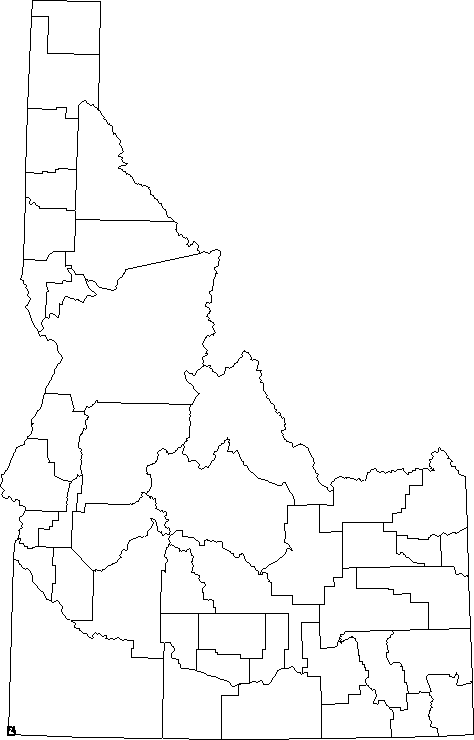
Microdipodops megacephalus
(Dark Kangaroo Mouse)
Order: Rodentia
Order Description:Rodents
Family: Heteromyidae
Family Description: Pocket Mice,Kangaroo Mice and Rats
Description:
Kangaroo mice seem to fit between pocket mice and kangaroo rats. They are slightly smaller than kangaroo rats, but their hind feet are modified for hopping, kangaroo-like. Their tails are shorter than kangaroo rats but are thicker in the middle, which may provide support while hopping on their hind feet. The Dark kangaroo mouse has blackish to grayish hair above, with the hair being gray or lead-colored at the base. Their total length is about 5 ¾ to 7 inches (148-177 mm) long with the tail being from 2 7/8 to nearly 4 inches long (74-100 mm). The tail is thicker in the middle than at either end.
Range:
Southeastern Oregon, northeastern and central-eastern California, Nevada, and west-central Utah.
Habitat:
Found in loose sands and gravel in shadscale scrub, sagebrush scrub, and alkali sink plant communities. May occur in sand dunes near margins of range.
Diet:
Seeds are primary food source, but will also eat some insects.
Ecology:
They are known to store food in seed caches within their burrow systems which consist of an unbranched burrow from 2 to 4 feet long, often about one foot deep. Like most members of this family they do not appear to utilize free water, but acquire water from metabolic processes. They use bipedal locomotion hopping about on their hind limbs, but also walk on all fours. It is not known for certain that they hibernate, but when inactive, they are underground. Activity has been observed only from March to October. They are nocturnal with peak activity occurring in the first 2 hours after sunset. Moonlight and ambient temperature influence activity Predators include owls, foxes, and badgers. In west-central Nevada, a mean yearly circular home range for males was 6613 m2; for females, 3932 m2. Insufficient fall and winter precipitation may limit growth of animals, which may, in turn, affect reproduction.
Reproduction:
Possibly polyestrus. litter size ranges from 2-7 young (average 3.9). Most young are born in May or June.
Conservation:
| Status: |
Protected nongame species |
|
Global Rank: |
G5 |
|
State Rank: |
S1 |
Important State References:
Hafner, J.C. 1985. New kangaroo mice, genus Microdipodops (Rodentia: Heteromyidae), from Idaho and Nevada. Proc. Biol. Soc. Wash. 98:1-9.
Information written by Donald Streubel,© 2000
Map image provided by Stephen Burton,© 2000
Design by Ean Harker©1999, 2000.
Dipodomys ordii
(Ord's Kangaroo Rat)
Order: Rodentia
Order Description:Rodents
Family: Heteromyidae
Family Description: Pocket Mice,Kangaroo Mice and Rats
Description:
The Ord’s Kangaroo Rat is one of the most widely distributed of all the kangaroo rats, but it is usually found in sandy soils. It is yellowish buff with some black mixed in on top and white below. It has stripes on its tail that are dark on top and bottom and white on the sides. The bottom tail stripe tapers to a point at the tip. It has 5 toes on its hind feet, other kangaroo rats can have 4 toes. It has distinct white spots at the base of its ears and above the eyes. Total body length is about 8 to 11 inches (200-275 mm), the tail is 4 to 6.5 inches (100-165 mm).
Range:
From southern Alberta and Saskatchewan, south to portions of Mexico, west to southern Washington, Oregon, northeastern California and Arizona, and east to Oklahoma, western Texas, and portions of Midwest.
Habitat:
This kangaroo rat prefers open, bare, sandy soil in grasslands, shrub steppe, or woodlands (e.g. sagebrush, rabbitbrush, greasewood, shadscale, pinyon/juniper, oak, mesquite). In Idaho, can be found in habitats dominated by sagebrush, shadscale, crested wheatgrass, kochia, greasewood, and halogeton. The key factor determining its distribution seems to be sandy soils.
Diet:
Feeds on seeds (mainly grasses and forbs). May also eat green vegetation, some insects, and other arthropods. In Idaho, diet includes seeds and leaves of halogeton, shadscale, Russian thistle, and several mustards.
Ecology:
Ord’s kangaroo rats are active most of the year but are dormant below ground in the winter in their northern range. They are strictly nocturnal and individuals are active only a maximum of 2 hours per night. In Utah, spring activity peaks shortly after sunset with a secondary peak occurring shortly before dawn. In Nevada, activity occurs only after midnight in winter, and mainly after midnight in summer. Activity increases under cloud cover, especially in winter, and decreases in inclement weather, on clear nights, and under bright moonlight, and ceases when temperatures are less than -11° C, or when snow cover is greater than 40%. This species often burrows at the base of shrubs or grasses. It stores food in the burrow. It is solitary except during the breeding season. Recorded population densities were 1 to 5 per 6.8 acres (2.7 ha) in Nevada, 10 to 27 per 2.5 acres (1ha) in Texas, and up to 53 per 2.5 acres (1 ha) in other areas. Their annual home range is about 2.5 acres (1 ha) or less. Individuals may live at least 2 years. As mentioned above, they prefer sandy soils. Kangaroo rats regularly dust bathe, or wallow, in the sandy soils, probably to protect against ectoparasites and to condition their fur which is quite oily.
Reproduction:
Females breed more than once in a year, but their reproductive patterns vary geographically: February to June in New Mexico; August to February in Texas; spring in Canada. Gestation lasts 29 to 30 days, their average litter size is 3. Young reach adult size in about 35 to 40 days, but reach sexual maturity in about 83 days. In Oklahoma, females may produce 2 litters per year in favorable years, and females born early in season may produce a litter before the end of the same season. Drought may inhibit reproduction.
Conservation:
| Status: | Unprotected nongame species |
|
Global Rank: |
G5 |
|
State Rank: |
S5 |
Important State References:
Larrison, E.J. and D.R. Johnson. 1973. Density changes and habitat affinities of rodents of shadscale and sagebrush.
Information written by Donald Streubel,© 2000
Map image provided by Stephen Burton,© 2000
Design by Ean Harker©1999, 2000.

Dipodomys microps
(Chisel-toothed Kangaroo Rat)
Order: Rodentia
Order Description:Rodents
Family: Heteromyidae
Family Description: Pocket Mice,Kangaroo Mice and Rats
Description:
This kangaroo rat is dusky to buff on top with a white ventral surface. It has white spots above the eyes and behind the ears. Its tail has narrow white stripes on the each side with dark stripes above and below. They are five-toed on their hind feet, which differ from some kangaroo rat species which have four toes. They are named "chisel-tooth" because their lower incisors are flat on their front surface and they resemble a "chisel". This differs from other species, which have a rounded front surface on their lower incisors. They are from 9.5 to about 12 inches (294-297 mm) long and their tail is from 5.5 to about 7 inches (134-175 mm).
Range:
From southwestern Idaho and southeastern Oregon, south through eastern California, Nevada, and western Utah to southern California and northern Arizona, west to Sierra Nevada, and east to Wasatch Mountains.
Habitat:
Found in desert valleys dominated by saltbush/shadscale, in blackbush zone along southern edge of range, and in other types of shrubby communites. Occurs on rocky slopes in some areas. Infrequently captured on sand dunes. Generally found at moderate elevations, but recorded up to 3200 m. In Idaho, species occurs in salt desert shrub habitats.
Diet:
This species tends to eat more leaves than seeds compared to other kangaroo rat species. In their central and northern range they consume mostly leaves, especially saltbush, from which hypersaline outer layers are removed. In the southern range, they do consume more seeds. They sometimes eat insects and fungi, and, in Idaho, they eat both leaves and seeds of shadscale and halogeton.
Ecology:
It is not known to hibernate or aestivate. In Idaho, it is active below ground in the winter. It is nocturnal with limited crepuscular activity. When inactive it occupies underground burrows that typically open near the base of shrubs. It then can forage in the foliage and cache leaves and/or seeds in their burrow. It is basically solitary. Their reported average home range varies from less than 2.5 to more than 6 acres (1-5 ha). A reported population density was 7 or less per 2.5 acres (1 ha) in Nevada, to 34 per 2.5 acres (1 ha) in Utah. It is most abundant in spring and early summer. Like other kangaroo mice, it can be preyed on by badgers, coyotes, owls, snakes and other carnivores. Its life span averages just over a year.
Reproduction:
In California, mating usually occurs from February to mid-March, with births from March to mid-April, or sometimes later. In Nevada, pregnant females are evident from April to June. Gestation lasts 30-34 days. Females produce single litters of 1-4 young (most often 2); 2 litters/yr is possible under exceptional conditions. In southeastern California, juveniles typically do not mature sexually in season of birth.
Conservation:
| Status: | Unprotected nongame species |
|
Global Rank: |
G5 |
|
State Rank: |
S3 |
Important State References:
Johnson, D.R. 1961. The food habits of rodents on rangelands of southern Idaho. Ecology 42:407-410.
Information written by Donald Streubel,© 2000
Map image provided by Stephen Burton,© 2000
Design by Ean Harker©1999, 2000.
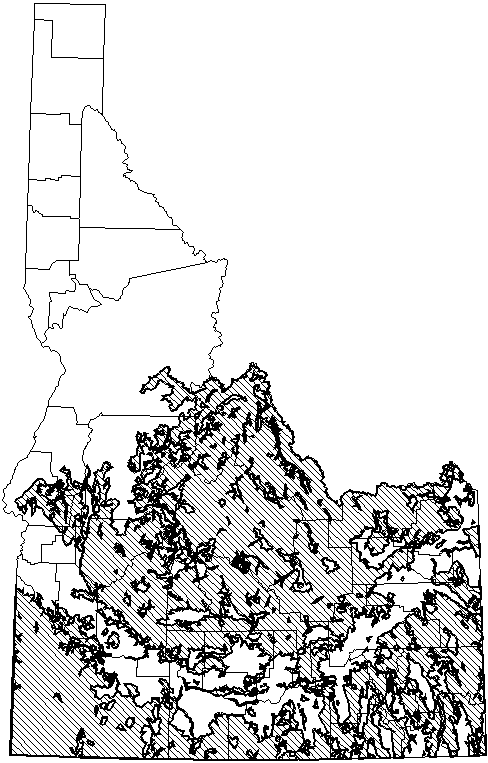
Tamias minimus
(Least Chipmunk)
Order: Rodentia
Order Description:Rodents
Family: Sciuridae
Family Description: Chipmunks, Marmots and Squirrels
Description:
As its name implies, this species is the smallest chipmunk and actually, the smallest member of the squirrel family. All chipmunks are striped on their backs; the least chipmunk has alternating light and dark stripes on its back and sides, and the outermost stripe on the side is dark. It is whitish to yellowish underneath and its tail has black-tipped hairs with a reddish undertone. The sides are often reddish brown. Total length is about 7 to 8.5 (187-212 mm) inches and an adult weighs about 1 to 1.9 (30-55 g) ounces. A behavioral trait that helps distinguish this species is that it tends to hold its tail in a vertical position when moving. It is very difficult to differentiate from the yellow-pine chipmunk.
Range:
From portions of western Canada, south through Rockies and northern Great Lakes region.
Habitat:
Found in various habitats. Common in coniferous forests, but may also be found in clearcuts, deciduous woods, sagebrush, jack pine stands, and riparian zones; in western regions may even occur in alpine tundra. In Idaho, found in sagebrush, juniper, and lower-elevation coniferous forests adjacent to sagebrush. It seems to favor sagebrush areas.
Diet:
Feeds mostly on seeds, nuts, fruits, and acorns. In Idaho, known to be omnivorous, feeding on plant seeds, foliage, and arthropods.
Ecology:
This species, as are all chipmunks, diurnal. They may be active throughout the day, but they prefer sunny midday hours. They hibernate and may aestivate. They begin semi-hibernation in late October, but may awaken on warm winter days, and are fully active by mid-March. In Idaho desert lowlands below 4000 feet (1200 m), there is some evidence that they aestivate in early July, and reappear in late August or early September (with autumn rains) before returning to winter hibernation. Build winter nests up to 1 m below ground surface. Highly favorable habitats may contain 30 or more per acre (0.4 ha), though average densities typically range from 5 to 15 per acre (0.4 ha). Home range varies from less than 1 acre (0.4 ha) to 4 acres (1.6 ha). They are preyed on by hawks, weasels, martens and red foxes.
Reproduction:
Breeds in early spring. Gestation lasts 31 days. litter size varies from 2-7 young (average 5-6). Female produces 1 litter; if that litter fails, she may produce another. Young become sexually mature in first spring.
Conservation:
| Status: | Unprotected nongame species |
|
Global Rank: |
G5 |
|
State Rank: |
S5 |
Important State References:
Laundré, J.W. 1989. Burrows of least chipmunks in southeastern Idaho. Northwest. Natur. 70:18-20.
Information written by Donald Streubel,© 2000
Map image provided by Stephen Burton,© 2000
Design by Ean Harker©1999, 2000.
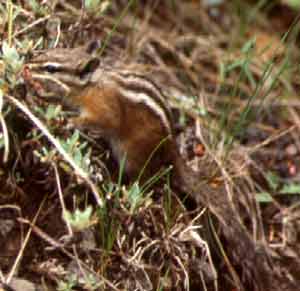
Tamias amoenus
(Yellow Pine Chipmunk)
Order: Rodentia
Order Description:Rodents
Family: Sciuridae
Family Description: Chipmunks, Marmots and Squirrels
Description:
One of the more brightly colored chipmunks, varying from tawny to a pinkish cinnamon color. This species is slightly larger than the least chipmunk, but is is similar in coloration. It has a tawny (sandy) color on the front of the ear, but this is difficult to observe. Its strips contrast quite sharply between white or slightly grayish and dark black stripes. The sides and underneath of the tail are brownish to yellowish. Total length is 8 - 9 inches. It weighs 1 to 2.2 ounces. It moves about its environment with less jerky, more deliberate movements than the least chipmunk and it doesn't carry its tail in a vertical position.
Range:
From central British Columbia, south to Wyoming and central California.
Habitat:
Found in chaparral and in open areas in coniferous forests (e.g., yellow-pine/Douglas fir forests). Found among logs, brush, and rocky outcrops, and in brushy borders between subalpine forests and alpine tundra. In Idaho, prefers open and semi-open coniferous forests. Idaho study found single-tree selection logging increased species' populations.
Diet:
Eats seeds, fruits, fungi, and some insects. An Idaho study indicated berries, seeds, and lichens were most important food items.
Ecology:
Hibernates late fall-early spring. Stores little energy as body fat; probably awakens periodically in winter to feed on stored seeds. May become lethargic during cold summer weather. Digs burrows 17-53 cm deep. May live up to 5 yr. Predators include hawks, weasels, and coyotes. An Idaho study reported densities from 6.9-36.5/ha.
Reproduction:
Breeds in early spring. litter size averages 5 (Washington) to 6 (California). In Washington Cascades, female produces 1 litter/yr. Young are born from mid-May to early June, are weaned in about 6 wk, first appear at surface in June (Washington Cascades), and first breed at 1 yr.
Conservation:
| Status: | Protected nongame species |
|
Global Rank: |
G5 |
|
State Rank: |
S5 |
Important State References:
Harris, C.E., J.W. Beals, and K. Geier-Hayes. 1994. Deer mouse and yellow-pine chipmunk density and food habits in three central Idaho shrub communities. Idaho Dept. Fish & Game, Boise. 23 pp.
Information written by Donald Streubel,© 2000
Map image provided by Stephen Burton,© 2000
Design by Ean Harker©1999, 2000.
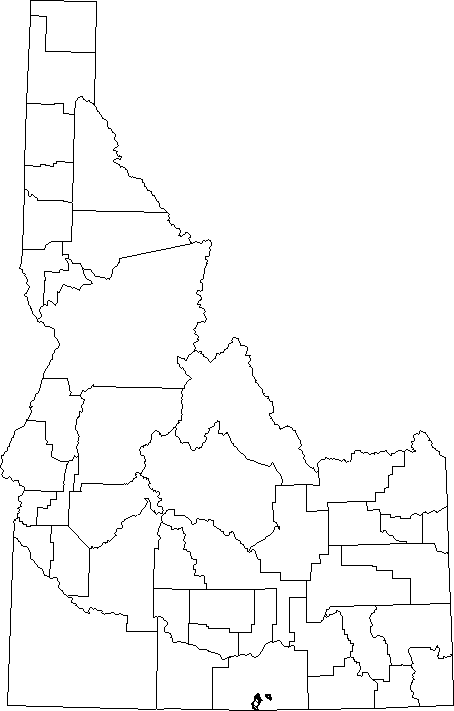
Tamias dorsalis
(Cliff Chipmunk)
Order: Rodentia
Order Description:Rodents
Family: Sciuridae
Family Description: Chipmunks, Marmots and Squirrels
Description:
The stripes of this species are quite indistinct or absent except for a dark center one. Stripes are slightly more observable on the sides of the head. Total length is about 8 to 11 inches and it weighs about [ insert weight here].
Range:
From southwestern United States to northern Mexico.
Habitat:
It usually is found in rocky pinyon/juniper woodlands and lower elevations of pine forests. Also found in higher-elevation Douglas-fir and Mexican pine. In Idaho, occurs only in pinyon/juniper stands in south-central part of state and primarily inhabits cliffs and rocky areas.
Diet:
Consumes wide variety of seeds, acorns, and fruits.
Ecology:
Most active in early morning and late afternoon. In Idaho, probably hibernates in winter like other chipmunks. May store food. Primarily terrestrial, but capable of climbing tree to forage for food. Little is known about ecology of this species. Its reported that they are loudly vocal with sharp, bark-like sounds. They hibernate but emerge on warm, winter days.
Reproduction:
Probably similar to other western chipmunks which breed in spring and produce 1 litter of altricial young each year.
Conservation:
| Status: | Protected nongame species |
|
Global Rank: |
G5 |
|
State Rank: |
S1 |
Information written by Donald Streubel,© 2000
Map image provided by Stephen Burton,© 2000
Design by Ean Harker©1999, 2000.
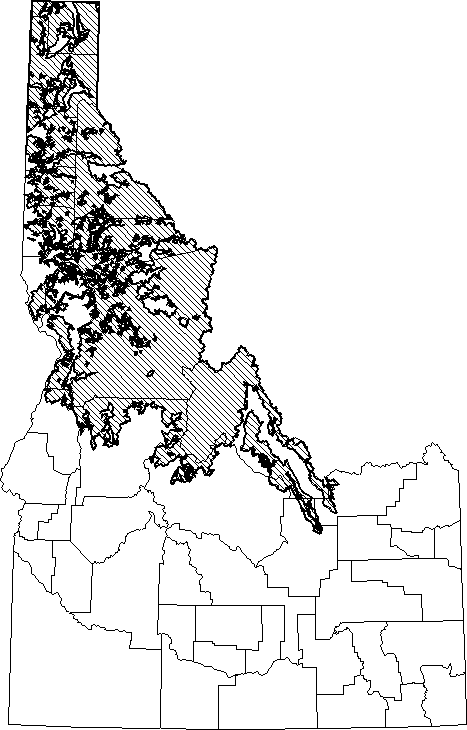
Tamias ruficaudus
(Red-tailed Chipmunk)
Order: Rodentia
Order Description:Rodents
Family: Sciuridae
Family Description: Chipmunks, Marmots and Squirrels
Description:
This is a fairly large chipmunk: total length is 8 ¾ to 10 inches (223-248 mm), tail length 4 to 4 ¼ inches (101-122 mm), and they weigh about 2 1/8 ounce (60 g). They are a tawny (sandy) color on their back and sides, their rump is gray, their tail is reddish above and dark reddish below. They have three median blackish stripes with brownish outer stripes on their back, and their cheeks have 2 white and 3 brown stripes.
Range:
From central Rocky Mountains in southern British Columbia and Alberta, south to northwestern Washington, northern Idaho, and western Montana.
Habitat:
Found in coniferous forests, including spruce/fir, cedar/hemlock, yellow pine, and (at timberline) alpine fir. Seems to prefer dense cover where range overlaps with yellow pine chipmunk. Idaho study indicated red-tailed chipmunks prefer mid-successional forests.
Diet:
Not a lot is known about their feeding habits or ecology, but they probably feed on seeds, fungi, and fruits.
Ecology:
Like most chipmunks they are probably inactive during the coldest part of the winter, waking periodically to feed from their food cache. They actively forage on the ground, but this species may climb trees more readily than other chipmunks.
Reproduction:
Probably similar to other western chipmunks which mate in spring and, following Gestation period of approximately 1 mo, produce a litter of altricial young.
Conservation:
| Status: | Protected nongame species |
|
Global Rank: |
G5 |
|
State Rank: |
S4 |
Important State References:
Scrivner, J.H. and H.D. Smith. 1984. Relative abundance of small mammals in four successional stages of spruce-fir in Idaho. Northwest Sci. 58:171-176.
Information written by Donald Streubel,© 2000
Map image provided by Stephen Burton,© 2000
Design by Ean Harker©1999, 2000.
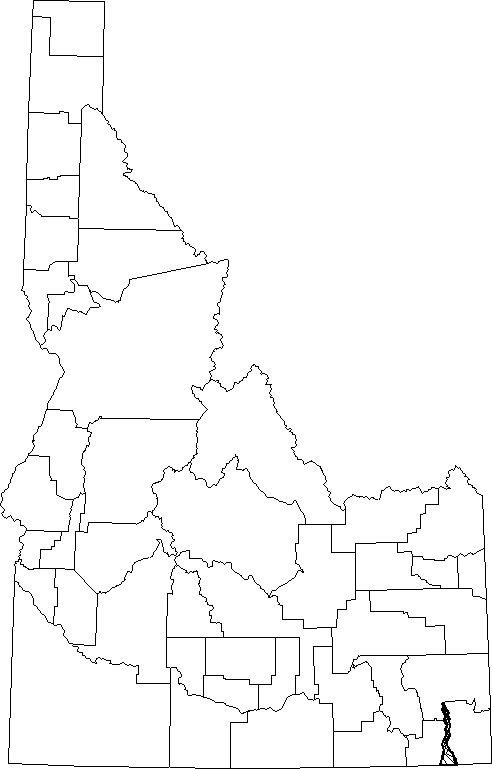
Tamias umbrinus
(Uinta Chipmunk)
Order: Rodentia
Order Description:Rodents
Family: Sciuridae
Family Description: Chipmunks, Marmots and Squirrels
Description:
The Uinta chipmunk is larger than the yellow pine and least chipmunks, and its back is generally darker. The outermost stripe is black in both the yellow pine and least, but it is lacking or very obscure in the Uinta chipmunk. The ears are blackish in front and white behind. Total length is 8 to 9 inches (200 225 mm), tail length is 3.5 to 4 inches (90-100 mm) and they weigh 1 to 2.2 ounces (29 62 grams).
Range:
Distributional records are disjunct, but in general, range extends from southwestern Montana south to northern Arizona, and from western Colorado into eastern California. In Idaho this species has not been documented widely, but it should be found along the southeastern edge of the state.
Habitat:
Found, at about 2000-3400 m, in coniferous forests, often near logs and brush in open areas, and at edge of forests.
Diet:
Feeds on seeds and berries supplemented with other plant material and insects. May occasionally eat birds' eggs and carrion.
Ecology:
Excavates burrows beneath rocks and shrubs. Dormant in winter in snow-covered areas; may appear above ground in warm weather on warm slopes, or may rouse and feed, but not leave burrow. Caches food.
Reproduction:
Probably similar to other western chipmunks which mate in spring and produce 1 litter of 4-5 altricial young following a Gestation period of approximately 1 mo. Young are weaned and foraging on their own in mid-July or August.
Conservation:
| Status: | Protected nongame species |
|
Global Rank: |
G5 |
|
State Rank: |
S1 |
Important State References:
Keller, B.L. 1986. Small mammal collections in Bear Lake, Bonneville, Cassia, Franklin, and Oneida Counties, Idaho: Final Report. Dept. Biol. Sciences, Idaho St. Univ. Pocatello. 7pp.
Information written by Donald Streubel,© 2000
Map image provided by Stephen Burton,© 2000
Design by Ean Harker©1999, 2000.
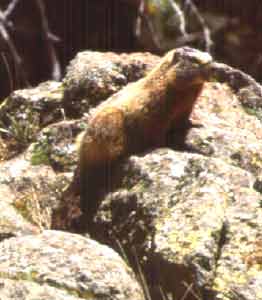
Marmota flaviventris
(Yellow-bellied Marmot)
Order: Rodentia
Order Description:Rodents
Family: Sciuridae
Family Description: Chipmunks, Marmots and Squirrels
Description:
This large, heavily bodied rodent is reddish-brown dorsally, often having a slightly frosted appearance due to light tipped hairs. Its belly is yellowish. It has small fur,covered ears and a prominent, erect tail. Total length is 20 - 28 inches (500 - 700 mm), tail length is 5 1/8 to 8 ¾ inches (130-220 mm), they weigh 3.5 - 11 pounds (1.6-5 kilograms). melanistic forms appear in various local populations of Idaho. Early settlers in Idaho called the marmot "whistle pigs", perhaps a good name since this marmot is fat appearing and it spends considerable time basking in the sun. If danger appears, however, it gives a shrill whistle as an alarm call. Many Idahoans also call them "rockchucks", a common name probably derived from the eastern "woodchuck" or "groundhog".
Range:
From south-central British Columbia and southern Alberta, south to southern California and northern New Mexico.
Habitat:
Found (typically above 2000 m) in meadows, valleys, and foothills, often in open areas where forest and meadow form a mosaic. In Idaho, prefers talus slopes, rocky outcroppings and rimrock.
Diet:
Feeds on wide variety of grasses and forbs.
Ecology:
At higher elevations, marmots may hibernate from early September to May; at lower elevations they emerge late February to mid-March. In more boreal zones, they may be active all summer, but begin aestivation in June at lower elevations. They burrow under rocks, logs, or bushes in areas of well-drained talus, rock outcrops, or scattered boulders. Their burrows may be up to 15 feet long and provide protection against predators, extremely high summer temperatures and cold temperatures during hibernation. The area over which they range varies from about 2.5 acres to 155 acres (1 ha to 70 or more). While they are social mammals, they occasionally live alone, but usually in pairs, or colonies. A colony typically consists of 1 or more adult territorial males and 1 to 5 adult females and their young. Most colonies do not exceed 1 male and 3 females. Small habitat patches may include a female and offspring, but adult males and yearlings may not be present. Virtually all males and slightly less than half of the females disperse from their natal colony, typically as yearlings. dispersal distance usually is less than 2.5 but up to 10 miles (4-15.5 km) for males, and 4 miles (6.4 km) for females. They may harbor fleas that are vectors of plague or ticks which transmit Rocky Mountain spotted fever. A primary mortality factor is hibernation and they are preyed on by larger predators such as golden eagles, coyotes, cougars and others.
Reproduction:
Mating usually occurs within 2 wk after hibernation. Gestation lasts about 30 days. litter varies between 3-8 young/yr. Young remain in burrow for 20-30 days, and emerge in late June to mid-July (Colorado). At highest elevations, females rarely produce litters in consecutive years. Males typically first breed at age 3 or older.
Conservation:
| Status: | Unprotected nongame species |
|
Global Rank: |
G5 |
|
State Rank: |
S5 |
Information written by Donald Streubel,© 2000
Map image provided by Stephen Burton,© 2000
Design by Ean Harker©1999, 2000.
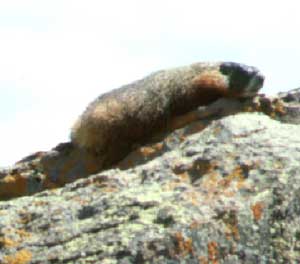
Marmota caligata
(Hoary Marmot)
Order: Rodentia
Order Description:Rodents
Family: Sciuridae
Family Description: Chipmunks, Marmots and Squirrels
Description:
The hoary marmot is quite large, with a silver-gray color above, a brownish rump and it is white underneath. It has black and white markings on its head and shoulders. Its tail is conspicuous, reddish-brown and quite bushy. Total length is nearly 18 to 32 ¼ inches (450-820 mm), its tail is 6 ¾ to 9 ¾ inches (170-250 mm), and its weights 8 to 20 pounds (3.6-9 kg).
Range:
From Alaska to Yukon, and south to Washington, northern Idaho, and western Montana. Idaho distribution is not well known, particularly along southern end of range.
Habitat:
Found on talus slopes and alpine meadows, often high in mountains near timberline. In Idaho, prefers rocky granitic habitats in subalpine and higher elevations.
Diet:
Diet consists almost entirely of grasses and other herbaceous plants.
Ecology:
Its silvery appearance provides good camouflage in its rocky habitat. Its burrows are large, 9 to 15 inches in diameter, and of course, it often burrows under rocks. Like most “ground inhabiting squirrels” it rapidly gains weight prior to hibernation. They hibernate from October through February in its southern range, from September to April in British Columbia. It gives off a loud, shrill whistle when disturbed that is louder than other marmots. They are preyed on by eagles and other carnivores that inhabit their range, plus they are occasionally dug up from their hibernation burrows by grizzly bears who emerge from hibernation earlier than the hoary marmots. In the northern part of their range (Canada and Alaska), their fur is used for parkas, and they are also consumed by humans for food.
Reproduction:
Mating occurs shortly after emerging from hibernation. A female gives birth to 4 to 5 young about a month after breeding.
Conservation:
| Status: | Unprotected nongame species |
|
Global Rank: |
G5 |
|
State Rank: |
S4 |
Information written by Donald Streubel,© 2000
Map image provided by Stephen Burton,© 2000
Design by Ean Harker©1999, 2000.
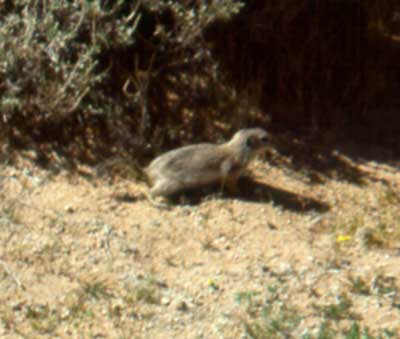
Ammospermophilus leucurus
(White-tailed Antelope Squirrel)
Order: Rodentia
Order Description:Rodents
Family: Sciuridae
Family Description: Chipmunks, Marmots and Squirrels
Description:
This ground squirrel holds its tail erect, almost over its back, when moving about its environment. This distinguishes it from other ground squirrels in Idaho. Its tail is distinctly white underneath, perhaps an adaptation that makes the tail an important signal to other ground squirrels close by. It is well established that deer, such as the white-tailed deer use their tail as a danger signal. Its upper body is buffy to cinnamon brown during the spring and summer, but tends to turn grayish in winter. It has a narrow white stripe on its side from its back to its hip. Their total length is about 7.5 to 9.5 inches 194-239 mm), tail length is 2 1/8 to 3 3/8 inches (54-87 mm) and they weigh 3 to 5 ½ ounces (85-156 g).
Range:
From southeastern Oregon and southwestern Idaho, south to Nevada, most of Utah, western Colorado, northwestern New Mexico, northern Arizona, eastern and southern California, and Baja California.
Habitat:
Found in low, dry, deserts and foothills, in sandy to rocky soil, in alkali sinks, and in shrub steppe with sagebrush, greasewood, shadscale, creosotebush, or sometimes juniper. In Idaho, restricted to salt-desert shrub communities (shadscale, halogeton).
Diet:
Omnivore. Eats green vegetation, seeds, insects, and carrion. May sometimes prey on small, live vertebrates. Diet changes seasonally with availability of various foods. In Idaho, known to feed primarily on shadscale and halogeton leaves and grass seeds.
Ecology:
They are not known to aestivate, but they may hibernate in the northern part of their range only. They are active throughout day even on extremely hot days. On hot summer days they may rest in shaded areas or in their burrow during hottest part of day. They are also known to rub saliva on their head, apparently attempting to cool themselves during extremely hot weather. In winter, they often bask in the sun. They may become torpid as a last resort if exposed to cold temperatures. They cannot survive indefinitely without free (drinking) water, but they are capable of acquiring water from their food. They store food and they may forage in trees or shrubs. Their burrows are often under a shrub but can be in the open, and they often use abandoned burrows of the kangaroo rat. They ay use multiple burrows over a period of a few weeks. They are primarily solitary. They do not maintain exclusive territories, but they form dominance hierarchies. In a southern Nevada study, their density ranged from 0.06 per 2.5 acres (1ha) in late spring, to 0.35 per 2.5 acres (1 ha) in fall, and their average home range was about 15 acres (6 ha). In Utah, their population density varied widely over time. They are well adapted to water conservation and desert life.
Reproduction:
In southern Nevada, breeds February-June with peak in February-March. In southern California, mating occurs mostly during first 2 wk of March. Gestation lasts 30-35 days in Nevada and California. litter size varies from 5-14 young (average 8). Female probably produces 1 litter/yr, possibly 2 in some areas. In southern California, young first appear on surface in mid-May, 1-2 wk before weaning at age 8 wk.
Conservation:
| Status: | Unprotected nongame species |
|
Global Rank: |
G5 |
|
State Rank: |
S4 |
Important State References:
Johnson, D.R. 1961. The food habits of rodents on rangelands of southern Idaho. Ecology 42:407-410.
Photos by David L. Chesemore ©2001
Information written by Donald Streubel,© 2000
Map image provided by Stephen Burton,© 2000
Design by Ean Harker©1999, 2000.
Spermophilus townsendii
(Townsend's Ground Squirrel)
Order: Rodentia
Order Description:Rodents
Family: Sciuridae
Family Description: Chipmunks, Marmots and Squirrels
Description:
This rather small ground squirrel is quite plain looking, appearing dappled gray above with an underside of white or buff. They have a rather short tail. This species can have a reddish tint on their face, hind legs, and the underside of their tail. Total length is 6.5 to nearly 11 inches (167-271 mm), tail length is 1 ¼ to 2 ¾ inches (32-72 mm), and they weigh 4 ½ to 11 ½ ounces (128-325 g).
Range:
From south-central Washington and southern Idaho, south to eastern Oregon, extreme eastern California, most of Nevada, and western Utah.
Habitat:
Found mainly in shrub steppe, in well-drained soils (especially on embankments), in sagebrush, shadscale, or greasewood. Often found around desert springs and irrigated fields. It may occur in dense populations in irrigated areas.
Diet:
Feeds mainly on herbaceous vegetation and seeds, but may also eat some shrub parts and animal matter. Will often feed on crops.
Ecology:
They hibernate and may aestivate. They emerge from dormancy (males before females) in late winter or early spring (in Idaho, in early spring when first green grass is available). They return to dormancy during May-July (early or middle July in Idaho), when grasses dry out; but they may have a separate period of activity in the fall. They are diurnal, but most active in the early morning. They dig an extensive burrow system and are known to use both shallow and deep burrows. Population density in a southern Idaho study was estimated at 3 to32 per 2.5 acres (1 ha), excluding juveniles. Their mean home range has been estimated at 1500 square feet (1357 m2). They may form colonies, but families and individuals live separately. Compared to other ground squirrels, they have high reproductive potential, but low adult survivorship. In Idaho, they are heavily preyed upon by both raptors and badgers within the Snake River Birds of Prey Area (BOPA). They are most likely preyed on by rattlesnakes and coyotes as well. Recent studies at the BOPA have investigated habitat, behavior, and parasites. Its been reported that Piute Indians in Nevada used them for food and they would travel miles to find populations of them. They are known to dig two burrows, a rather shallow one in feeding areas which probable serves as an escape burrow, and a much deeper and longer one that appears to be their nest burrow. Their burrow entrances usually have 4 to 6 inch piles of dirt surrounding them.
Reproduction:
Breeds from late January-early March, depending on locality. Drought may suppress breeding. Gestation lasts 24 days. Female produces 1 litter of typically 5-10 young/yr. Males mature as yearlings or as 2-yr olds; females breed as yearlings.
Conservation:
| Status: | Unprotected nongame species |
|
Global Rank: |
G5 |
|
State Rank: |
S5 |
Important State References:
Smith, G. and D.R. Johnson. 1985. Demography of a Townsend ground squirrel population in southwestern Idaho. Ecology 66:171-178.
Information written by Donald Streubel,© 2000
Map image provided by Stephen Burton,© 2000
Design by Ean Harker©1999, 2000.
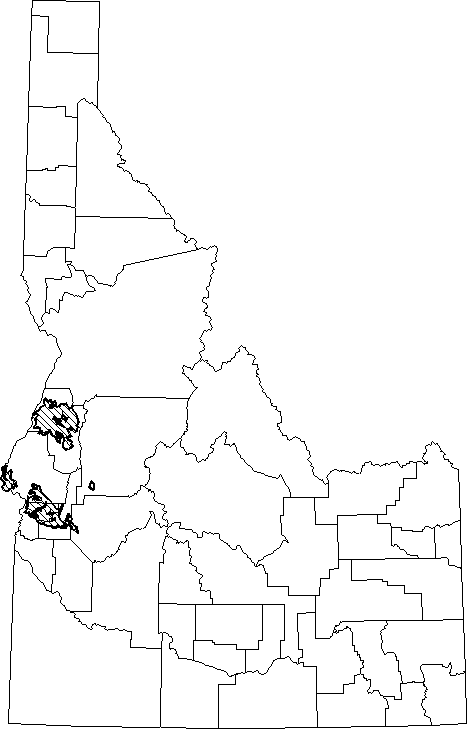
Spermophilus brunneus
(Idaho Ground Squirrel)
Order: Rodentia
Order Description:Rodents
Family: Sciuridae
Family Description: Chipmunks, Marmots and Squirrels
Description:
The Idaho ground squirrel resembles the Columbian ground squirrel, but is much smaller. It is vaguely spotted and grayish brown above, with its lower back mostly brown; underneath is is grayish to yellowish. Its shoulders and forelegs are a buff color, while its outer hindlegs and underside of the tail are rust brown. The tail has 5 to 8 alternating light and dark bands. It has a white chin and a rust-brown nose. Total length is 8 ¼ to 8 ¾ inches (211-220 mm), and its tail length is 1 ¾ to 2 inches (46-50 mm).
Range:
Endemic to 5-county area of west-central Idaho. Northern subspecies (brunneus) is presently known only from about 2 dozen isolated demes in Valley and Adams counties; these demes occur at mid-elevations (1150-1550 m). Southern subspecies (endemicus) occurs at lower elevations (670-975 m) north of Payette River in Gem, Payette, and Washington counties. Apparent extirpation has occurred in area between extant populations of northern and southern subspecies.
Habitat:
Northern populations are associated with shallow rocky soils in xeric meadows surrounded by ponderosa pine and Douglas-fir forests; southern populations inhabit low rolling hills and valleys now dominated by annual grassland with relict big sagebrush and bunch grasses. Species may occur on slopes and (rarely) ridges.
Diet:
Feeds on green vegetation and seeds.
Ecology:
Relatively little was known about this species until quite recently, and much is yet to be learned about it. The southern populations emerge in late January to early February and cease above-ground activity in late June-early July; the northern populations are active above ground from late March-early April until late July-early August. Activity is restricted by time of the spring snow melt and vegetation desiccation (drying) in mid to late summer. Individuals dig burrows; entrances are often under rocks and logs. Burrows are extensive in shallow, rocky soils, but nest burrows are located in adjacent areas with deeper (greater than 1 m), well-drained soils. Indiscriminate shooting and poisoning are continued threats to the species and because of its small population and restricted range, the long-term future of its populations may be precarious.
Reproduction:
Not much is known about its reproduction, but Gestation probably lasts about 25 days. Females produce 2-10 young.
Conservation:
| Status: | Unprotected nongame species |
|
Global Rank: |
G2 |
|
State Rank: |
S2 |
Important State References:
Yensen, E. 1991. Taxonomy and distribution of the Idaho ground squirrel, Spermophilus brunneus. J. Mammal. 72:583-600.
Information written by Donald Streubel,© 2000
Map image provided by Stephen Burton,© 2000
Design by Ean Harker©1999, 2000.
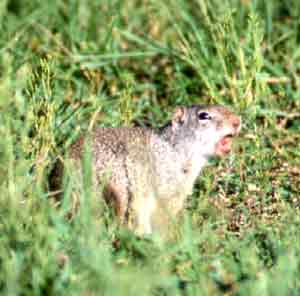
Spermophilus armatus
(Uinta Ground Squirrel)
Order: Rodentia
Order Description:Rodents
Family: Sciuridae
Family Description: Chipmunks, Marmots and Squirrels
Description:
The Uinta ground squirrel has a grayish back and rump with fine white spots on its back. Its nose and shoulders are tan to cinnamon, and its tail is grayish underneath and tan or buffy on top. The tan/buff color on the tail helps distinguish it from the Townsends ground squirrel, and it is larger. Total length is 11 to 12.3 inches (62-81 mm), tail length is 2.5 to 3.2 inches (62-81 mm) and weight is 6.9 to 10.4 ounces (195-295 grams).
Range:
Southern Montana, southeastern Idaho, western Wyoming and north-central Utah.
Habitat:
Found in dry meadows, pastures, and cultivated fields, usually near water. May also be found in montane grasslands to timberline(about 11,000 feet).
Diet:
They feed on a wide variety of green vegetation and seeds, as well as some small invertebrates and vertebrates. They can occasionally be observed feeding on road-killed ground squirrels from their own colony.
Ecology:
This species Hibernates and may aestivate in hotter, drier parts of their range. They are usually active from spring through late summer (approximately April-August), are dormant during fall and winter. They dig underground burrows and are colonial, but they are notably intolerant of kin. It appears that females establish territories around their nest burrows. This ensures a good source of grasses and other plants for food for the mother and her young, and it may help protect the young. Once young emerge from the nest burrows they receive little care from their mother and they quickly disperse. Female young usually don't disperse very far, they often establish their home burrow near their mother. Males tend to disperse greater distances and establish territories and mark territories by rubbing the ground with their necks which helps spread glandular secretions form the sides of their neck. When the young are dispersing, they experience high mortality rates; up to 80% mortality in their first year of life. Badgers are common predators as are weasels, coyotes, and various raptors. They frequently can be observed in an upright alert posture, standing only on their hind legs and supported by their tail. Early settlers called them (and other ground squirrels) "picket pins". They were called so because they frequently stand upright in alert postures, and from a distance travelers in a wagon train would see what looked like a stake driven into the prairie, which they thought was s picket pin left by a previous part for picketing their horses at night. Often the "picket pin" would disappear as it dove into its burrow at the approach of the pioneers.
Reproduction:
Breeding occurs about two weeks after emergence from hibernation in the spring. Females produce 1 litter of 4 to 6 altricial young per year. Gestation is 28 days, young are usually born in April. The young emerge from the nest burrow 4 to 5 weeks after birth. Females are territorial around nesting burrows.
Conservation:
| Status: | Unprotected nongame species |
|
Global Rank: |
G5 |
|
State Rank: |
S4 |
Information written by Donald Streubel,© 2000
Map image provided by Stephen Burton,© 2000
Design by Ean Harker©1999, 2000.
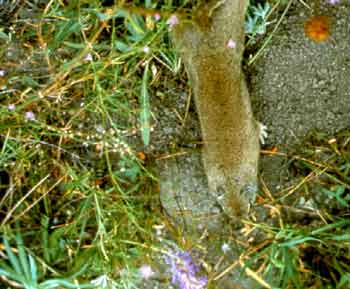
Spermophilus beldingi
(Belding's Ground Squirrel)
Order: Rodentia
Order Description:Rodents
Family: Sciuridae
Family Description: Chipmunks, Marmots & Squirrels
Description:
Belding's ground squirrel is gray with reddish to pinkish above, and is distinguished from other ground squirrels by a broad, brown streak running down the back. Their tail is gray with a pinkish cast above, and reddish below with black-tipped hairs; that appears somewhat bushy. Total length is 10 to nearly 12 inches (253-300 mm), tail length is 2 ¼ to 3 inches (55-76 mm), and their weight is 8 to 12 ounces (227-340g).
Range:
From eastern Oregon, south through northeastern California, southwestern Idaho, north-central Nevada, and extreme southeastern Utah.
Habitat:
Usually found in fairly open habitat. Inhabits alpine and subalpine meadows, shrub steppe, grasslands, and pastures and croplands.
Diet:
They feed primarily on grass, leaves of meadow plants, and seeds. Their diet may be less varied than that of other ground squirrels, but they are also known to occasionally eat birds eggs, insects such as grasshoppers, crickets and caterpillars.
Ecology:
They are active for longer periods during the spring and summer than ground squirrels that live in more arid habitats at lower elevations. They hibernate from late September to May or June. They dig underground burrows, or as documented in Idaho, they select used burrows. They live in colonies. In a California study, population density estimates varied from 1.2 per 2.5 acres (1ha.) in an alpine meadow, to well over 100 per 2.5 acres (1ha.) in an alfalfa field. High population densities may damage range grass and like other ground squirrels they may carry bubonic plague. They are preyed on by coyotes, hawks, snakes, badgers, and weasels. Interesting altruistic behavior has been observed in Belding's ground squirrels. As a predator approaches, the first individual to sight the predator typically gives an alarm call. Research has shown that the caller is at a higher risk of being preyed on by bringing attention to itself. However, this self-sacrifice or altruism, increases their relatives' chances for survival because their relatives, being closest to them, are the first to hear the alarm call. Research in California has also shown that yearling males and adult females occasionally kill and eat juveniles, a behavior that is difficult to explain.
Reproduction:
Breeding occurs shortly after hibernation. Gestation lasts 23-28 days. Female reportedly produces 1 litter of 4-12 young, or average of 8 young per/litter. Individuals reach sexual maturity in 2 yr.
Conservation:
| Status: | Unprotected nongame species |
|
Global Rank: |
G5 |
|
State Rank: |
S4 |
Important State References:
Hansen, R.M. 1954. The Belding ground squirrel north of the Snake River in Idaho. J. Mammal. 35:587.
Information written by Donald Streubel,© 2000
Photos by Bruce Eshelman, © Aug 1979, 2001
Map image provided by Stephen Burton,© 2000
Design by Ean Harker©1999, 2000.
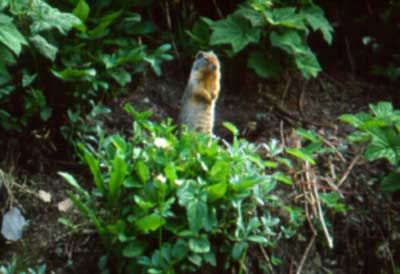
Spermophilus columbianus
(Columbian Ground Squirrel)
Order: Rodentia
Order Description:Rodents
Family: Sciuridae
Family Description: Chipmunks, Marmots and Squirrels
Description:
Columbian ground squirrels tend to be grayish mixed with black on top with non-distinct buff spots. The front of their face, their front legs and their belly are all a reddish, rust brown. Their front feet are buff colored. They have a bushy tail that is reddish brown, but is has white with black mixed in on the periphery of the tail. They are larger than most ground squirrels: total length is 12 7/8 to over 16 inches (327-410 mm), tail length is 3 to 4 ¾ inches (77-120 mm), and they weigh 12 to 28 ounces (340-812 g).
Range:
From southeastern British Columbia and southwestern Alberta, south through northern and eastern Washington, northeastern Oregon, northern and central Idaho, and western Montana.
Habitat:
Found, from about 200-2400 m, in open habitat such as high grass plateaus, valley grasslands, meadows, clearcuts, coniferous forests, and stream banks. This species is not tolerant of dry conditions like many of the other ground squirrels are.
Diet:
Feeds on wide variety of vegetation such as roots, bulbs, stems, leaves, seeds, and berries. Also eats some animal food (e.g., insects, mice, and dead fishes.
Ecology:
Spends about 70% of year in hibernation. Hibernates from July-October and emerges from February-April, depending on elevation. In Idaho, June is height of activity for females. Individuals are diurnal; in spring/summer, activity occurs from about 20 min after sunrise to about 10 min after sunset. Typically constructs burrow in friable or sandy soils in open ground or bank under boulder or log. Population density of 32-35/ha has been reported for central Idaho and Alberta; 25-62/ha on agricultural lands in Washington. density is generally uneven over large areas. Species is colonial. In southwestern Alberta study, intercolony yearling males dispersed usually less than 4 km (but up to 8.5 km). Average home range of adult male was about 0.4 ha, adult female about 0.1 ha. Adult males defend (primarily during breeding season) core areas within home range. Adult females defend territory near nest burrow and exhibit strong site fidelity.
Reproduction:
Mating occurs soon after females emerge from hibernation. Gestation lasts 24 days. Female produces 2-7 (average 2-4) altricial young born May-late June. Nursing period usually lasts about 30 days. Young reach sexual maturity in 1-2 yr; 22-33% survive to maturity.
Conservation:
| Status: | Unprotected nongame species |
|
Global Rank: |
G5 |
|
State Rank: |
S5 |
Important State References:
Elliott, C.L. and J.T. Flinders. 1980. Seasonal activity pattern of Columbian ground squirrels in the Idaho Primitive Area. Great Basin Natur. 40:175-177.
Information written by Donald Streubel,© 2000
Map image provided by Stephen Burton,© 2000
Photos by David L. Chesemore ©2001
Design by Ean Harker©1999, 2000.
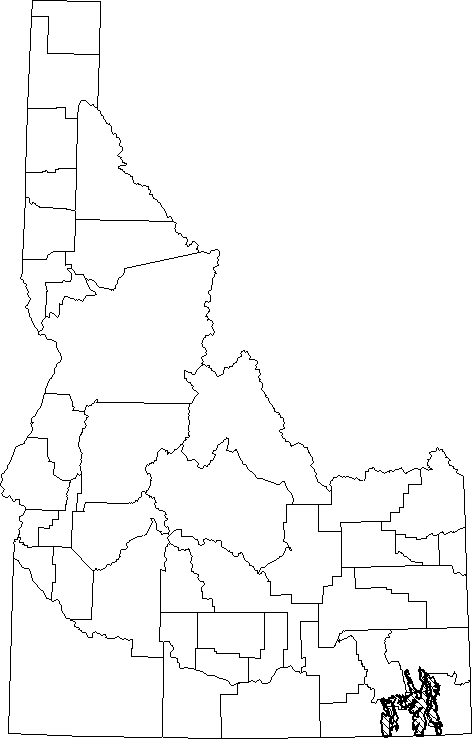
Spermophilus variegatus
(Rock Squirrel)
Order: Rodentia
Order Description:Rodents
Family: Sciuridae
Family Description: Chipmunks, Marmots and Squirrels
Description:
The rock squirrel is the largest of Idaho ground squirrels, with a total length of over 16 to nearly 21 inches (430-525 mm). Its long total length is due to the very long, bushy tail of almost 7 inches to nearly 10 inches (172-252 mm) long. Adults weigh 21 to 28 ounces (600-800 g). It also has large ears for a ground squirrel. Its body is grayish brown in front and reddish brown in back. Its tail is mottled buff and brown with a white edge. Because of its size and long, bushy tail, there is no other ground squirrel in Idaho that resembles it. Furthermore, it has a very limited distribution only in extreme southern Idaho.
Range:
From southeastern Nevada, Utah, Colorado, and extreme western Oklahoma, south through southwestern U.S. to portions of Mexico.
Habitat:
Found, up to 2900 m, in rocky habitats such as cliffs, canyons, hillsides, talus slopes, old buildings, bridges, terraced roads, and stone walls. Usually not present in open plains, wide valleys, deserts, or high montane forests. In Idaho, occurs in open canyons with bigtooth maple, narrowleaf cottonwood, mountain mahogany, box elder, and mountain shrubs. Generally, it is a species of broken, rugged canyon country.
Diet:
Feeds on nuts, seeds, grains, berries, roots, green vegetation, cacti, invertebrates, and fresh and dried meat. Diet depends on availability of foods.
Ecology:
It is active all year except at high elevations. In Idaho, the length of hibernation depends on severity of weather, but it may hibernate up to six months. Its summer activity peaks in the morning and again in the late afternoon. Activity during the spring, fall, and winter peaks at midday. A southeastern Arizona study reported relatively inactive adults from late October-February; juveniles were active throughout autumn. This species burrows under rocks, bushes, and trees; spends most of life underground. It tends to be colonial at breeding time with female aggregations and a dominant male, with subordinate males nearby. Large home ranges overlap greatly; some studies found average to be less than 1 ¼ acres (0.5 ha), but a radiotelemetry study in southeastern Arizona found spring and summer home range averaged about 20 acres (7.9 ha) for males, and 9 ½ acres (3.8 ha) for females; the same values were reported for populations in central New Mexico. One study found population density of about 2 to 13 per 2.5 acres (1 ha). density of adult residents was less than 2 per 2.5 acres (1 ha) in central New Mexico.
Reproduction:
Mating occurs mid-April to early July (Arizona). Gestation probably lasts about 30 days. Birth of young occurs April-August. Percentage of lactating females peaked July-August in Arizona. Lactation lasts about 2 mo and an average of 4 young emerge from natal burrow (in July at 1500 m. in Arizona). Females produces 1 litter/yr (possibly 2 in south). The males of most ground squirrel species emerge from hibernation immediately capable of breeding. That is not the case with rock squirrels; after they emerge from hibernation, they are active about 2 weeks before they are capable of breeding.
Conservation:
| Status: | Protected nongame species |
|
Global Rank: |
G5 |
|
State Rank: |
S1 |
Important State References:
Groves, C., E. Yensen, and E.B. Hart. 1988. First specimen record of the rock squirrel (Spermophilus variegatus) in Idaho. Murrelet 69:50-53.
Information written by Donald Streubel,© 2000
Map image provided by Stephen Burton,© 2000
Design by Ean Harker©1999, 2000.
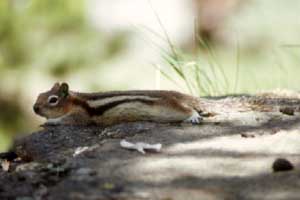
Spermophilus lateralis
(Golden-mantled Ground Squirrel)
Order: Rodentia
Order Description:Rodents
Family: Sciuridae
Family Description: Chipmunks, Marmots and Squirrels
Description:
This species is the only ground squirrel in Idaho with distinctive stripes on its sides. They have one broad white stripe bordered on each side by a black stripe; they have three stripes, black, white, black on each side. Their back is grayish to brownish. Adults have a reddish brown color on their head and shoulders, their "mantle". Total length is 9.2 to 12.2 inches (230 - 305 mm), weight is 7.4 to 11 ounces (210-315 grams). The stripes make many observers confuse them with chipmunks, but the fact that the stripes do not go through the eyes on the sides of the face distinguishes them from chipmunks. The stripes on chipmunks do go through the eyes. Males are usually more brightly colored than females.
Range:
From eastern British Columbia and western Alberta, south through western U.S. to California, Arizona, and New Mexico.
Habitat:
Found, from intermediate elevations to alpine tundra, on mountain slopes and foothills, in chaparral, in open areas in pine, spruce, and fir forests, and on rocky outcroppings and slides.
Diet:
Feeds on seeds, fungi, leaves, flowers, fruits, and roots. Will also eat arthropods and meat. One study reported underground fungus comprised 65% of summer food and 90% of fall food.
Ecology:
In Canada, they may begin to hibernate in early September; males emerge in mid-April. In California, they may remain active until late November; males reappear in March. In Idaho, they are active from March to September, then hibernates for the winter. Like all ground squirrels, they are diurnal, but are typically inactive during the heat of the day in the summer. They may store food in their burrows, which they carry in their cheek pouches. Burrows may be located under rocks, logs, or bushes and may be up to 100 feet long. While many ground squirrels are colonial, this species is not. Populations are usually distributed evenly over good habitat. In Idaho, this species is scattered in numbers but locally abundant, especially in campgrounds and picnic areas where they become tame and acclimated to human food.
Reproduction:
Breeding occurs in spring soon after females emerge from hibernation. Females are monoestrus. litter size varies from 2-8 young (usually 4-6). Young typically emerge from burrow in July (in Idaho, young are born in June or July).
Conservation:
| Status: | Protected nongame species |
|
Global Rank: |
G5 |
|
State Rank: |
S5 |
Information written by Donald Streubel,© 2000
Map image provided by Stephen Burton,© 2000
Design by Ean Harker©1999, 2000.
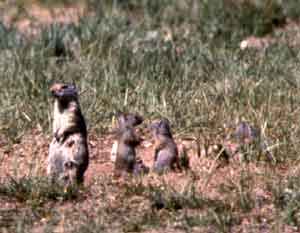
Spermophilus elegans
(Wyoming Ground Squirrel)
Order: Rodentia
Family: Sciuridae
Family Description: Squirrels, Marmots, and Chipmunks
Description:
The Wyoming ground squirrel has ears that appear bigger than the typical ground squirrel, a fairly long tail that is light brown underneath and is edged with a light tan, it is grayish to light drab above with buffy flecks, and its belly is a dark cinnamon color. It can be distinguished from the Uinta ground squirrel by its light brown underside of the tail, (the Uinta has a gray undersided tail).
Range:
This ground squirrel is found in three distinct populations. Subspecies occur in 3 areas that are probably geographically isolated: extreme southeastern Oregon, southwestern Idaho, and north-central Nevada; northeastern Idaho and southwestern Montana; and extreme northeastern Utah, southern Wyoming, northern Colorado, and extreme western Nebraska. This species was recently separated from the Richardson's ground squirrel which is not found in Idaho.
Habitat:
Found in grasslands and sagebrush, especially on upland slopes with loose, sandy soils.
Diet:
Feeds on seeds, flowers, stems, leaves, roots of grasses, forbs, and shrubs. Will also eat insects, especially in late summer. Sometimes eats carrion.
Ecology:
They emerge from hibernation in early spring. After an active spring and summer, they become dormant again between late July and early September. Males enter hibernation first, then females and young, a pattern found in other ground squirrels. In a north-central Colorado study, adult males emerged in March, about 2.5 weeks before females. Population densities may reach 10-20 per 0.4 ha. This species is one of least social ground squirrels, but when it does occur in large colonies, home range may be restricted to 7.6-15 m in diameter. They, along with other ground squirrels, may host fleas that transmit bubonic plague and they are also known to host the Colorado tick fever virus. They are known to be vocal, warning others of approaching predators or other danger. Predators include coyotes, foxes, badgers, hawks and others. Because they can host diseases and they can become a nuisance in certain crops, they are subjected to strong control efforts by ranchers and farmers. Survival of young from one year to another is often less than one out of four.
Reproduction:
Mating occurs soon after emergence from hibernation, usually about 5 days after females emerge. Females emerge from hibernations about 2 weeks after males. Gestation probably lasts 22-23 days. Females produce 1 litter/yr of 1-11 (usually 6-7) altricial young. In northern Colorado study, parturition occurred in late April or early May, and juveniles appeared above ground in late May or early June. Young reach adult size by end of summer. The northern Colorado study reported successful breeding by yearling females may, in some years, be prevented by late emergence and low body mass attributable to deep snow and low temperatures.
Conservation:
| Status: | Unprotected nongame species |
| Global Rank: | G5 |
| State Rank: | S4 |
Information written by Donald Streubel,© 2000
Map image provided by Stephen Burton,© 2000
Design by Ean Harker©1999, 2000.

Tamiasciurus hudsonicus
(Red Squirrel)
Order:Rodentia
Order Description:Rodents
Family: Sciuridae
Family Description: Chipmunks, Marmots and Squirrels
Description:
The red squirrel, also known as the chickaree, is brownish red to rust red on its upper half with a white ventral side separated from the top by a dark stripe. It has a light colored eye ring which is easy to see when observing the squirrel, and its tail is bushy but not large and prominent like those of other tree squirrels, the outer edge of the tail has a black band edged with white. Behaviorally, it is quick and energetic with jerky and very busy movements.
Range:
From Alaska, east to Newfoundland, south to Smoky Mountains, and south through Rocky Mountains to Arizona and New Mexico.
Habitat:
The red squirrel is found throughout the northern boreal forest across Canada and the northern tier of states, much like the northern flying squirrel. They prefer coniferous and mixed forests, but is frequently found in deciduous woodlots, hedgerows, and second-growth areas. Ideal habitat seems to be spruce-fir forests, and the seeds in spruce cones especially are preferred. In Idaho, found in all coniferous forests, mixed forests, and riparian woodlands adjacent to conifers. Young are typically forced into marginal, deciduous forests such as aspen in Idaho.
Diet:
They commonly eat seeds of conifer cones, nuts, fungi, and fruits. Their propensity to eat conifer seeds is a hallmark of their activity and influence on forest ecosystems. They occasionally feed on invertebrates. Recent research in Canada documented that they prey on bird eggs, young birds and even on newly born snowshoe hares.
Ecology:
Like most tree squirrels they are diurnal with peak activity in morning 2 hours after sunrise and evening before sunset. They are usually conspicuous throughout day. They are capable climbers and can easily leap from limb to limb. Because they do not hibernate they store food for the winter. During a 4 to 6 week period in the fall, spruce, fir, and pine cones are fully developed and the seeds in the cones are mature. Red squirrels cut cones from conifer trees and cache them in storage areas called middens. The middens, often 15 by 30 feet or even larger, are formed over numerous years by continuous storage and feeding activity. As the midden owner feeds, rapidly extracting the numnerous seeds from each cone with its teeth, the cone bracts are stripped off and fall onto the midden. Many middens have a 12 inch layer of cone bracts on top of moist soil. This medium provides an ideal location for the storage of many cones in holes and depressions dug into the midden. Red squirrels also store cones in small depressions in the ground away from their middens, Red squirrels do all of their storing of cones during a 4 to 6 week period in the early fall. If the cones are not cut from the tree during a critical period when the seeds are fully developed, the bracts of many cones open and the seeds are dispersed by the wind. If they are cut from the tree and left lying on the ground, the cones dry out and open up, again allowing the seeds to disperse. Squirrels prevent this by storing the cones they cut in their moist caches or middens, where they are tightly packed into holes like dill pickles in a jar. Middens tend to be near the center of the squirrel's territory, which is about .5 to 1.5 ha (1 to 4 acres). Red squirrels may be the most territorial mammals in Idaho. During the fall cone cutting and storing creates a flurry of activity that can result in the storage of up to 20,000 cones. Squirrels will cut cones from near the tops of trees for 5 or 6 minutes, then descend and carry them into their middens. They rarely carry cones farther than 30 yards from their middens. Cone crop failures often force the squirrels to use year old or older cones from their stores, but only the larger middens seem to hold more than one winter's supply of food. The red squirrel's territorial call is easy to hear and consists of a long churr---of 1 to 4 seconds duration. Similar to territorial songs in birds, the squirrel's call advertises its presence in its territory. Failure to periodically call usually results in an invasion of territory by a neighboring squirrel. This behavior is most pronounced during the fall food storing period, but it also continues throughout the year. They commonly cache more food than it can consume in a winter, which leaves cones for the next year in case of a cone crop failure. Early foresters in Idaho would collect cones and their seeds from red squirrel middens for their tree nurseries. This cone storing behavior also has economic value in seed dispersal in forests. Population densities range from about 1/3.2 ha (Pinaleno Mountains, southeastern Arizona) to 1/0.2 ha. More territorial than most other North American tree squirrels. Populations in British Columbia are limited by food (acting through effect on reproduction). Red squirrels are ecologically connected to grizzly bears in Idaho. Red squirrels at higher elevations collect and store whitebark pine cones in their middens. In the fall grizzlies seek out these middens where they eat the whitebark seeds from the cones stored by the red squirrel. Of course that is tough on the red squirrel who spent a great deal of energy storing up its own winter food supply. But they cannot argue with a grizzly bear.
Reproduction:
Breeds March-April and June-July. Female is in estrus only for 1 day. Gestation lasts 31-35 days. Some females produce 2 litters/yr. litter size averages 4-5 young. Some females breed when less than 1 yr old.
Conservation:
| Status: | Protected nongame species |
|
Global Rank: |
G5 |
|
State Rank: |
S5 |
Important State References:
Medin, D.E. 1986. The impact of logging on red squirrels in an Idaho conifer forest. West. J. Appl. Forestry 1:73-76.
Information written by Donald Streubel,© 2000
Map image provided by Stephen Burton,© 2000
Design by Ean Harker©1999, 2000.
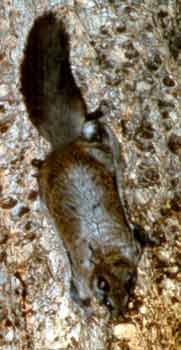
Glaucomys sabrinus
(Northern Flying Squirrel)
Order: Rodentia
Order Description:Rodents
Family: Sciuridae
Family Description: Chipmunks, Marmots and Squirrels
Description:
The northern flying squirrel is yellowish-buff to soft gray dorsally and grayish-white ventrally. Its large, flattened tail is dark at the tip and it can easily be identified by the prominent haired skin folds (the patagium) that extend from the front legs to the back legs on each side. This fold of skin, plus the large, flattened tail, provide the surface that allows it to glide from the tops of trees to lower points in its habitat. When they launch themselves to glide, they spread their legs to stiffen the patagium. Their tail serves as a rudder. It has large prominent eyes which accommodate its nocturnal habits.
Range:
From Alaska, east through most of Canada, and south in Rockies, Great Lakes Region, and Appalachians.
Habitat:
They prefer coniferous and mixed forests, but will utilize deciduous and riparian woods. Optimal conditions consist of cool, moist, mature forest with abundant standing and downed snags. Watch for conifer trees with woodpecker holes. Often, tapping on the tree will cause a flying squirrel to peer out if it is present.
Diet:
Their diet consists of both plant and animal material. In Idaho, they eat seeds, fruits, nuts, berries, fungi, insects, birds' eggs and nestlings, buds, and meat. They also chew bark on trees to increase the flow of sap which provides them another source of food.
Ecology:
Flying squirrels are not true fliers, but they launch themselves from the tip of a large tree and glide downward for some distance to the base of another tree or to the ground. This is their primary means of escaping predators. These squirrels are nocturnal. In the southern Appalachians, they show a peak in activity from sunset to 2 hours after and 1 hour before sunrise. They occupy tree cavities, leaf nests, caves, and underground burrows; in Alaska they use a large number of alternate den sites. They are active throughout the year but in winter they typically nest in tree cavities. Even though they appear to be clumsy on the ground, they spend considerable time foraging on the ground. They are highly social, especially in winter when nests may be shared. Because their gliding makes them quite mobile, home range seems quite large, estimated at 2-3 ha in North Carolina, and 5-7 ha in West Virginia. They live in family groups of adults and juveniles. They are preyed upon by hawks, owls, and mammalian carnivores such as martens, weasels and foxes.
Reproduction:
In Idaho, their breeding season occurs from February-May, Gestation lasts 37-42 days. Females produce 1-2 litters of 2-6 young (average 4-5), but one litter seems the norm in Idaho. After a gestation period of 37 to 42 days, the young are born in March-early July, Their young are weaned at about 2 mo, and reach sexual maturity at 6-12 months. However, the your may remain with the mother for most of the year, apparently until the next breeding season. This represents a difference from other tree squirrels where the young typically leave the mother shortly after being weaned.
Conservation:
| Status: | Protected nongame species |
|
Global Rank: |
G5 |
|
State Rank: |
S4 |
Important State References:
Laurance, W.F. and T.D. Reynolds. 1984. Winter food preference of capture-reared northern flying squirrels. Murrelet 65:20-22.
Information written by Donald Streubel,© 2000
Photo from Yellowstone- National Park Service, Mar 2001.
Map image provided by Stephen Burton, 2000
Design by Ean Harker 1999, 2000, 2001.
